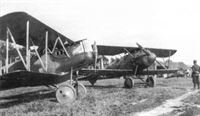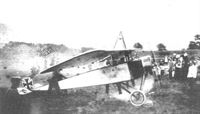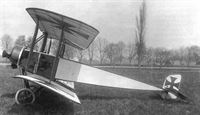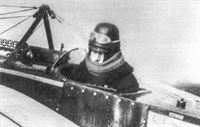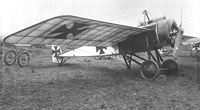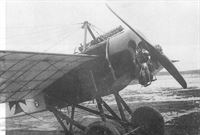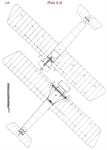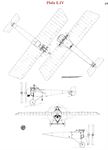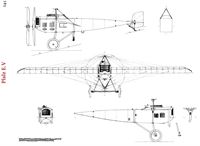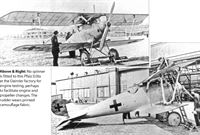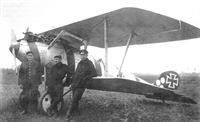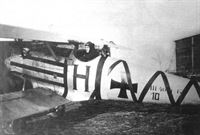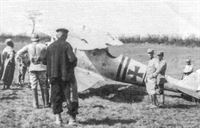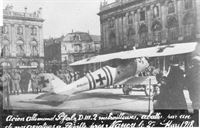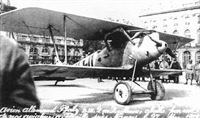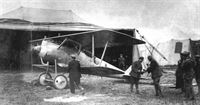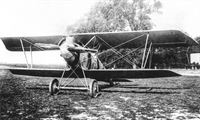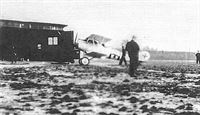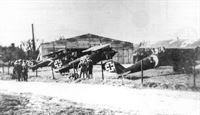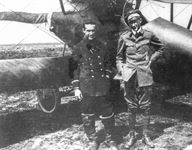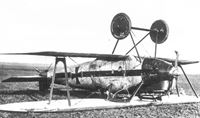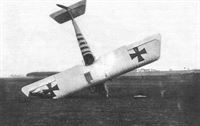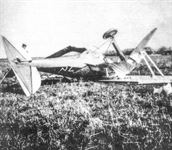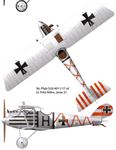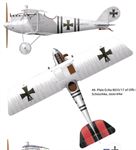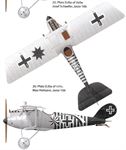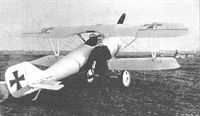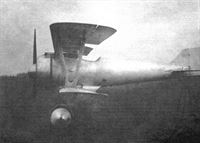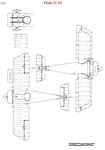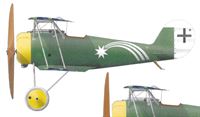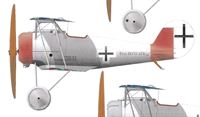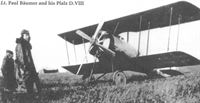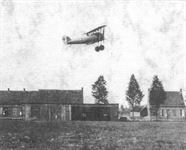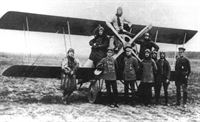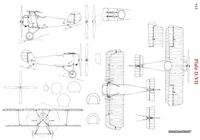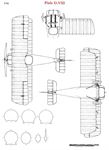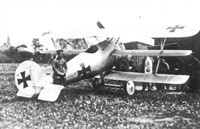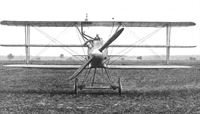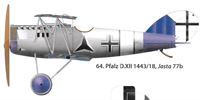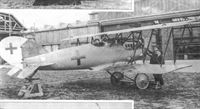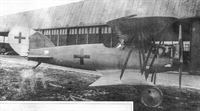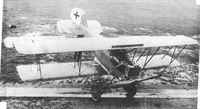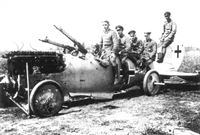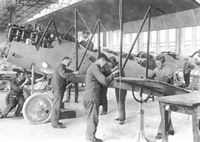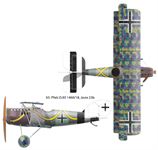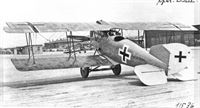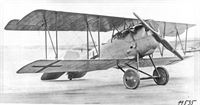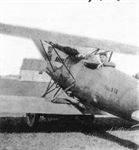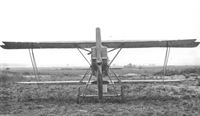Книги
Centennial Perspective
J.Herris
Pfalz Aircraft of WWI
563
J.Herris - Pfalz Aircraft of WWI /Centennial Perspective/ (5)
Pfalz D.XII 2695/18 in late-style camouflage with crosses obscured is in Allied hands postwar; a Sopwith Camel is in the background in the top photo. Barely visible is the zig-zag vertical band on the fuselage.
A Pfalz E.II heads a lineup including two Fokker E.IIIs, a Pfalz A.II, and an Ago C.I (or C.II) of Feld-Flieger Abteilung 9b.
Three rare aircraft are captured in this photo. A Pfalz E.VI in the foreground was hand painted with lozenge patterns to test a new camouflage system; it retains the national insignia on the elevators. The Pfalz E.V Typenprufung machine in the background dates this photo to July 1916. Directly behind the E.VI is Albatros C.IV C.850/16 as can be determined by its distinctive wing and interplane struts.
Jasta 15 lineup with a mixture of Pfalz D.III and Albatros D.V aircraft.This is a significantly earlier view of Jasta 15, before Rudolf Bertold took command, possibly January 1918. "N" is the Pfalz D.III of Lt. Claus von Waldow. The Albatros D.V with the skull marking was apparently flown by Lt. Karl Albert.
Pfalz D.IIIa and Albatros fighters line up at Flugplatz Awoingt, March 1918. Jasta 10 is in the foreground and Jasta 4 is in the background.
Pfalz D.IIIa lineup of Jasta 30 at Flugplatz Phalempin. The DFW C.V hack has Jasta 30's orange diamond marking.
A Fokker E.II (foreground) with Pfalz E.I 215/15 and a Pfalz E.II in the background provides an opportunity to compare the fighters. Allied airmen rarely, if ever, distinguished the Pfalz E-types from the Fokker E-types; all were identified as 'Fokkers'. The rudders were different shapes, but the most noticable difference between the types is the finish; the Fokker is plain linen and metal, whereas the Pfalz aircraft are white with black trim, black cowlings and black forward fuselages. The Pfalz E-types also have crosses on their elevators, while the Fokkers do not. This is the airfield of Feldflieger-Abteilung 19 on the Eastern Front, where many of the Pfalz E-types were assigned. All these differences went unnoticed by Allied aircrew in the heat of combat! Death notices in German newspapers of the time were bordered in black, so the black borders of the Pfalz E-types resulted in some gallows humor in the German air service. After a series of structural failures, all Pfalz E-types were removed from the front. Unlike Fokker, the Pfalz company was known for good workmanship, so these failures may have been due to the light structure of the pre-war Morane-Saulnier on which the Pfalz E-types were based, which was not stressed for the high-G maneuvers of air combat.
A Pfalz E.II heads a lineup including two Fokker E.IIIs, a Pfalz A.II, and an Ago C.I (or C.II) of Feld-Flieger Abteilung 9b.
Moving day at Jagdgruppe 8b, commanded by von Schleich, that included Jastas 32b and 35b. Pfalz D.XII and Fokker D.VII fighters of Jasta 35b are being unloaded from a train at Bouchain on 25 September 1918 to move to their new airfield at Buhl. The Fokker D.VII with the "H"on a dark band is 4487/18; it was usually flown by Lt.d.R. F. Stoer.The D.XII with the"K1"on the side is 2454/18; it and the adjacent D.VII marked "E"were either Jasta 32b or Jasta 35b. When the entire Jagdgruppe moved it would typically be via train, saving wear on the aircraft.
Pfalz D.IIIa 1296/18 of Jasta 56 with a Jasta 56 Fokker D.VII in the background. Both aircraft carry the unit markings of chrome yellow nose and tail with blue-gray fuselage.
Pfalz D.I
Failing to develop its own competitive fighter design, Pfalz was forced to build the LFG Roland D.I fighter under license as the Pfalz D.I. Pfalz received a production contract for 20 aircraft, serial numbers 1680-1699/16, in September 1916. To produce these aircraft Pfalz had to learn the Roland Wickelrumpf wrapped-plywood fuselage technique, which remained the standard Pfalz fuselage construction technique until the end of the war. The Pfalz D.I was powered by the 160 hp Mercedes D.III engine and reached 180 kmh (112 mph). After Idflieg rationalized aircraft designations in February 1917, these aircraft were re-designated Roland D.I(pfal).
Failing to develop its own competitive fighter design, Pfalz was forced to build the LFG Roland D.I fighter under license as the Pfalz D.I. Pfalz received a production contract for 20 aircraft, serial numbers 1680-1699/16, in September 1916. To produce these aircraft Pfalz had to learn the Roland Wickelrumpf wrapped-plywood fuselage technique, which remained the standard Pfalz fuselage construction technique until the end of the war. The Pfalz D.I was powered by the 160 hp Mercedes D.III engine and reached 180 kmh (112 mph). After Idflieg rationalized aircraft designations in February 1917, these aircraft were re-designated Roland D.I(pfal).
Pfalz D.II and D.IIa
The Roland D.I fighter was quickly superceded in production by the Roland D.II, and Pfalz built the Roland D.II fighter under license as the Pfalz D.II. Pfalz received a production contract for 100 Pfalz D.II fighters, serial numbers 2830-2929/16, in November 1916. The Pfalz D.II was also powered by the 160 hp Mercedes D.III engine and was armed with two synchronized 'Spandau' LMG 08/15 machine guns. (The guns were popularly called 'Spandau' by Allied pilots after the Spandau arsenal in Berlin that manufactured them.) Because the Albatros series of fighters had priority for the 160 hp Mercedes D.III engine, the Roland D.IIa was built using the new 180 hp Argus As.III engine, and Pfalz received a further order for 100 Pfalz D.IIa fighters, serial numbers 300-399/17, in January 1917. After Idflieg rationalized aircraft designations in February 1917, these aircraft were redesignated Roland D.II(Pfal) and Roland D.IIa(Pfal), respectively.
Pfalz D.II (Roland D.II (Pfal)) Specifications
Engine: 160 hp Mercedes D.III
Wing: Span (upper) 8.90 m
Span (lower) 8.50 m
Chord (upper) 1.45 m
Chord (lower) 1.45 m
Gap 1.35 m
Area 22.8 sq m
General: Length 6.93 m
Height 3.11 m
Empty Weight 635 kg
Loaded Weight 815 kg
Maximum Speed: 180 kmh
Climb: 1000m 3 min
2000m 6 min
3000m 10 min
4000m 15 min
5000m 23 min
The Roland D.I fighter was quickly superceded in production by the Roland D.II, and Pfalz built the Roland D.II fighter under license as the Pfalz D.II. Pfalz received a production contract for 100 Pfalz D.II fighters, serial numbers 2830-2929/16, in November 1916. The Pfalz D.II was also powered by the 160 hp Mercedes D.III engine and was armed with two synchronized 'Spandau' LMG 08/15 machine guns. (The guns were popularly called 'Spandau' by Allied pilots after the Spandau arsenal in Berlin that manufactured them.) Because the Albatros series of fighters had priority for the 160 hp Mercedes D.III engine, the Roland D.IIa was built using the new 180 hp Argus As.III engine, and Pfalz received a further order for 100 Pfalz D.IIa fighters, serial numbers 300-399/17, in January 1917. After Idflieg rationalized aircraft designations in February 1917, these aircraft were redesignated Roland D.II(Pfal) and Roland D.IIa(Pfal), respectively.
Pfalz D.II (Roland D.II (Pfal)) Specifications
Engine: 160 hp Mercedes D.III
Wing: Span (upper) 8.90 m
Span (lower) 8.50 m
Chord (upper) 1.45 m
Chord (lower) 1.45 m
Gap 1.35 m
Area 22.8 sq m
General: Length 6.93 m
Height 3.11 m
Empty Weight 635 kg
Loaded Weight 815 kg
Maximum Speed: 180 kmh
Climb: 1000m 3 min
2000m 6 min
3000m 10 min
4000m 15 min
5000m 23 min
Pfalz D.II, later Roland D.II(Pfal), wears the usual Roland D.II factory finish of green and brown upper surfaces and light blue undersurfaces. The white fuselage band is an individual marking.
Pfalz D.II, later Roland D.II(Pfal), wears the usual Roland D.II factory finish of green and brown upper surfaces and light blue undersurfaces. The white zigzag on the fuselage is an individual marking.
Roland D.III(Pfal)
Initially, Pfalz was contracted to build the mediocre Roland D.III fighter under license as the Roland D.III (Pfal), and about 30 airframes were built. However, shortly after the Roland D.III design entered production at Pfalz, Pfalz was finally able to produce a competitive design of its own, the Pfalz D.III, and production of the Roland D.III(Pfal) was stopped in favor of the new design.
Initially, Pfalz was contracted to build the mediocre Roland D.III fighter under license as the Roland D.III (Pfal), and about 30 airframes were built. However, shortly after the Roland D.III design entered production at Pfalz, Pfalz was finally able to produce a competitive design of its own, the Pfalz D.III, and production of the Roland D.III(Pfal) was stopped in favor of the new design.
Pfalz-Otto Pusher (Buchner)
One Pfalz-Otto pusher reached German Southwest Africa in 1914 before the war. Interestingly, this was originally conceived as a publicity stunt! The Berlin department store magnate Rudolf Hertzog and the large Scherl publishing business financed the construction of an Otto pusher to transport diamonds and air mail in German Southwest Africa and fly across the Union of South Africa to Zanzibar and German East Africa. The popular pre-war flyer Bruno Buchner, who had served as a mercenary in the Bulgarian air arm in 1912, was hired as pilot.
Although long thought to have been built by Pfalz, all indications are that Buchner's pusher was in fact built by Otto and then sent to Pfalz for modification, including installation of a large tropical radiator. After arriving in Swakopmund (combined with his honeymoon voyage), Buchner performed the first flight on 13 May 1914. Buchner flew between Windhuk (Windhoek), Okahandja and Karibib (18-27 May), made several unscheduled landings, and delivered the first colonial air mail. There is no record of Buchner's flying activity in June or July. Owing to the high temperatures, the Pfalz-Otto experienced difficulty in climbing above 300 meters. That and the poor reliability of the 100 hp Rapp engine thwarted the projected flight across Africa, forcing Buchner to proceed by boat.
Buchner and his aircraft, steaming via Cape Town, arrived in Zanzibar (British protectorate) on 4 August 1914 only to learn that war had been declared; leaving him no choice but to continue on to Dar es Salaam, capital of German East Africa. As stipulated in his employment contract, Buchner joined the German colonial army under the command of General von Lettow-Vorbeck. While on a reconnaissance sortie along the coast, Buchner was wounded by fire from two British gunboats, forcing him to land on the beach and slightly damaging the aircraft.
The scarcity of fuel precluded long-range flights, but enough was scrounged for short hops to practice bomb dropping with coconuts and crude aerial bombs adapted from 15 cm artillery shells. The military command decided that Buchner's pusher should be fitted with floats to provide support for the light cruiser SMS Konigsberg blockaded by the British navy in the Rufidji (Rufiji) delta. This required extensive modification of wings and fuselage resulting in a virtually new aircraft. A few water starts were successfully performed but the lack of fuel ended further flight activity.
Pfalz-Otto Pusher (Modified)
The first Pfalz-built aircraft were Otto pushers built under license, Otto being another Bavarian aircraft manufacturer. Only a few Otto pushers were built due to their limited performance. The Otto pushers were powered by 100 hp Rapp engines. Rapp was a Bavarian engine company that was only modestly successful; in 1917 Rapp was bought by investors who brought in new engineering talent and managers and re-cast the company as the Bavarian Motor Works (BMW), which still exists today and makes well-known automobiles.
One Pfalz-Otto pusher reached German Southwest Africa in 1914 before the war. Interestingly, this was originally conceived as a publicity stunt! The Berlin department store magnate Rudolf Hertzog and the large Scherl publishing business financed the construction of an Otto pusher to transport diamonds and air mail in German Southwest Africa and fly across the Union of South Africa to Zanzibar and German East Africa. The popular pre-war flyer Bruno Buchner, who had served as a mercenary in the Bulgarian air arm in 1912, was hired as pilot.
Although long thought to have been built by Pfalz, all indications are that Buchner's pusher was in fact built by Otto and then sent to Pfalz for modification, including installation of a large tropical radiator. After arriving in Swakopmund (combined with his honeymoon voyage), Buchner performed the first flight on 13 May 1914. Buchner flew between Windhuk (Windhoek), Okahandja and Karibib (18-27 May), made several unscheduled landings, and delivered the first colonial air mail. There is no record of Buchner's flying activity in June or July. Owing to the high temperatures, the Pfalz-Otto experienced difficulty in climbing above 300 meters. That and the poor reliability of the 100 hp Rapp engine thwarted the projected flight across Africa, forcing Buchner to proceed by boat.
Buchner and his aircraft, steaming via Cape Town, arrived in Zanzibar (British protectorate) on 4 August 1914 only to learn that war had been declared; leaving him no choice but to continue on to Dar es Salaam, capital of German East Africa. As stipulated in his employment contract, Buchner joined the German colonial army under the command of General von Lettow-Vorbeck. While on a reconnaissance sortie along the coast, Buchner was wounded by fire from two British gunboats, forcing him to land on the beach and slightly damaging the aircraft.
The scarcity of fuel precluded long-range flights, but enough was scrounged for short hops to practice bomb dropping with coconuts and crude aerial bombs adapted from 15 cm artillery shells. The military command decided that Buchner's pusher should be fitted with floats to provide support for the light cruiser SMS Konigsberg blockaded by the British navy in the Rufidji (Rufiji) delta. This required extensive modification of wings and fuselage resulting in a virtually new aircraft. A few water starts were successfully performed but the lack of fuel ended further flight activity.
Pfalz-Otto Pusher (Modified)
The first Pfalz-built aircraft were Otto pushers built under license, Otto being another Bavarian aircraft manufacturer. Only a few Otto pushers were built due to their limited performance. The Otto pushers were powered by 100 hp Rapp engines. Rapp was a Bavarian engine company that was only modestly successful; in 1917 Rapp was bought by investors who brought in new engineering talent and managers and re-cast the company as the Bavarian Motor Works (BMW), which still exists today and makes well-known automobiles.
The original pusher built by Otto was taken over by Pfalz in 1913 and flown under the designation "Pfalz No.1". The small "No.1" can be seen on its rudder. It had a 3-bay wing cellule.
Otto pusher with single rudder and built-in nose wheel photographed at Speyer.
Otto pusher with single rudder and built-in nose wheel photographed at Speyer.
Pfalz pusher copies from Otto biplane with Rapp-Motor.
On 19 Sept. 1914, Pfalz submitted a cost estimate for rebuilding the "Pfalz Doppeldecker No.1". After rebuilding with modifications, the "Pfalz No.1" seen here had a 2 1/2-bay wing cellule of smaller span and strut-braced wing tips. The fuselage nacelle and rudder were also rebuilt.
On 19 Sept. 1914, Pfalz submitted a cost estimate for rebuilding the "Pfalz Doppeldecker No.1". After rebuilding with modifications, the "Pfalz No.1" seen here had a 2 1/2-bay wing cellule of smaller span and strut-braced wing tips. The fuselage nacelle and rudder were also rebuilt.
Here a different Pfalz pusher is rolled out of the Pfalz hangar. The wingspan appears to be reduced compared to the Otto design, and the tips are supported by a triangular truss above the wing. Maltese cross insignia were applied to both upper and lower wings. The engine is a 100 hp Rapp.
New Pfalz-Otto pushers outside the Pfalz factory. The pilot sat in the front as can be seen from the location of the external elevator control. Airmen liked the visibility for observation, the design role for these aircraft.
A Pfalz-Otto pusher, normally used as a trainer, on operations. The large Pfalz logo on the side of the fuselage in front of the pilot is prominent. Early-style national insignia on white backgrounds are carried underneath both upper and lower wings.
Pfalz and Otto were both Bavarian companies. Pfalz built this example of an Otto Pusher under license. In the Otto Pusher the pilot sat in front (note the elevator control horn at the feet of the crew member in front), which was unusual for a pusher. The engine was a 100 hp Rapp. Rapp was a modestly successful Bavarian engine company. It was purchased and reorganized in 1917 as the Bavarian Motor Works. BMW now makes well-known automobiles. (Aeronaut)
Pfalz and Otto were both Bavarian companies. Pfalz built this example of an Otto Pusher under license. In the Otto Pusher the pilot sat in front (note the elevator control horn at the feet of the crew member in front), which was unusual for a pusher. The engine was a 100 hp Rapp. Rapp was a modestly successful Bavarian engine company. It was purchased and reorganized in 1917 as the Bavarian Motor Works. BMW now makes well-known automobiles. (Aeronaut)
Bruno Buchner discussing modifications need to make his Pfalz-Otto pusher into a floatplane to provide reconnaissance for the German light cruiser SMS Konigsberg. The aircraft was totally rebuilt.
The completed Pfalz-Otto floatplane in Dar es Salaam harbor. Buchner's floatplane conversion was a remarkable feat given the very limited resources available. The radiator has been placed on top of the upper wing.
Pfalz Parasol (Pfalz A.I & A.II)
Pfalz wanted to built a better-performing aircraft than the Otto pusher, and in February 1914 obtained a license from the French Morane-Saulnier company to build their Type H and Type L monoplanes under license. The Morane-Saulnier Type H became the basis for the Pfalz E-type fighters, while the Type L was built as the Pfalz Parasol.
When the war began production of approximately 20, later expanded to 60, Pfalz Parasols, exact copies of the Type L, was underway for the Bavarian air service. The first two were delivered in December 1914. Initially, the Pfalz Parasols were used for reconnaissance and occasional nuisance bombing with improvised weapons; when they became obsolete in that role, the remaining machines were used as trainers. These aircraft were given the Bavarian military serial numbers P1 to P61, except P59. P59 was a modified aircraft, the Halb-Parasol single-seater. Yet another was modified with biplane wings.
Most Pfalz parasols were powered by a 7-cylinder, 80 hp Oberursel U.O rotary engine, but a few used the 9-cylinder, 100 hp Oberursel U.I engine. Later these types were retroactively designated Pfalz A.I and A.II, respectively.
Bombing the Italians in the Alps
One notable exploit of the Pfalz parasol was its use in bombing Italian Alpine positions on July 31, 1915 - before Germany was formally at war with Italy! The aircraft involved were painted in simulated Austro-Hungarian markings to obscure their true identity. Ltn. Otto Kissenberth of Feldflieger-Abteilung 9b, later to become a noted fighter ace and winner of the Pour le Merite, was one pilot involved. For this action the observer was left behind to save weight and five 10 kg Carbonit bombs were carried instead. A good climb rate and ceiling were vital because the Italian troops, at elevations as high as 2,500m in the Alps, subjected the aircraft to intensive ground fire.
Pfalz P59 Halb Parasol
The single-seat Pfalz P 59 Halb Parasol was an experimental type designed to achieve unrestricted visibility above and below the wing. It may have been intended as a single-seat fighter, but was not developed further. Perhaps the win, location, at eye level, was not popular with pilots. The Halb Parasol made use of some Pfalz E.II structural components which points to a construction date between late 1915 and early 1916.
Pfalz E.III
Like the E.II, the Pfalz E.III was also powered by a 9-cylinder, 100 hp Oberursel U.I engine, but was an armed version of the Pfalz A.II (license-built Morane-Saulnier Type L) parasol. All the Pfalz E.III fighters may have been conversions of existing Pfalz A.II reconnaissance aircraft. Few Pfalz E.IIIs were converted; its speed matched the E.II but the climb was not as good as the E.I. Furthermore, since the E.III was a larger, heavier aircraft than the E.I or E.II, it was not as maneuverable. The maximum number of Pfalz E.IIIs at the front reached eight in June 1916.
Pfalz Parasol Production Orders
Order Date Quantity Serial Numbers
1914 61 P 1 to P61
Pfalz Parasol (A.I) Specifications
Engine: 80 hp Oberursel U.O
Wing: Span 11.20 m
Area 18 sq m
General: Length 6.90 m
Height 3.40 m
Empty Weight 365 kg
Loaded Weight 585 kg
Maximum Speed: 135 kmh
Climb: 2000m 15 min
3000m 30 min
Pfalz Parasol (A.II) Specifications
Engine: 100 hp Oberursel U.l
Wing: Span 11.20 m
Area 18 sq m
General: Length 6.90 m
Height 3.40 m
Empty Weight 420 kg
Loaded Weight 674 kg
Maximum Speed: 150 kmh
Climb: 2000m 12 min
3000m 25 min
Pfalz E.III Specifications
Engine: 100 hp Oberursel U.I
Wing: Span 11.20 m
Area 18.0 sq m
General: Length 6.85 m
Height 3.40 m
Empty Weight 445 kg
Loaded Weight 705 kg
Maximum Speed: 150 kmh
Climb: 1000m 3 min
2000m 11 min
3000m 23 min
Pfalz wanted to built a better-performing aircraft than the Otto pusher, and in February 1914 obtained a license from the French Morane-Saulnier company to build their Type H and Type L monoplanes under license. The Morane-Saulnier Type H became the basis for the Pfalz E-type fighters, while the Type L was built as the Pfalz Parasol.
When the war began production of approximately 20, later expanded to 60, Pfalz Parasols, exact copies of the Type L, was underway for the Bavarian air service. The first two were delivered in December 1914. Initially, the Pfalz Parasols were used for reconnaissance and occasional nuisance bombing with improvised weapons; when they became obsolete in that role, the remaining machines were used as trainers. These aircraft were given the Bavarian military serial numbers P1 to P61, except P59. P59 was a modified aircraft, the Halb-Parasol single-seater. Yet another was modified with biplane wings.
Most Pfalz parasols were powered by a 7-cylinder, 80 hp Oberursel U.O rotary engine, but a few used the 9-cylinder, 100 hp Oberursel U.I engine. Later these types were retroactively designated Pfalz A.I and A.II, respectively.
Bombing the Italians in the Alps
One notable exploit of the Pfalz parasol was its use in bombing Italian Alpine positions on July 31, 1915 - before Germany was formally at war with Italy! The aircraft involved were painted in simulated Austro-Hungarian markings to obscure their true identity. Ltn. Otto Kissenberth of Feldflieger-Abteilung 9b, later to become a noted fighter ace and winner of the Pour le Merite, was one pilot involved. For this action the observer was left behind to save weight and five 10 kg Carbonit bombs were carried instead. A good climb rate and ceiling were vital because the Italian troops, at elevations as high as 2,500m in the Alps, subjected the aircraft to intensive ground fire.
Pfalz P59 Halb Parasol
The single-seat Pfalz P 59 Halb Parasol was an experimental type designed to achieve unrestricted visibility above and below the wing. It may have been intended as a single-seat fighter, but was not developed further. Perhaps the win, location, at eye level, was not popular with pilots. The Halb Parasol made use of some Pfalz E.II structural components which points to a construction date between late 1915 and early 1916.
Pfalz E.III
Like the E.II, the Pfalz E.III was also powered by a 9-cylinder, 100 hp Oberursel U.I engine, but was an armed version of the Pfalz A.II (license-built Morane-Saulnier Type L) parasol. All the Pfalz E.III fighters may have been conversions of existing Pfalz A.II reconnaissance aircraft. Few Pfalz E.IIIs were converted; its speed matched the E.II but the climb was not as good as the E.I. Furthermore, since the E.III was a larger, heavier aircraft than the E.I or E.II, it was not as maneuverable. The maximum number of Pfalz E.IIIs at the front reached eight in June 1916.
Pfalz Parasol Production Orders
Order Date Quantity Serial Numbers
1914 61 P 1 to P61
Pfalz Parasol (A.I) Specifications
Engine: 80 hp Oberursel U.O
Wing: Span 11.20 m
Area 18 sq m
General: Length 6.90 m
Height 3.40 m
Empty Weight 365 kg
Loaded Weight 585 kg
Maximum Speed: 135 kmh
Climb: 2000m 15 min
3000m 30 min
Pfalz Parasol (A.II) Specifications
Engine: 100 hp Oberursel U.l
Wing: Span 11.20 m
Area 18 sq m
General: Length 6.90 m
Height 3.40 m
Empty Weight 420 kg
Loaded Weight 674 kg
Maximum Speed: 150 kmh
Climb: 2000m 12 min
3000m 25 min
Pfalz E.III Specifications
Engine: 100 hp Oberursel U.I
Wing: Span 11.20 m
Area 18.0 sq m
General: Length 6.85 m
Height 3.40 m
Empty Weight 445 kg
Loaded Weight 705 kg
Maximum Speed: 150 kmh
Climb: 1000m 3 min
2000m 11 min
3000m 23 min
Pfalz Parasol serial P2 displays its designation on a white panel on the sides of the fuselage. This aircraft otherwise bore the usual factory finish of clear-doped linen with black borders, and black struts, pylon and metal areas.
This Pfalz Parasol serial P23 bore uniquely colorful markings applied for a very special mission. Once Italy declared war on Austria-Hungary on 23 May 1915, the German Kaiser sent the German Alpenkorps (Alpine Corps) to the Tyrol to help defend the southern flank of the Alps,- part of this Corps was the newly formed Bavarian Feldflieger-Abteilung 9b, equipped with four Otto-Werke-built LVG B.I biplanes and three Pfalz Parasols. The Parasols were found to be superior in their ability to operate in the rugged geography and mountain weather. Based at Toblach in the Puster Valley,
the unit was forbidden to cross the Italian border, as Germany and Italy would not be at war until August 1916. For a special bombing raid to Cortina d'Ampezzo (which was Austrian, but then Italian-occupied) three Parasols were equipped with bomb racks for five small bombs on each side of the cockpit. On 3 June 1915 the order was given to 'disguise' the nationality of the three Parasols by applying the red and white Austro-Hungarian colors to the fuselage and wings, as seen on P23. This machine was flown by Lt. Marz, who crashed fatally in it shortly after takeoff. The striking red and white markings were applied to the sides of the fuselage aft of the cockpit, and to the underside (but apparently not the upper surface) of the wing. Otherwise these aircraft bore the standard finish described above.
the unit was forbidden to cross the Italian border, as Germany and Italy would not be at war until August 1916. For a special bombing raid to Cortina d'Ampezzo (which was Austrian, but then Italian-occupied) three Parasols were equipped with bomb racks for five small bombs on each side of the cockpit. On 3 June 1915 the order was given to 'disguise' the nationality of the three Parasols by applying the red and white Austro-Hungarian colors to the fuselage and wings, as seen on P23. This machine was flown by Lt. Marz, who crashed fatally in it shortly after takeoff. The striking red and white markings were applied to the sides of the fuselage aft of the cockpit, and to the underside (but apparently not the upper surface) of the wing. Otherwise these aircraft bore the standard finish described above.
Pfalz Parasol serial P43 displays the full black and white diagonal markings of Feldflieger Abteilung 9b as part of Armea-Abteilung-Gaede in late 1915; the black rudder was also applied to units in this formation. This aircraft otherwise bore the usual factory finish of clear-doped linen with black borders, and black struts, pylon and metal areas. The 'P43' number was marked on each elevator and on the side of the cockpit. The black and white fuselage sash was applied to the fuselage sides and upper decking, but apparently not on the underside of the aircraft.
Pfalz A.II serial P61, the prototype for the Pfalz E.III fighter, wears the usual factory finish of clear-doped linen with black borders, and black struts, pylon and metal areas.
This Morane-Saulnier L, with transparent cockpit sides, was demonstrated at the Pfalz factory on 24 June 1914. This aircraft had an 80 hp Oberursel U.O engine.
A factory photograph of an early Pfalz-built parasol, possibly the first, powered by a French 80 hp Clerget engine.
Overhead view of a Pfalz Parasol; every available surface has an iron cross insignia to identify it as German, necessary because it was otherwise identical to the Morane-Saulnier L.
Pilot Max Holtzem with a Pfalz Parasol; every available surface has an iron cross insignia to identify it as German. Holtzem had a long association with Pfalz aircraft, serving for a time as a factory pilot, serving a combat tour in Pfalz D.III fighters in Jasta 16b where he claimed two unconfirmed victories, and flying a Pfalz D.XV in postwar aerobatic exhibitions.
Pfalz Parasol of Flieger Erzatz Abteilung 1b at Schleissheim, 1916. Turkish flying students flank their German instructor.
Pfalz Parasol of Feldflieger-Abteilung 9b. From left: Carl Hailer, Hartl, Kiliani, Schmidt in cockpit, Biedermann, Paulin.
Group portrait of a Flieger-Abteilung between two Pfalz Parasols with early style German national insignia.
Pfalz parasol P12 in pristine condition. The stenciled designation P12 can be seen on the original photograph on the rudder and elevators.
When the Bavarian aircraft were re-designated to conform to the Prussian system mandated by Idflieg, this parasol became Pfalz A.I 25/15. The number after the slash is the last two digits of the year in which the contract was made, in this case indicating 1915. The original Bavarian designation of this aircraft was Pfalz P25.
Pfalz A.I 25/15. Pfalz may have covered their Parasols with German insignia because they were license-built Morane-Saulnier designs and only the national insignia differentiated the German from the French airplanes.
Pfalz parasol P43 is shown here in service with Feldflieger-Abteilung 9b. The black rudder is part of FFA 9b's unit markings, which were instituted after the Cortina raid and the red/white markings were abandoned. The sloping black/white fuselage bands are also part of Feldflieger-Abteilung 9b's markings.
Pfalz Parasol from Flieger-Abteilung 5b. The propeller is enclosed by a protective cover with the Pfalz logo on it.
A Pfalz E.II heads a lineup including two Fokker E.IIIs, a Pfalz A.II, and an Ago C.I (or C.II) of Feld-Flieger Abteilung 9b.
Pfalz parasols of Feldflieger-Abteilung 9b at Toblach in the summer of 1915. From here in the rugged Bavarian Alps the raids on northern Italy were made. The wooden bomb rack containing five 10 kg Carbonit bombs is clearly seen attached to the fuselage.
Ltn. Otto Kissenberth of Feldflieger-Abteilung 9b in Pfalz P39 demonstrates his camera for photographing bomb damage after a raid.The bombs were 10 kg Carbonit types stored in a wooden box externally on the fuselage side; each box held five bombs. The cables trailing down the fuselage side are the bomb release cables.
Three views of Pfalz P 61, an A.II, armed with a single, synchronized Spandau LMG 08 machine gun. This aircraft was apparently a forerunner of the Pfalz E.III. Photographed in late 1915, the aircraft is still a two-seater and the observer's windscreen is still in place. All Pfalz E.IIIs may have been converted A.IIs.
The single-seat Pfalz P59 Halb-Parasol was a modified parasol designed to improve visibility above and below the wing. It was powered by an 80 hp Oberursel U.O engine. The triple wing bracing wires indicate that it made use of the Pfalz E.II wing and likely other parts. The P59 may have been an unarmed fighter prototype.
The interior of the Pfalz-built parasol shows the twin seats, rudimentary controls, and minimal instrumentation. The two fuel tanks carried fuel for a three hour flight.
Pfalz A.I (P23?) of Feldflieger-Abteilung 9b crashed at Toblach airfield, July 1915. The fuselage sides and underside of the wing were painted in red and white bands to simulate the Austro-Hungarian markings for bombing raids into Italy. Lt. Ferdinand Marz (inset) was mortally injured when this aircraft crashed on takeoff on 31 July 1915 on the Cortina raid.
A Pfalz parasol of Feldflieger-Abteilung 9b overturned by the wind at Toblach in the summer of 1915.
Landing accidents were a relatively frequent during the war because of the poor field conditions and light aircraft easily affected by a gust of wind. Here the crew poses by their Pfalz Parasol for the obligatory accident photograph.
Pfalz 1915 Biplane
A Flieger-Ersatz-Abteilung communication dated 4 June 1915 reported that the Pfalz biplane, powered by a 100 hp Oberursel U.I rotary engine, recently evaluated by Bavarian air service, had proved a failure because "it was not on an equal level with the parasol and the advantages of good visibility and ease of photography were forfeited." According to the FEA the impracticability of installing an (observer's) machine gun was no different than in the parasol. Trials were stopped and the biplane returned to Speyer. In an aircraft line-up at Speyer, the biplane can just be seen with an infantry rifle mounted on the upper wing, a totally ineffectual weapon, but perhaps a light machine gun was contemplated. Alfred Eversbusch recalled that the company maintained a small, two-seat biplane for communication purposes which may have been this machine. While there are no numbers visible, it is possible that the number P 60 may have been assigned to this airframe.
Pfalz C-Project 1916
In October 1916 Pfalz was among six aircraft manufacturers chosen by Idflieg to design and build a two-seat prototype biplane powered by a 160 hp Mercedes D.III engine. The engineering specifications stipulated a light, maneuverable aircraft intended as an escort fighter (later assigned the CL designation) to protect heavier reconnaissance machines. There is no documentary evidence that Pfalz pursued the project to completion; certainly at the time Pfalz engineers had their hands full with fighter design and development.
Pfalz Short-Range C-Project 1917
Idflieg reported in October 1917 that the Pfalz engineering department had a short-range reconnaissance biplane powered by a 195 hp Benz Bz.IIIb V-8 engine in the advanced design stage. However, construction of the prototype could only proceed after the experimental work involving the Benz V-8 engine was completed and the fighter requirements had been met first.
Pfalz Long-Range C-Project 1917
Idflieg reported in November 1917 that a Pfalz two-seat biplane intended for long-range reconnaissance work and powered by a 245 hp Maybach Mb.IVa engine was in the design stage. Assembly was reported underway in December with flight trials scheduled to begin in January 1918. But "priority development of new fighter aircraft" had placed the project "totally in the background." The prototype was expected to appear on the flight line in March; however, by April it had disappeared from the Idflieg project reports entirely. Fully committed to the development of fighter prototypes through 1918, it is unlikely that Pfalz ever completed the Maybach-powered C-type. It is mentioned neither in post-war documents nor in the Inter-Allied Aeronautical Control Commission report.
A Flieger-Ersatz-Abteilung communication dated 4 June 1915 reported that the Pfalz biplane, powered by a 100 hp Oberursel U.I rotary engine, recently evaluated by Bavarian air service, had proved a failure because "it was not on an equal level with the parasol and the advantages of good visibility and ease of photography were forfeited." According to the FEA the impracticability of installing an (observer's) machine gun was no different than in the parasol. Trials were stopped and the biplane returned to Speyer. In an aircraft line-up at Speyer, the biplane can just be seen with an infantry rifle mounted on the upper wing, a totally ineffectual weapon, but perhaps a light machine gun was contemplated. Alfred Eversbusch recalled that the company maintained a small, two-seat biplane for communication purposes which may have been this machine. While there are no numbers visible, it is possible that the number P 60 may have been assigned to this airframe.
Pfalz C-Project 1916
In October 1916 Pfalz was among six aircraft manufacturers chosen by Idflieg to design and build a two-seat prototype biplane powered by a 160 hp Mercedes D.III engine. The engineering specifications stipulated a light, maneuverable aircraft intended as an escort fighter (later assigned the CL designation) to protect heavier reconnaissance machines. There is no documentary evidence that Pfalz pursued the project to completion; certainly at the time Pfalz engineers had their hands full with fighter design and development.
Pfalz Short-Range C-Project 1917
Idflieg reported in October 1917 that the Pfalz engineering department had a short-range reconnaissance biplane powered by a 195 hp Benz Bz.IIIb V-8 engine in the advanced design stage. However, construction of the prototype could only proceed after the experimental work involving the Benz V-8 engine was completed and the fighter requirements had been met first.
Pfalz Long-Range C-Project 1917
Idflieg reported in November 1917 that a Pfalz two-seat biplane intended for long-range reconnaissance work and powered by a 245 hp Maybach Mb.IVa engine was in the design stage. Assembly was reported underway in December with flight trials scheduled to begin in January 1918. But "priority development of new fighter aircraft" had placed the project "totally in the background." The prototype was expected to appear on the flight line in March; however, by April it had disappeared from the Idflieg project reports entirely. Fully committed to the development of fighter prototypes through 1918, it is unlikely that Pfalz ever completed the Maybach-powered C-type. It is mentioned neither in post-war documents nor in the Inter-Allied Aeronautical Control Commission report.
The spring scenery indicates the Pfalz 1915 biplane was rolled out in the spring of 1915. Pfalz engineers added a biplane wing cellule to a Parasol fuselage. The engine was a 7-cylinder, 80 hp Clerget.
The second version of the Pfalz 1915 biplane, powered by 100 hp Oberursel U.I engine, was probably photographed during evaluation at the Flieger-Ersatz-Abteilung in Schleissheim.
Pfalz E-Type Fighters
The Pfalz E-Type fighters were developed from the Morane-Saulnier Type H monoplane, for which Pfalz obtained a production license before the war. The Fokker monoplanes, which actually entered service months before the Pfalz fighters, had better performance, especially climb rate, and had much better maneuverability and handling characteristics. Thus the Fokkers were greatly preferred to their Pfalz contemporaries. Tony Fokker has been accused of simply copying the Morane-Saulnier Type H design, but considering his monoplane fighters were considerably superior to the Pfalz monoplanes, which were copies of the Morane-Saulnier Type H, this could not be true. Certainly the configurations were similar, but the designs were significantly different in detail. Because the Fokker and Pfalz monoplane fighters looked so similar, Allied airmen knew them all as Fokkers
Because the inferior Pfalz monoplane fighters followed the Fokker monoplanes into service, only small numbers of Pfalz monoplane fighters saw frontline service, and they were generally unpopular with their pilots. Death notices in German newspapers have black borders and the Pfalz monoplane fighters were painted with black outlines on the wings and fuselages, leading to some gallows humor in the German air service.
Not only were the Fokker monoplanes superior in performance, the Pfalz aircraft apparently were not as structurally sound, possibly due to their derivation from the fragile pre-war Morane-Saulniers, because in August 1916 they were ordered withdrawn from the front and cannibalized for spare parts due to numerous fatal crashes. About 100 Pfalz E-Types were destroyed as a result, and production was likewise stopped. This debacle and lack of a suitable Pfalz-designed replacement lead to Pfalz being assigned production of LFG Roland biplane fighters.
Pfalz E-Type Fighter Production Orders
Type (Total Built) Order Date Quantity Serial Numbers
Pfalz E.I (45 total) September 1915 25 E.200-224/15
November 1915 20 E.462-481/15
Pfalz E.II (130 total) September 1915 10 E.226-235/15
(September) 1915 20 E.276-295/15
November 1915 20 E.442-461/15
December 1915 20 E.649-668/15
February 1916 60 E.100-159/16
Pfalz E.IV (46 total) December 1915 6 E.643-648/15
January 1916 20 E.800-819/15
February 1916 20 E.306-325/16
Pfalz E.V (20 total) February 1916 50 (20 built) (E.256-275/16)
Pfalz E.VI (20 total) May 1916 20 Unknown
Pfalz E.I
The Pfalz E.I was created by mounting a synchronized machine gun on a Pfalz-built Morane-Saulnier Type H powered by a 7-cylinder, 80 hp Oberursel U.O engine. Entering service too late to make a significant impact, only 45 aircraft were produced.
Pfalz E.I Specifications
Engine: 80 hp Oberursel U.O
Wing: Span 9.20 m
Chord 1.80 m
Area 14.0 sq m
General: Length 6.30 m
Height 2.55 m
Empty Weight 360 kg
Loaded Weight 500 kg
Maximum Speed: 145 kmh
Climb: 2000m 9 min
3000m 23 min
Pfalz E.II
The Pfalz E.II was a slightly enlarged E.I powered by a 9-cylinder, 100 hp Oberursel U.I engine. The wingspan was enlarged to provide more lifting area to support the heavier engine and the wing was braced by three sets of flying wires instead of two sets as in the E.I. The fuselage was also lengthened to balance the heavier engine. Speed was slightly higher than the E.I and climb was significantly better. Production of the Pfalz E.II was 130 aircraft.
Pfalz E.II Specifications
Engine: 100 hp Oberursel U.I
Wing: Span 10.20 m
Chord 1.80 m
Area 16.0 sq m
General: Length 6.45 m
Height 2.55 m
Empty Weight 410 kg
Loaded Weight 572 kg
Maximum Speed: 150 kmh
Climb: 2000m 7 min
3000m 12.5 min
4000m 33 min
Pfalz E.IV
The Pfalz E.IV was powered by the 14-cylinder, 160 hp Oberursel U.III engine. This rotary engine had a double row of cylinders and was much heavier than the less powerful Oberursel U.O and U.I engines. Evolved from the earlier E.II, the E.IV had the same wing but a slightly longer fuselage to balance the heavier engine. Its more powerful engine improved performance compared to the E.II even though it mounted two machine guns. However, the Oberursel U.III had cooling problems with its second row of cylinders and was not as reliable as the single-row Oberursel U.O and U.I. A total of 46 aircraft was built, but the maximum quantity at the front only reached five aircraft in April 1916, an indication the type was out-classed and saw relatively little active service.
Pfalz E.IV & the Pour le Merite
Despite the limited use of the Pfalz E.IV, two pilots who flew it became aces and eventually were awarded the Pour le Merite. One was Oblt. Rudolf Berthold, whose crash in his Pfalz E.IV was the first many injuries that eventually forced out of combat. Another was Lt. Otto Kissenberth.
Pfalz E.IV Specifications
Engine: 160 hp Oberursel U.III
Wing: Span 10.20 m
Chord 1.80 m
Area 16.0 sq m
General: Length 6.60 m
Height 2.55 m
Empty Weight 471 kg
Loaded Weight 694 kg
Maximum Speed: 160 kmh
Climb: 2000m 6.5 min
3000m 10 min
Pfalz E.VI
he Pfalz E.VI was the final variant of the Pfalz monoplane fighter series. It was basically an improved Pfalz E.II and used the same 9-cylinder, 100 hp Oberursel U.I engine. Changes included a different rudder shape and two sets of wing bracing wires instead of the three sets used on the E.II. Like the E.V, the E.VI also passed its Typenprufung in July 1916. Again, 20 E.VI aircraft were built to keep the Pfalz factory active, and they were used for training because they were obsolete for combat; none were recorded in the frontline inventory.
The Pfalz E-Type fighters were developed from the Morane-Saulnier Type H monoplane, for which Pfalz obtained a production license before the war. The Fokker monoplanes, which actually entered service months before the Pfalz fighters, had better performance, especially climb rate, and had much better maneuverability and handling characteristics. Thus the Fokkers were greatly preferred to their Pfalz contemporaries. Tony Fokker has been accused of simply copying the Morane-Saulnier Type H design, but considering his monoplane fighters were considerably superior to the Pfalz monoplanes, which were copies of the Morane-Saulnier Type H, this could not be true. Certainly the configurations were similar, but the designs were significantly different in detail. Because the Fokker and Pfalz monoplane fighters looked so similar, Allied airmen knew them all as Fokkers
Because the inferior Pfalz monoplane fighters followed the Fokker monoplanes into service, only small numbers of Pfalz monoplane fighters saw frontline service, and they were generally unpopular with their pilots. Death notices in German newspapers have black borders and the Pfalz monoplane fighters were painted with black outlines on the wings and fuselages, leading to some gallows humor in the German air service.
Not only were the Fokker monoplanes superior in performance, the Pfalz aircraft apparently were not as structurally sound, possibly due to their derivation from the fragile pre-war Morane-Saulniers, because in August 1916 they were ordered withdrawn from the front and cannibalized for spare parts due to numerous fatal crashes. About 100 Pfalz E-Types were destroyed as a result, and production was likewise stopped. This debacle and lack of a suitable Pfalz-designed replacement lead to Pfalz being assigned production of LFG Roland biplane fighters.
Pfalz E-Type Fighter Production Orders
Type (Total Built) Order Date Quantity Serial Numbers
Pfalz E.I (45 total) September 1915 25 E.200-224/15
November 1915 20 E.462-481/15
Pfalz E.II (130 total) September 1915 10 E.226-235/15
(September) 1915 20 E.276-295/15
November 1915 20 E.442-461/15
December 1915 20 E.649-668/15
February 1916 60 E.100-159/16
Pfalz E.IV (46 total) December 1915 6 E.643-648/15
January 1916 20 E.800-819/15
February 1916 20 E.306-325/16
Pfalz E.V (20 total) February 1916 50 (20 built) (E.256-275/16)
Pfalz E.VI (20 total) May 1916 20 Unknown
Pfalz E.I
The Pfalz E.I was created by mounting a synchronized machine gun on a Pfalz-built Morane-Saulnier Type H powered by a 7-cylinder, 80 hp Oberursel U.O engine. Entering service too late to make a significant impact, only 45 aircraft were produced.
Pfalz E.I Specifications
Engine: 80 hp Oberursel U.O
Wing: Span 9.20 m
Chord 1.80 m
Area 14.0 sq m
General: Length 6.30 m
Height 2.55 m
Empty Weight 360 kg
Loaded Weight 500 kg
Maximum Speed: 145 kmh
Climb: 2000m 9 min
3000m 23 min
Pfalz E.II
The Pfalz E.II was a slightly enlarged E.I powered by a 9-cylinder, 100 hp Oberursel U.I engine. The wingspan was enlarged to provide more lifting area to support the heavier engine and the wing was braced by three sets of flying wires instead of two sets as in the E.I. The fuselage was also lengthened to balance the heavier engine. Speed was slightly higher than the E.I and climb was significantly better. Production of the Pfalz E.II was 130 aircraft.
Pfalz E.II Specifications
Engine: 100 hp Oberursel U.I
Wing: Span 10.20 m
Chord 1.80 m
Area 16.0 sq m
General: Length 6.45 m
Height 2.55 m
Empty Weight 410 kg
Loaded Weight 572 kg
Maximum Speed: 150 kmh
Climb: 2000m 7 min
3000m 12.5 min
4000m 33 min
Pfalz E.IV
The Pfalz E.IV was powered by the 14-cylinder, 160 hp Oberursel U.III engine. This rotary engine had a double row of cylinders and was much heavier than the less powerful Oberursel U.O and U.I engines. Evolved from the earlier E.II, the E.IV had the same wing but a slightly longer fuselage to balance the heavier engine. Its more powerful engine improved performance compared to the E.II even though it mounted two machine guns. However, the Oberursel U.III had cooling problems with its second row of cylinders and was not as reliable as the single-row Oberursel U.O and U.I. A total of 46 aircraft was built, but the maximum quantity at the front only reached five aircraft in April 1916, an indication the type was out-classed and saw relatively little active service.
Pfalz E.IV & the Pour le Merite
Despite the limited use of the Pfalz E.IV, two pilots who flew it became aces and eventually were awarded the Pour le Merite. One was Oblt. Rudolf Berthold, whose crash in his Pfalz E.IV was the first many injuries that eventually forced out of combat. Another was Lt. Otto Kissenberth.
Pfalz E.IV Specifications
Engine: 160 hp Oberursel U.III
Wing: Span 10.20 m
Chord 1.80 m
Area 16.0 sq m
General: Length 6.60 m
Height 2.55 m
Empty Weight 471 kg
Loaded Weight 694 kg
Maximum Speed: 160 kmh
Climb: 2000m 6.5 min
3000m 10 min
Pfalz E.VI
he Pfalz E.VI was the final variant of the Pfalz monoplane fighter series. It was basically an improved Pfalz E.II and used the same 9-cylinder, 100 hp Oberursel U.I engine. Changes included a different rudder shape and two sets of wing bracing wires instead of the three sets used on the E.II. Like the E.V, the E.VI also passed its Typenprufung in July 1916. Again, 20 E.VI aircraft were built to keep the Pfalz factory active, and they were used for training because they were obsolete for combat; none were recorded in the frontline inventory.
Pfalz E.IV 647/15 wears the usual factory finish of white doped linen with black borders, and black struts, pylon and metal areas. The wheel covers were painted half white/half black.
Pfalz E.IV #719 wears the usual factory finish of white doped linen with black borders, and black struts, pylon and metal areas. The wheel covers also had iron cross markings.
The talented Bavarian artist-pilot Lt. Ferdinand 'Fritz' Grunzweig of Feldflieger Abteilung 9b considerably altered the appearance of his personal Pfalz E.IV. The cowling was decorated with detailed eyes in a manner that he would repeat on his later Fokker D.II machines; in addition the cowling was perforated with breathing holes for better cooling. The bright white finish of the monoplane was toned down by the application of a mottled finish to the upper surfaces of the wings and top and sides of the fuselage. The colors of this field-applied camouflage are unknown, and those illustrated are an arbitrary choice. The only available photos of this aircraft do not clarify if the rudder was given a similar treatment, so it is illustrated as 'white'.
A Pfalz E.I on the Speyer airfield armed with a single Spandau LMG 08 machine gun. All Pfalz monoplanes were decorated in the typical Morane-Saulnier ornamental trim with fuselage, flying surfaces and rib tapes outlined in black. The coat of arms appears to be that of Speyer. The rudder shape was significantly different than Fokker rudders.
Pfalz E.I 215/15 at Feldflieger-Abteilung 19 on the Eastern Front. Many Pfalz E-types were relegated to the Eastern Front where they could be useful in that less demanding combat environment.
A Fokker E.II (foreground) with Pfalz E.I 215/15 and a Pfalz E.II in the background provides an opportunity to compare the fighters. Allied airmen rarely, if ever, distinguished the Pfalz E-types from the Fokker E-types; all were identified as 'Fokkers'. The rudders were different shapes, but the most noticable difference between the types is the finish; the Fokker is plain linen and metal, whereas the Pfalz aircraft are white with black trim, black cowlings and black forward fuselages. The Pfalz E-types also have crosses on their elevators, while the Fokkers do not. This is the airfield of Feldflieger-Abteilung 19 on the Eastern Front, where many of the Pfalz E-types were assigned. All these differences went unnoticed by Allied aircrew in the heat of combat! Death notices in German newspapers of the time were bordered in black, so the black borders of the Pfalz E-types resulted in some gallows humor in the German air service. After a series of structural failures, all Pfalz E-types were removed from the front. Unlike Fokker, the Pfalz company was known for good workmanship, so these failures may have been due to the light structure of the pre-war Morane-Saulnier on which the Pfalz E-types were based, which was not stressed for the high-G maneuvers of air combat.
Pfalz E.I (possibly 215/15) at Feldflieger-Abteilung 19, Flugplatz Porcher, thought to be December 1915. The 7-cylinder Oberursel U.O is clearly visible.
Пфальц E I зачастую путают с Моран-Солнье Н и даже с Фоккером E III.
Pfalz E.I 458/15 had a small, propeller-driven fuel pump mounted on the wing-warping structure below the fuselage.
Pfalz E.I 458/15 had a small, propeller-driven fuel pump mounted on the wing-warping structure below the fuselage.
Pfalz E.I 479/15 at Vilna on the Eastern Front. Many Pfalz monoplanes were assigned to the Eastern Front, where the air war was much less intense than the Western Front and the Pfalz monoplanes could be useful.
The Pfalz Eindeckers were originally license-built pre-war Morane-Saulnier Type H monoplanes. Pfalz converted them to fighters when Fokker's synchronizer because available. Based on a pre-war design, the strength, performance, and flying qualities of the Pfalz Eindecker fighters were mediocre and they were eventually removed from the front and relegated to training use due to structural problems. The pre-war MS airframe was simply not designed to withstand high-G, maneuvering combat.
Unteroffizier Max Holtzem in the Pfalz E.I he used for aerobatic demonstrations at the factory. The underside is painted black with white insignia.
Pfalz E.I of Feldflieger-Abteilung 21 flown by Lt.d.R. Ernst von Lossl. Lossl was wounded on 23 May, 1917 while flying with Jasta 18; he died the next day.
Lt. Otto Parschau in a Pfalz E.I. A flare pistol is attached to the outside of the cockpit. Parschau was awarded the Pour le Merits on 10 July 1916 after 8 confirmed victories, a high number at that time.
Pfalz E.I; unlike Fokker monoplanes, Pfalz monoplanes had iron cross insignia on top and bottom of the elevators.
Pfalz E.II 226/15 in the foreground and a Pfalz E.I in the background; the triple wing cables of the E.II differentiate it from the E.I, which has only two cables per wing. From the front the 9-cylinder engine of the E.II differentiates if from the E.I with its 7-cylinder engine. E.226/15 was the first aircraft of the first E.II production batch ordered in Sept. 1915.
Lt. Walter von Bulow in his Pfalz E.II (278/15?), probably with Feldflieger-Abteilung 22 where he achieved the first of his 28 victories. He was awarded the Pour le Merite after 21 victories.
Pfalz E.II 454/15 is walked out for take-off. The light cowling was painted at unit level; it was black from the factory.
The Pfalz and Fokker Eindecker monoplane fighters were the world's first truly successful fighters and had a profound effect on the development of air power.
The Pfalz and Fokker Eindecker monoplane fighters were the world's first truly successful fighters and had a profound effect on the development of air power.
Rear quarter view of Pfalz E.II 454/15 showing the iron cross insignia Pfalz added to the elevators and the three sets of flying wires needed for the longer wing.
Pfalz E.II 649/15. The Pfalz logo is on the upper center of the engine cowling, like the Morane-Saulniers from which it was derived.
Pfalz E.II aligned for adjusting the wing rigging. The large angle of incidence made the Pfalz monoplanes especially sensitive to asymmetric rigging
Pfalz E.II. The Pfalz E-types were withdrawn from service following a number of in-flight structural failures. The Pfalz monoplanes were based on the pre-war Morane-Saulnier Type H, a lightly-build aircraft that was not designed for high "G" combat maneuvering.
A Pfalz E.II heads a lineup including two Fokker E.IIIs, a Pfalz A.II, and an Ago C.I (or C.II) of Feld-Flieger Abteilung 9b.
Two views of the Pfalz E.IV of Lt. Friedrich Grunzweig of Feld-Flieger Abteilung 9b, 1916; the aircraft has suffered an accident and is being recovered by a ground crew. Grunzweig was an artist and personally painted his aircraft with the eyes on the cowling and on the camouflage on the sides and upper surfaces of the aircraft. The cowling was perforated, most likely to provide additional air cooling to the two-row rotary engine.
Lt. Otto Kissenberth takes off in a Pfalz E.IV trailing a cloud of exhaust smoke from its two-row Oberursel U.III rotary engine. Kissenberth scored 20 victories and was awarded the Pour le Merite on 30 June 1918 as an Oberleutnant.
Pfalz E.IV powered by an Oberursel UIII engine with 14 cylinder developing 150 hp. The engine was also used in the Fokker E IV.
A new Pfalz E.IV awaiting armament installation. Restricted to a small series, the E IV saw little frontline use owing to its shortcomings.
A new Pfalz E.IV awaiting armament installation. Restricted to a small series, the E IV saw little frontline use owing to its shortcomings.
From this head-on view it is apparent that this Pfalz E.IV has its iron cross insignia on the wings painted over white fields. This is unusual because the Pfalz monoplanes were so white overall that white fields seem redundant.
This Pfalz E.VI, purchased by the Austro-Hungarian Navy in July 1916, shows the two-wire bracing compared to the three-wire bracing of the E.II from which it was derived. The fuselage may have been lengthened to improve handling, but by this time the basic design was obsolete.
Three rare aircraft are captured in this photo. A Pfalz E.VI in the foreground was hand painted with lozenge patterns to test a new camouflage system; it retains the national insignia on the elevators. The Pfalz E.V Typenprufung machine in the background dates this photo to July 1916. Directly behind the E.VI is Albatros C.IV C.850/16 as can be determined by its distinctive wing and interplane struts.
This interesting photo was taken of the camouflaged Pfalz E.VI inflight, perhaps to help evaluate the effectiveness of its camouflage. The pattern was hand painted, which required too much labor to be practical. Printed fabric in lozenge pattern was later developed and widely used; it would be interesting to know if the printed fabric was related in any way to this experiment.
This poster advertising the Pfalz E.IV illustrates the color scheme for the Pfalz monoplane fighters. Pfalz obtained a manufacturing license for several Morane-Saulnier monoplanes before the war and used essentially the same color scheme; gloss black cowling and other metal parts, wheel covers, and outlines of the flying surfaces. Iron cross national markings were applied to both sides of the wings and tailplane, the fuselage, and the rudder. The fabric was very white and reflected sunlight.The Pfalz logo on the nose replaced the Morane-Saulnier logo in the same location.The Pfalz posters were created by noted artist Max Schammler of Berlin.
Pfalz D 4
The uninspired D 4 (factory designation) was the first Pfalz attempt to produce a biplane fighter. The D 4 fuselage was very similar to that of the Pfalz E.V, but its depth was increased to fill the gap between the wings in a manner similar to the Roland C.II. Nevertheless, the narrow wing gap must have caused interference in the airflow between the wings, limiting performance. The D 4 was powered by a 150 hp Benz Bz.III engine. At least two configurations were seen, one with fixed fin and pilot's headrest, and one without. Flown in the summer of 1916, the D 4 was not placed in production as contemporary biplane fighters from Halberstadt and Albatros were far superior.
The uninspired D 4 (factory designation) was the first Pfalz attempt to produce a biplane fighter. The D 4 fuselage was very similar to that of the Pfalz E.V, but its depth was increased to fill the gap between the wings in a manner similar to the Roland C.II. Nevertheless, the narrow wing gap must have caused interference in the airflow between the wings, limiting performance. The D 4 was powered by a 150 hp Benz Bz.III engine. At least two configurations were seen, one with fixed fin and pilot's headrest, and one without. Flown in the summer of 1916, the D 4 was not placed in production as contemporary biplane fighters from Halberstadt and Albatros were far superior.
The Pfalz D 4 was the first biplane fighter design from Pfalz. With a fuselage resembling the earlier Pfalz E.V, the D 4 was powered by a 150 hp Benz Bz.III engine. The cutouts in the sides of the cockpit gave the pilot better visibility downwards to the front.
The Pfalz D 4 version without fixed fin or headrest is shown here. The exhaust pipe was also longer than that of the version with fixed fin and headrest. Iron crosses are painted on both sides of the elevators like Pfalz E-types.
Pfalz E.V
The Pfalz E.V used a 100 hp Mercedes D.I in-line six-cylinder engine cooled by a nose-mounted, automobile-type radiator, giving it a distinctive appearance. Based on the E.IV airframe, the more streamlined E.V was slightly faster despite its lower power, but the basic pre-war Morane-Saulnier design was incapable of further development. To offset the extra weight of the liquid-cooled engine, only a single machine gun was mounted. By the time the E.V passed its Typenprufung (Type Test) in July 1916, the first German biplane fighters, Halberstadt D.IIs, were already at the front. Because the performance and maneuverability of the E.V were inferior to the Halberstadt biplane already in service, only 20 Pfalz E.V aircraft were built, mostly to keep the Pfalz factory active, and a maximum of only three were recorded in the frontline inventory in June 1916. Two were later transferred to the navy.
Pfalz E.V Specifications
Engine: 100 hp Mercedes D.I
Wing: Span 10.20 m
Chord 1.80 m
Area 16.0 sq m
General: Length 6.60 m
Height 2.60 m
Empty Weight 510 kg
Loaded Weight 670 kg
Maximum Speed: 165 kmh
The Pfalz E.V used a 100 hp Mercedes D.I in-line six-cylinder engine cooled by a nose-mounted, automobile-type radiator, giving it a distinctive appearance. Based on the E.IV airframe, the more streamlined E.V was slightly faster despite its lower power, but the basic pre-war Morane-Saulnier design was incapable of further development. To offset the extra weight of the liquid-cooled engine, only a single machine gun was mounted. By the time the E.V passed its Typenprufung (Type Test) in July 1916, the first German biplane fighters, Halberstadt D.IIs, were already at the front. Because the performance and maneuverability of the E.V were inferior to the Halberstadt biplane already in service, only 20 Pfalz E.V aircraft were built, mostly to keep the Pfalz factory active, and a maximum of only three were recorded in the frontline inventory in June 1916. Two were later transferred to the navy.
Pfalz E.V Specifications
Engine: 100 hp Mercedes D.I
Wing: Span 10.20 m
Chord 1.80 m
Area 16.0 sq m
General: Length 6.60 m
Height 2.60 m
Empty Weight 510 kg
Loaded Weight 670 kg
Maximum Speed: 165 kmh
Pfalz test pilot Eugen Wincziers poses with Pfalz E.V 267/16. The E.V was powered by a 100 hp Mercedes D.I engine and armed with a single Spandau LMG 08 machine gun.
A rare Pfalz E.V is shown at the factory. It was the only Pfalz E-type powered by a water-cooled engine, a 100 hp Mercedes D.I. Its streamlining made it faster than the Pfalz E.IV with 160 hp Oberursel U.III rotary.
Three rare aircraft are captured in this photo. A Pfalz E.VI in the foreground was hand painted with lozenge patterns to test a new camouflage system; it retains the national insignia on the elevators. The Pfalz E.V Typenprufung machine in the background dates this photo to July 1916. Directly behind the E.VI is Albatros C.IV C.850/16 as can be determined by its distinctive wing and interplane struts.
Pfalz D.III & D.IIIa
With the introduction of the Pfalz D.III fighter, Pfalz stepped forward into the ranks of the leading German fighter manufacturers. The Pfalz D.III emulated several key features of the Roland D.II built under license by Pfalz, including the 160 hp Mercedes D.III engine, twin synchronized Spandau machine guns that were buried in the fuselage, the Wickelrumpf wrapped-plywood fuselage construction, and the overall configuration.
The best German fighters of late 1916 through mid-1917 were the Albatros series, which were also powered by the 160 hp Mercedes D.III engine and armed with two synchronized Spandau machine guns. The Albatros D.I and D.II had conventional biplane wing cellules with two spars in each wing. The Albatros D.III married a Nieuport-style sesquiplane wing cellule to the fuselage of its predecessors. Climb and maneuverability were somewhat improved, but at the expense of occasional lower wing failures in combat that often were fatal. The follow-on Albatros D.V was a more streamlined D.III, and its lighter structure was even more susceptible to lower wing failures. The competing LFG Roland D.I/II/IIa/III designs were strong and speedy but had mediocre maneuverability and handling characteristics. Furthermore, the Argus-powered Roland D.IIa had poor climb at altitudes over 3,000m. The outright copies of the Nieuport, the SSW. D.I and Euler D.I, had no performance advantages over the authentic Nieuports and found little favor with their pilots; they were accordingly produced in limited numbers.
Into this situation stepped the Pfalz firm with its D.III. Although the Pfalz D.III had a narrowchord lower wing, unlike the Nieuport and Albatros designs it had two spars for greater strength and better aeroelastic characteristics. That is, the lower wing was not subject to flutter at high diving speeds like the Nieuport and Albatros fighters. This was a key benefit that was gratefully received by many pilots.
Sharing the same engine and armament as the Roland D.II, Albatros D.III, and Albatros D.V, performance of the Pfalz D.III was generally similar, but its wing design was considerably stronger than the Albatros D.III and D.V and it was not subject to the lower wing spar failures that plagued these Albatros designs. Furthermore, the maneuverability and handling characteristics of the Pfalz D.III were considerably superior to the Roland D.II and D.III.
In July 1917 Idflieg reported that "at the present, Pfalz had a production order of 370 Pfalz D.III fighters in hand." This was a momentous change for the Pfalz company, which up to that time had produced mostly aircraft under license together with a small number of mediocre derivatives of those designs. From now on Pfalz would be a strong contender in German fighter aviation, its products surpassed only by the later Fokker designs. The first Pfalz D.III fighters reached the front, including Jasta 10, in July/August 1917.
Like the Roland fighters, the Pfalz D.III had its machine guns buried in the forward fuselage where they were inaccessible to the pilot in the event the guns jammed. Pilots criticized this feature, and the D.IIIa was produced with the guns mounted in the normal position for those times; on top of the fuselage immediately in front of the pilot. At the same time, the D.IIIa featured an enlarged, more rounded horizontal stabilizer, and the lower wing tips were also rounded and stiffened to reduce wingtip vibration. These modifications were first tried on D.III 4165/17, and production switched from the D.III to D.IIIa with aircraft number D.4190/17 (approximately). The first D.IIIa fighters arrived at the front in November. There were some minor structural failures of the ailerons, and these were quickly modified to solve the problem.
Wickelrumpf
The Pfalz D.III used the Wickelrumpf technique of fuselage construction that Pfalz had learned from building the LFG Roland fighters under license. This entailed wrapping thin, narrow strips of plywood around a mold and gluing them together into a strong, light, monocoque shell. During the late stages of the production process the fuselage was wrapped by a layer of fabric. Minimum framing was required. The technique facilitated streamlined shapes and conserved scarce resources by using abundant plywood. It also resisted battle damage because the entire shell carried the load, leaving no weak spots in the structure that could be disabled by a single bullet. Although labor intensive, this construction proved so successful that it was used in all known subsequent Pfalz designs, including the Pfalz D.VIII.
Pfalz D.III/IIIa Pilot Comments
As might be expected, a variety of viewpoints are expressed by the pilots in the following quotes. This reflects individual pilot preferences and the affect of environmental wear and tear on the aircraft in the field. This affected their performance in a number of ways,- water absorption into the wooden structure increased weight and warped the airframe, and engines that were worn or not maintained properly would not give full rated power.
Here is what Carl Degelow had to say about the Pfalz D.IIIa (from Germany’s Last Knight of the Air, by Degelow, translated by Peter Kilduff, William Kimber, London, 1979):
"When I arrived at Jasta 40 in May 1918, the Staffel was equipped with Albatros D.Va and Pfalz D.IIIa aircraft. Both were quite different from the Fokker Dr.I triplanes that I had most recently flown in Jasta 7, as they were biplanes powered by in-line Mercedes or Benz engines, rather than the rotary engines of the triplanes. Given the choice, I selected a Pfalz D.IIIa, a type I had also flown in Jasta 7. The Pfalz was a bit under-powered and it did not climb as well as the Albatros, but I felt it was a safer aircraft. For some time the Albatros D.Va had a structural problem with the lower wing spar, which had a tendency to break under stress, causing the bottom wing to part company with the rest of the airplane! The defect was eventually corrected by encasing the spar in a metal sleeve, but pilots were still instructed to avoid getting into a very stressful dive, which is one of the best ways to save your hide when you are on the losing end of an aerial combat. Suffice to say, this did little to install confidence in the Albatros fighter planes. So, in my case, I took the second-rate Pfalz and, having learned its limitations, made the best of a bad job."
Paul Strahle flew both the Albatros D.III(OAW) and Albatros D.V in combat for some time with Jastas 18 and 57, and he had this to say (in a private letter):
"...(in other units) most pilots had by now received the Pfalz. I did not value the Pfalz, as my Albatros D.V was by far the better machine... the Pfalz was, flight technically speaking, not in the same class." By the phrase "flight technically speaking" it is not known if he is referring to the performance, handling qualities, or perhaps both.
In Josef Jacobs' diary as translated (by Harry Van Dorssen) and presented in Cross & Cockade International Vol. 25 No. 2:
28 September 1917: "Yesterday the first Pfalz arrived. It appears to climb better and be more maneuverable."
29 Sept.: "This afternoon my new Pfalz arrived."
5 Oct.: "Today I flew my Pfalz D.III for the first time. It climbs better but is slower."
9 Oct.: "In the evening I made a test flight with my Pfalz. It climbs very well; however, it is much slower than the D.V."
15 Oct. "I flew my Pfalz once for a test at greater altitudes... I received two Pfalz and two D.Vs from Hauptmann Funk."
23-24 Oct. "Late in the afternoon of the 23rd I test flew my Pfalz."
24 December:" Afterwards presents were given. The men received a large mass of wonderful things, mainly from the Inspector of the Airforce but also from Fokker and Pfalz. The latter firm gave 3 marks to every man." (Apparently Pfalz was trying to remain on good terms with the pilots.)
3 April 1918: "At altitudes up to 2000m the Fokker triplane is better than Albatros and Pfalz and much more maneuverable, but you have to test fly her very long in order to familiarize (yourself) for she's very unstable while shooting."
From Cross & Cockade Vol. 15 No.3, Autumn 1974, there is an interview with Georg (or Hans-Georg) von der Osten of Jastas 11 and 4. Von der Osten had crashed in a Pfalz D.III on 28 March, and he said, "In a scrap on March 28 I was shot down in a dog fight with a Britisher and my plane was battered to pieces on the ground. We never found out why. I was flying a Pfalz D.III, not an Albatros as stated by Bodenschatz. Alas, it was a Pfalz, and these Pfalzes had a nasty habit of slipping in a turn, so it can be assumed that I crashed while slipping in a turn. The plane was smashed so I don't know whether the Britisher shot my plane to pieces or whether I just slipped and crashed." Von der Osten also said he had a skull fracture and remembers nothing of the fight.
In Richthofen: Beyond the Legend of the Red Baron, by Peter Kilduff, the author quotes from the British Summary of Air Intelligence that a captured Jasta 15 pilot stated, "The Pfalz scout is not popular with pilots owing to its lack of speed and its bad manoevrability; an improved type is expected..." The pilot was no doubt Uffz. Hegeler captured near Bonneuil in Pfalz D.III 4184/17, with a black sloping band on the fuselage with three ovals cut out of it, designated G.141 by the British. He was talking about the D.III, therefore,- the "improved type" is probably the D.IIIa.
From the war diary of Jasta 64w from February 1 until March 31, 1918, as translated by Steven Lawson:
"The squadron went into the field with the Pfalz D.IIIa. These aircraft, however, revealed engine deficiencies already while braking, such as "chewing up" of the pistons, wrong sparking order, and the failing of the water pumps. The Jagdstaffel is under the impression that the engines had not been tested in the brake position. The central actuating shafts of the M.G.'s were dirtied to such an extent with sawdust and metal splinters, that the shafts got stuck and thus many propeller salvos were cashiered. Of all the engines there was only one that could make 1400 revolutions in a straight flight, the rest, on the average, made only 1300-1340 revolutions. The Jagdstaffel has received only one kind of propeller (Axial, 276 diameter, 220 lift). The lifting capacity of the airplanes was very had, because the engines could not be used to their maximum capacity. The material received and the spare parts were scarce at the new formation. Only gradually could some materials be obtained from the stocks of Armee Flug Park 5. Under these difficult circumstances and the partially untrained mechanical personnel the flight activity of the Jagdstaffel has suffered considerably..."
From April 1 until May 31, 1918:
"The Jagdstaffel is equipped with the Pfalz D.IIIa and Albatros D.Va and there has been nothing to complain about (concerning) the working of the engines or the materials used. One lack, however, is still a small choice of propellers, which are needed to utilize the engines to their full potential.
"In order to be able to successfully combat the steady flow of enemy bombing squadrons flying over to the German industrial area, these planes are no longer sufficient. It is recommended that the Jagdstaffel be equipped with the newest types.
"The main defect of the M.G.'s consisted in most cases that they have too "raw" cartridges and at times, very rusted belts, so that new belts must be installed and the machines guns must be removed."
From June 1 until July 31, 1918:
"In the course of time the fuselage of the Pfalz D.IIIa, flown by the Jagdstaffel, has become warped to such an extent that they pull to the side, which becomes very unpleasantly noticeable at landing, when the aircraft either pull to the right or to the left on the respective wing and break the spars."
"With the Pfalz D.IIIa, 1314/18, in the enclosed part of the body, the cables governing elevation and steerage have shrunk; for this reason the steering is very hard. After precise investigation of the Pfalz D.IIIa 8138/17 with the very troublesome tail, we found two bags with iron filings with a total weight of 20.5 kilos under the engine supports. After taking this out, the aircraft could hardly be flown.
"With almost all Pfalz D.IIIa the [following] defect became apparent, that after a long service period as the result of strong vibration during flight, the separating wall in the emergency tank ripped open the seams - near the brace where it was attached - and thus let gasoline out. Also, after some flights, the radiators began to leak at the braces and soldering places of the fins. Some main tanks were badly soldered and let gas out.
"The Mercedes engines worked faultlessly. Some tumbler switches have deteriorated due to material failure..."
From the war diary of Jasta 47w, which was initially equipped with Pfalz D.IIIas 5902-5921/17, the only technical information notes that on February 9, 1918, "Corporal Schilli crashed with his Pfalz D.IIIa 5904/17 during a test flight at 50 meters altitude as a result of misfiring of the engine. The plane was demolished. Corporal Schilling was severely wounded and is in Field Hospital 45 at Kortrjk [Courtrai]."
From the above Jasta 64w comments, the Fokker factory wasn't the only one with shoddy workmanship, although Pfalz generally had a reputation for excellent workmanship. Jasta 64w formed the main fighter opposition to the 94th and 95th Aero Squadrons during their early days at Toul, and the first two planes downed by Winslow and Campbell came from Jasta 64w. The poor condition of Jasta 64w's aircraft may be one reason the Yanks didn't have too much trouble with them.
Pfalz D.III Specifications
Engine: 160 hp Mercedes D.III
Wing: Span Upper 9.40 m
Span Lower 8.15 m
Chord Upper 1.65 m
Chord Lower 1.20 m
Dihedral Upper 0
Dihedral Lower 1 deg
Gap 1.40 m
Area 22.14 sq m
General: Length 6.95 m
Height 2.67 m
Empty Weight 687 kg
Loaded Weight 923 kg
Maximum Speed: 180 kmh
Climb: 1000m 2.8 min
2000m 7 min
3000m 11.8 min
4000m 18 min
5000m 28 min
Pfalz D.IIIa Specifications
Engine: 160/180 hp Mercedes D.III/D.IIIa
Wing: Span Upper 9.40 m
Span Lower 7.80 m
Chord Upper 1.65 m
Chord Lower 1.20 m
Dihedral Upper 0
Dihedral Lower 1 deg
Gap 1.40 m
Area 22.76 sq m
General: Length 6.95 m
Height 2.67 m
Empty Weight 689 kg
Loaded Weight 922 kg
Maximum Speed 180 kmh
Climb: 1000m 3.3 min
2000m 7.3 min
3000m 11.7 min
4000m 17.3 min
5000m 24.7 min
Pfalz D.III and D.IIIa Production Orders
Order Date Qty Type Serial Numbers Lower Wing Tips Tailplane Machine Guns Strut Ends Notes
Apr 1917 70 D.III 1360-1429/17 Pointed Narrow Buried Blunt
Jun 1917 190 D.III/IIIa 4000-4299/17 4165/17 was D.IIIa Prototype
Sep 1917 200 D.IIIa 5854-6053/17 Round Broad Raised Blunt
Jan 1918 340 D.IIIa 8000-8339/17 Round Broad Raised Struts pointed after 8052/17
Feb 1918 100 D.IIIa 1250-1349/18 Round Broad Raised Pointed
Feb 1918? 20? D.IIIa 1350-1369/18? Round Broad Raised Pointed Built for Turkey
Of the total of 1,010 Pfalz D.III and D.IIIa fighters ordered, about 750 were delivered as the D.IIIa. Analysis of photographs indicates that production switched from the D.III to the D.IIIa about 20-30 aircraft after 4165/17, the D.IIIa prototype, was built.
With the introduction of the Pfalz D.III fighter, Pfalz stepped forward into the ranks of the leading German fighter manufacturers. The Pfalz D.III emulated several key features of the Roland D.II built under license by Pfalz, including the 160 hp Mercedes D.III engine, twin synchronized Spandau machine guns that were buried in the fuselage, the Wickelrumpf wrapped-plywood fuselage construction, and the overall configuration.
The best German fighters of late 1916 through mid-1917 were the Albatros series, which were also powered by the 160 hp Mercedes D.III engine and armed with two synchronized Spandau machine guns. The Albatros D.I and D.II had conventional biplane wing cellules with two spars in each wing. The Albatros D.III married a Nieuport-style sesquiplane wing cellule to the fuselage of its predecessors. Climb and maneuverability were somewhat improved, but at the expense of occasional lower wing failures in combat that often were fatal. The follow-on Albatros D.V was a more streamlined D.III, and its lighter structure was even more susceptible to lower wing failures. The competing LFG Roland D.I/II/IIa/III designs were strong and speedy but had mediocre maneuverability and handling characteristics. Furthermore, the Argus-powered Roland D.IIa had poor climb at altitudes over 3,000m. The outright copies of the Nieuport, the SSW. D.I and Euler D.I, had no performance advantages over the authentic Nieuports and found little favor with their pilots; they were accordingly produced in limited numbers.
Into this situation stepped the Pfalz firm with its D.III. Although the Pfalz D.III had a narrowchord lower wing, unlike the Nieuport and Albatros designs it had two spars for greater strength and better aeroelastic characteristics. That is, the lower wing was not subject to flutter at high diving speeds like the Nieuport and Albatros fighters. This was a key benefit that was gratefully received by many pilots.
Sharing the same engine and armament as the Roland D.II, Albatros D.III, and Albatros D.V, performance of the Pfalz D.III was generally similar, but its wing design was considerably stronger than the Albatros D.III and D.V and it was not subject to the lower wing spar failures that plagued these Albatros designs. Furthermore, the maneuverability and handling characteristics of the Pfalz D.III were considerably superior to the Roland D.II and D.III.
In July 1917 Idflieg reported that "at the present, Pfalz had a production order of 370 Pfalz D.III fighters in hand." This was a momentous change for the Pfalz company, which up to that time had produced mostly aircraft under license together with a small number of mediocre derivatives of those designs. From now on Pfalz would be a strong contender in German fighter aviation, its products surpassed only by the later Fokker designs. The first Pfalz D.III fighters reached the front, including Jasta 10, in July/August 1917.
Like the Roland fighters, the Pfalz D.III had its machine guns buried in the forward fuselage where they were inaccessible to the pilot in the event the guns jammed. Pilots criticized this feature, and the D.IIIa was produced with the guns mounted in the normal position for those times; on top of the fuselage immediately in front of the pilot. At the same time, the D.IIIa featured an enlarged, more rounded horizontal stabilizer, and the lower wing tips were also rounded and stiffened to reduce wingtip vibration. These modifications were first tried on D.III 4165/17, and production switched from the D.III to D.IIIa with aircraft number D.4190/17 (approximately). The first D.IIIa fighters arrived at the front in November. There were some minor structural failures of the ailerons, and these were quickly modified to solve the problem.
Wickelrumpf
The Pfalz D.III used the Wickelrumpf technique of fuselage construction that Pfalz had learned from building the LFG Roland fighters under license. This entailed wrapping thin, narrow strips of plywood around a mold and gluing them together into a strong, light, monocoque shell. During the late stages of the production process the fuselage was wrapped by a layer of fabric. Minimum framing was required. The technique facilitated streamlined shapes and conserved scarce resources by using abundant plywood. It also resisted battle damage because the entire shell carried the load, leaving no weak spots in the structure that could be disabled by a single bullet. Although labor intensive, this construction proved so successful that it was used in all known subsequent Pfalz designs, including the Pfalz D.VIII.
Pfalz D.III/IIIa Pilot Comments
As might be expected, a variety of viewpoints are expressed by the pilots in the following quotes. This reflects individual pilot preferences and the affect of environmental wear and tear on the aircraft in the field. This affected their performance in a number of ways,- water absorption into the wooden structure increased weight and warped the airframe, and engines that were worn or not maintained properly would not give full rated power.
Here is what Carl Degelow had to say about the Pfalz D.IIIa (from Germany’s Last Knight of the Air, by Degelow, translated by Peter Kilduff, William Kimber, London, 1979):
"When I arrived at Jasta 40 in May 1918, the Staffel was equipped with Albatros D.Va and Pfalz D.IIIa aircraft. Both were quite different from the Fokker Dr.I triplanes that I had most recently flown in Jasta 7, as they were biplanes powered by in-line Mercedes or Benz engines, rather than the rotary engines of the triplanes. Given the choice, I selected a Pfalz D.IIIa, a type I had also flown in Jasta 7. The Pfalz was a bit under-powered and it did not climb as well as the Albatros, but I felt it was a safer aircraft. For some time the Albatros D.Va had a structural problem with the lower wing spar, which had a tendency to break under stress, causing the bottom wing to part company with the rest of the airplane! The defect was eventually corrected by encasing the spar in a metal sleeve, but pilots were still instructed to avoid getting into a very stressful dive, which is one of the best ways to save your hide when you are on the losing end of an aerial combat. Suffice to say, this did little to install confidence in the Albatros fighter planes. So, in my case, I took the second-rate Pfalz and, having learned its limitations, made the best of a bad job."
Paul Strahle flew both the Albatros D.III(OAW) and Albatros D.V in combat for some time with Jastas 18 and 57, and he had this to say (in a private letter):
"...(in other units) most pilots had by now received the Pfalz. I did not value the Pfalz, as my Albatros D.V was by far the better machine... the Pfalz was, flight technically speaking, not in the same class." By the phrase "flight technically speaking" it is not known if he is referring to the performance, handling qualities, or perhaps both.
In Josef Jacobs' diary as translated (by Harry Van Dorssen) and presented in Cross & Cockade International Vol. 25 No. 2:
28 September 1917: "Yesterday the first Pfalz arrived. It appears to climb better and be more maneuverable."
29 Sept.: "This afternoon my new Pfalz arrived."
5 Oct.: "Today I flew my Pfalz D.III for the first time. It climbs better but is slower."
9 Oct.: "In the evening I made a test flight with my Pfalz. It climbs very well; however, it is much slower than the D.V."
15 Oct. "I flew my Pfalz once for a test at greater altitudes... I received two Pfalz and two D.Vs from Hauptmann Funk."
23-24 Oct. "Late in the afternoon of the 23rd I test flew my Pfalz."
24 December:" Afterwards presents were given. The men received a large mass of wonderful things, mainly from the Inspector of the Airforce but also from Fokker and Pfalz. The latter firm gave 3 marks to every man." (Apparently Pfalz was trying to remain on good terms with the pilots.)
3 April 1918: "At altitudes up to 2000m the Fokker triplane is better than Albatros and Pfalz and much more maneuverable, but you have to test fly her very long in order to familiarize (yourself) for she's very unstable while shooting."
From Cross & Cockade Vol. 15 No.3, Autumn 1974, there is an interview with Georg (or Hans-Georg) von der Osten of Jastas 11 and 4. Von der Osten had crashed in a Pfalz D.III on 28 March, and he said, "In a scrap on March 28 I was shot down in a dog fight with a Britisher and my plane was battered to pieces on the ground. We never found out why. I was flying a Pfalz D.III, not an Albatros as stated by Bodenschatz. Alas, it was a Pfalz, and these Pfalzes had a nasty habit of slipping in a turn, so it can be assumed that I crashed while slipping in a turn. The plane was smashed so I don't know whether the Britisher shot my plane to pieces or whether I just slipped and crashed." Von der Osten also said he had a skull fracture and remembers nothing of the fight.
In Richthofen: Beyond the Legend of the Red Baron, by Peter Kilduff, the author quotes from the British Summary of Air Intelligence that a captured Jasta 15 pilot stated, "The Pfalz scout is not popular with pilots owing to its lack of speed and its bad manoevrability; an improved type is expected..." The pilot was no doubt Uffz. Hegeler captured near Bonneuil in Pfalz D.III 4184/17, with a black sloping band on the fuselage with three ovals cut out of it, designated G.141 by the British. He was talking about the D.III, therefore,- the "improved type" is probably the D.IIIa.
From the war diary of Jasta 64w from February 1 until March 31, 1918, as translated by Steven Lawson:
"The squadron went into the field with the Pfalz D.IIIa. These aircraft, however, revealed engine deficiencies already while braking, such as "chewing up" of the pistons, wrong sparking order, and the failing of the water pumps. The Jagdstaffel is under the impression that the engines had not been tested in the brake position. The central actuating shafts of the M.G.'s were dirtied to such an extent with sawdust and metal splinters, that the shafts got stuck and thus many propeller salvos were cashiered. Of all the engines there was only one that could make 1400 revolutions in a straight flight, the rest, on the average, made only 1300-1340 revolutions. The Jagdstaffel has received only one kind of propeller (Axial, 276 diameter, 220 lift). The lifting capacity of the airplanes was very had, because the engines could not be used to their maximum capacity. The material received and the spare parts were scarce at the new formation. Only gradually could some materials be obtained from the stocks of Armee Flug Park 5. Under these difficult circumstances and the partially untrained mechanical personnel the flight activity of the Jagdstaffel has suffered considerably..."
From April 1 until May 31, 1918:
"The Jagdstaffel is equipped with the Pfalz D.IIIa and Albatros D.Va and there has been nothing to complain about (concerning) the working of the engines or the materials used. One lack, however, is still a small choice of propellers, which are needed to utilize the engines to their full potential.
"In order to be able to successfully combat the steady flow of enemy bombing squadrons flying over to the German industrial area, these planes are no longer sufficient. It is recommended that the Jagdstaffel be equipped with the newest types.
"The main defect of the M.G.'s consisted in most cases that they have too "raw" cartridges and at times, very rusted belts, so that new belts must be installed and the machines guns must be removed."
From June 1 until July 31, 1918:
"In the course of time the fuselage of the Pfalz D.IIIa, flown by the Jagdstaffel, has become warped to such an extent that they pull to the side, which becomes very unpleasantly noticeable at landing, when the aircraft either pull to the right or to the left on the respective wing and break the spars."
"With the Pfalz D.IIIa, 1314/18, in the enclosed part of the body, the cables governing elevation and steerage have shrunk; for this reason the steering is very hard. After precise investigation of the Pfalz D.IIIa 8138/17 with the very troublesome tail, we found two bags with iron filings with a total weight of 20.5 kilos under the engine supports. After taking this out, the aircraft could hardly be flown.
"With almost all Pfalz D.IIIa the [following] defect became apparent, that after a long service period as the result of strong vibration during flight, the separating wall in the emergency tank ripped open the seams - near the brace where it was attached - and thus let gasoline out. Also, after some flights, the radiators began to leak at the braces and soldering places of the fins. Some main tanks were badly soldered and let gas out.
"The Mercedes engines worked faultlessly. Some tumbler switches have deteriorated due to material failure..."
From the war diary of Jasta 47w, which was initially equipped with Pfalz D.IIIas 5902-5921/17, the only technical information notes that on February 9, 1918, "Corporal Schilli crashed with his Pfalz D.IIIa 5904/17 during a test flight at 50 meters altitude as a result of misfiring of the engine. The plane was demolished. Corporal Schilling was severely wounded and is in Field Hospital 45 at Kortrjk [Courtrai]."
From the above Jasta 64w comments, the Fokker factory wasn't the only one with shoddy workmanship, although Pfalz generally had a reputation for excellent workmanship. Jasta 64w formed the main fighter opposition to the 94th and 95th Aero Squadrons during their early days at Toul, and the first two planes downed by Winslow and Campbell came from Jasta 64w. The poor condition of Jasta 64w's aircraft may be one reason the Yanks didn't have too much trouble with them.
Pfalz D.III Specifications
Engine: 160 hp Mercedes D.III
Wing: Span Upper 9.40 m
Span Lower 8.15 m
Chord Upper 1.65 m
Chord Lower 1.20 m
Dihedral Upper 0
Dihedral Lower 1 deg
Gap 1.40 m
Area 22.14 sq m
General: Length 6.95 m
Height 2.67 m
Empty Weight 687 kg
Loaded Weight 923 kg
Maximum Speed: 180 kmh
Climb: 1000m 2.8 min
2000m 7 min
3000m 11.8 min
4000m 18 min
5000m 28 min
Pfalz D.IIIa Specifications
Engine: 160/180 hp Mercedes D.III/D.IIIa
Wing: Span Upper 9.40 m
Span Lower 7.80 m
Chord Upper 1.65 m
Chord Lower 1.20 m
Dihedral Upper 0
Dihedral Lower 1 deg
Gap 1.40 m
Area 22.76 sq m
General: Length 6.95 m
Height 2.67 m
Empty Weight 689 kg
Loaded Weight 922 kg
Maximum Speed 180 kmh
Climb: 1000m 3.3 min
2000m 7.3 min
3000m 11.7 min
4000m 17.3 min
5000m 24.7 min
Pfalz D.III and D.IIIa Production Orders
Order Date Qty Type Serial Numbers Lower Wing Tips Tailplane Machine Guns Strut Ends Notes
Apr 1917 70 D.III 1360-1429/17 Pointed Narrow Buried Blunt
Jun 1917 190 D.III/IIIa 4000-4299/17 4165/17 was D.IIIa Prototype
Sep 1917 200 D.IIIa 5854-6053/17 Round Broad Raised Blunt
Jan 1918 340 D.IIIa 8000-8339/17 Round Broad Raised Struts pointed after 8052/17
Feb 1918 100 D.IIIa 1250-1349/18 Round Broad Raised Pointed
Feb 1918? 20? D.IIIa 1350-1369/18? Round Broad Raised Pointed Built for Turkey
Of the total of 1,010 Pfalz D.III and D.IIIa fighters ordered, about 750 were delivered as the D.IIIa. Analysis of photographs indicates that production switched from the D.III to the D.IIIa about 20-30 aircraft after 4165/17, the D.IIIa prototype, was built.
D.IIIa 1296/18 of Jasta 56. The unit markings of chrome yellow nose and tail with blue-gray fuselage were applied, which are thought to have covered the serial number, with five-color camouflage fabric on the wings and wheel covers.
Richthofen's elite fighter wing, Jagdgeschwader I, was supplied with a number of D.III fighters, the yellow-nosed aircraft of Jasta 10 being particularly well-recorded. The famous Jasta 11 also received a few examples, one of which was 1369/17. This was a fairly early-production machine from the first factory batch, which may explain the unusual white-bordered crosses seen on the fuselage and wings. The unit marking of Jagdstaffel 11 was the red color applied to the nose, struts, and wheel covers. The entire tail was painted white as a personal marking of the unknown pilot, and this was supplemented by an adjacent dark band that may have been black. Otherwise this aircraft bore the standard factory finish.
Pfalz D.III 1370/17 is one of the most familiar examples of the type, yet misconceptions about its true coloration remain commonly circulated in many publications. Vzfw. Hecht of Jasta 10 was flying this machine when he was captured behind British lines on 27 December 1917. His aircraft was one of the first two D.IIIs to fall intact into Allied hands, and together with Hegeler's D.III 4184/17 of Jasta 15 (captured on 26 February 1918), it became the subject of detailed technical reports. Official RFC documents on file at the Public Records Office make it clear that 1370/17 was basically finished in typical silbergrau overall. The nose, struts, and wheel covers were painted in Jasta 10 chrome yellow as one would expect. However, the two bands on either side of the fuselage cross, and that on the upper wing, were definitely black. The entire tail unit (with the exception of the national insignia) was painted deep green as a personal marking of the pilot,- Richthofen himself specified that aircraft tail sections were the best spot for personal colors, and several D.IIIs of Jasta 10 were so marked. The green tail is confirmed by original paint on the extant rudder of this aircraft, which is held in storage by the RAF Museum. D.III 1370/17 was given the British Captured Aircraft number G.110. The similarity of the fuselage stripes to those seen in the one poor quality photo of the D.III reportedly flown by Voss has led this author to speculate in the past that Voss' D.III may actually have been 1370/17, in an earlier configuration. This remains an unconfirmed speculation; readers should note that Voss' D.III had only a yellow nose and the black stripes, and did not have a green tail when he flew it.
D.III of Vzfw. Friedrich Rudenberg of Jasta 10; the nose, struts, and wheel covers were painted in Jasta 10 chrome yellow. The red stripes on the tail and the black band on the fuselage were Rudenberg's personal markings. The rest of this aircraft retained its overall silbergrau factory finish.
Pfalz D.III xx71/17 of Lt. Hans Klein of Jasta 10; the nose, struts, and wheel covers were painted in Jasta 10 chrome yellow. The yellow tail and black fuselage stripe were Klein's personal markings. The rest of this aircraft retained its overall silbergrau factory finish.
Pfalz D.III 1386/17 of Lt. Alfred Lenz, Staffelfuhrer of Jasta 22. The black stripes on the fuselage were Lenz's personal markings. The rest of this aircraft retained its factory finish of silbergrau overall.
The silbergrau (silver-gray) finish of the Pfalz firm's first indigenous design - the D.III - is well-known to enthusiasts. However, a few examples of the first production batch left the factory with upper surfaces in a two-tone camouflage, these color areas having hazy or clouded edges. This application was no doubt inspired by the use of such a finish on the Roland D.II and D.IIa machines that the Pfalz firm had produced under license. The colors used in this camouflage are not recorded, but since dark green and mauve/lilac shades were frequently utilized by other German firms at this period, D.III 1395/17 is illustrated in those colors. Similarly, the lightcolored undersides may have been a pale blue, bluegray, or (most likely) silver-gray as shown. The serial number, weights table and other stenciled data were painted in black over the camouflage colors. This aircraft was eventually assigned to Jasta 10, where it became the subject of several excellent photographs with Lt. Aloys Heldmann; at some point the wheel covers were apparently painted white.
Pfalz D.III 1397/17 served in Jasta 4 in early 1918. The black spiral band wrapped around the fuselage from nose to tail was the Staffel marking at this time. The individual marking of the unknown pilot was the red tail with white dots. The rest of this aircraft retained its factory finish of silbergrau overall.
Pfalz D.III 1405/17 was assigned to Jasta 32b, one of several Bavarian fighter units to receive Pfalz aircraft. It is believed that the unit marking of the Staffel in late 1917/early 1918 consisted of the black (?) tail unit seen on 1405/17, as well as a white spinner. Note that the circular Pfalz decal on the rudder was not painted over, but carefully left uncovered. The additional black display on the nose and wheel covers, as well as the "L" on the fuselage, were personal decorations of the pilot. The remainder of this D.III retained the usual silver-gray appearance. The pilot of 1405/17 was probably Offz. Stv. Jakob Landin of Jasta 32b, who was later killed in the crash of D.IIIa 5897/17 on 27 February 1918 at Guesnain.
Pfalz D.III flown by Lt.d.R. Alfred Wunsch of Jasta 22. The black chevrons on the fuselage were the pilot's personal markings,- the rest of this aircraft retained its factory finish of overall silbergrau.
Pfalz D.III 4011/17 was flown by Lt. Fritz Hohn of Jasta 21 in the winter of 1917-1918. Once the aircraft reached the Jasta it was marked with the vertical black/white stripe just behind the cockpit, which was the unit marking of this Staffel. The black 'H' and the various red and black stripes were the pilot's personal embellishments. Hohn was beginning to develop his penchant for attacking balloons in this period (at least 10 of his eventual 21 victories would be balloons) and it was believed that the disruptive stripe pattern would break up the outline of the aircraft by an optical effect, thus making it difficult for anti-aircraft gunners to hit. Hohn used similar markings on a later Pfalz D.IIIa and eventually on a Fokker D.VII as well.
D.III 4056/17 of Jasta 16b. The red heart with arrow on the fuselage and black stripe along the top of the fuselage were the pilot's personal markings. The black spinner and tail were the unit markings, and the rest of this aircraft retained its factory finish of silbergrau overall.
Pfalz D.III of Jasta 16b flown by Oblt. Friedrich "Fritz" Roth. The black stripe on the fuselage was the pilot's personal marking. The black spinner and tail were the unit markings, and the rest of this aircraft retained its factory finish of silbergrau overall.
Pfalz D.III of Lt. August Handl, Jasta 16b. The black stripe on the fuselage was the pilot's personal marking. The black spinner and tail were the unit markings, and the rest of this aircraft retained its factory finish of silbergrau overall.
Pfalz D.IIIa of Jasta 16b. The black stripes on the fuselage were the pilot's personal marking. The black spinner and tail were the unit markings, and the rest of this aircraft retained its factory finish of silbergrau overall, except the wings were covered in 5-color camouflage fabric.
Lt.d.R. Heinrich Arntzen of Jasta 15 flew Pfalz D.III 4059/17 as a member of Jasta 15 circa January 1918. Arntzen had the fuselage crosses on his Pfalz over-painted with his usual personal emblem, which was based on the Prussian observer's badge. This was a black and white quartering, surrounded with a red border; there were apparently no other special markings on this machine. Arntzen, a former observer, began his career as a Jagdflieger in Jasta 15 and would eventually command Jasta 50, surviving the war with 11 confirmed victories.
Lt.d.R.Rudolf Stark's D.III 4064/17 is one of the best-known and documented Pfalz fighters. In the usual silver-gray finish when it became his first aircraft upon arrival at Jasta 34b, it was soon emblazoned with what would become his standard personal colors. In his classic book Wings of War, Stark wrote: "A Pfalz D.III stands silver-like in the hanger... My identification marks are painted on the machine - a lilac stripe behind the seat and a lilac coat for the propeller bonnet."
The depiction and description of Pfalz D.III 4114/17 is somewhat provisional. This aircraft was photographed on two separate occasions, in somewhat different markings. When first photographed, the only special markings it bore were a white tail and nose. Later, when photographed after a landing in which its fuselage was broken, the right side of the tail had been repainted in silver-gray leaving a white border to the rudder cross, while the left side seems to have remained white. Of more significance is the fact that a single spiral band was now seen aft of the cockpit, intersecting with the white-bordered fuselage cross. This band seems to have been part of a 'snake-line' marking, which was for a time part of the unit livery of Kest 8 - thus the attribution of 4114/17 to that unit. Pfalz D.IIIa 4229/17 of Kest 8 bore a very similar but more elaborate snake-line, as did several Albatros fighters of the unit, and it is likely 4114/17 also belonged to that unit. The pilot remains unknown.
The Marine-Feld Jagdstaffeln were also equipped with the Pfalz D.III and D.IIIa. One of the better-documented examples is D.III 4169/17, in which Flugmaat Armin Undiener of Marine-Feld Jasta II met his death in a crash on 28 January 1918. Undiener's personal marking was the black and white checkered band just behind the fuselage cross, and the aircraft also bore a white tail. The white nose is provisional.
D.III 4184/17 of Uffz. Hegeler of Jasta 15. The black stripe on the fuselage was Hegeler's personal marking; the rest of this aircraft retained its factory finish of silbergrau overall.
This D.III (serial unknown) was photographed as part of the equipment of Jasta 15, possibly circa February 1918. During this period there was no unit marking for this Staffel but the aircraft were painted with distinctive individual colors and emblems, such as Arntzen's observer's badge seen previously. This particular Pfalz was flown by Lt. Claus von Waldow, as indicated by his personal stylized "N" emblem in a black frame. The significance of this letter remains an enigma, but it probably symbolized a lady friend. In addition, five dark/light bands encircled the rear fuselage,- these have been interpreted as red and white, but this is only speculation. The rest of the airframe retained a standard finish.
Under the command of Hauptmann Rudolf Berthold, Jasta 18 marked its aircraft in accordance with the dress tunic of Berthold's old infantry regiment. The Albatros D.V and Pfalz D.III/IIIa fighters of the Staffel were therefore decorated with red noses and dark blue fuselages and tails. This Pfalz D.III was the first machine assigned to Lt. Hans Burkhard von Buttlar when he arrived at the unit in January 1918. The white man-in-the-moon emblem with its pipe and faint eye marking was his personal marking. The undersides of the fuselage and the tailplane were not painted in the unit colors, but apparently remained in Pfalz silver-gray. The upper surfaces of both wings were also painted in the unit's dark blue, but the undersides retained their silver-gray factory finish. The colors applied to the struts are somewhat speculative.
This D.IIIa (serial unconfirmed, but probably in the 42XX/18 range) served in Jasta 4, one of the component units of Jagdgeschwader I, in early 1918. The black spiral band wrapped around the fuselage from nose to tail was the Staffel marking at this time. The black chord-wise stripes on the factory finish silver tail were identification markings of the unknown pilot. The markings on the tailplane have previously been illustrated as broad black bands applied spanwise, but it is now certain that they were narrow black chord-wise stripes as shown in the scrap view. The rest of this aircraft retained its factory finish of silbergrau overall.
Pfalz D.IIIa 5855/17 was flown by Vzfw. Josef Schaefer of Jasta 16b in the winter/spring of 1918. Very similar in many respects to Max Holtzem's D.IIIa of the same Jagdstaffel, this Pfalz exhibited the black tail unit marking of Bavarian Jasta 16, and personal markings of black stripes - which were a popular choice in this Staffel. Note that the stripes are just ever so slightly off-vertical, angling forward from bottom to top just a bit. A silver-gray border was carefully retained around the iron cross border on the fuselage, and the rudder cross bore a white border. It is possible that this machine also had a black spinner (difficult to see in the photo) as did other Pfalz of the unit. A rack of flare cartridges was affixed to the port fuselage side ahead of the cockpit.
The beautiful D.IIIa of Vzfw. Max Holtzem of Jasta 16b (serial unknown) must certainly rank as one of the most elegantly decorated Pfalz fighters of the war. Documented in three blemished photographs and the pilot's own recollections, it nonetheless presents some problems in interpretation. The black tail section was the Jasta 16b unit marking in April 1918, along with (probably) a black spinner. The vertical black stripes and the carefully-delineated black/white comet were Holtzem's personal markings. In later years Holtzem said, "My symbol, the comet, was the guardian-angel who flew with me. This was my dear mother who I had lost when I was 9 years old... It was elaborated very nice(ly) in black and white over the silver fuselage of my Pfalz D.III (sic)". By April 1918, all national insignia on this machine had been converted to the early Balkenkreuz form with complete white borders in all locations. One of the photos indicates that there was some kind of eight-pointed star marking on the top wing, similar to that in the comet emblem, but apparently a single color (black?). This is tentatively illustrated in the scrap view. Curiously, Holtzem's aircraft also had the usual exhaust manifold removed, and six straight exhaust pipes fitted to the engine.
Pfalz D.IIIa 5947/17 is a less flamboyant but attractive example of the Pfalz aircraft of Jasta 30. This machine also bore the unit's diamond marking on fuselage, tail and (probably) upper wing center section. Personal embellishment included a black chevron marking which swept back along the fuselage to the leading edge of the tailplane, and a black outline to all tail surfaces.
Hans-Joachim Buddecke, the third ace to win the Pour le Merite, flew D.IIIa 5983/17 during his brief service in Jasta 30 in 1918. He had won early fame as a Fokker Eindecker pilot, achieving most of his victories flying in Turkish service in the Dardanelles campaign. Buddecke was transferred to Jasta 30 on 15 February 1918 after his second tour of duty in Turkey, apparently so that he could acclimatize himself to the much more intense tempo of aerial warfare over the Western Front. He achieved his 13th and last victory on 19 February, downing a Sopwith Camel of No. 80 Squadron; on 8 March he was transferred to the unit of his old friend Rudolf Berthold (who was still recovering from a serious arm wound) to lead the unit in the air, but only two days later he was killed in action. His Jasta 30 Pfalz was emblazoned with an unusual emblem around the fuselage insignia, which is thought to have been a highly stylized 'heart' in black. Apparently the orange diamond unit marking which is so identified with Jasta 30 Pfalz fighters had not yet been instituted when the photo of this D.IIIa was taken. The rest of the machine was the typical silver-gray overall.
Pfalz D.IIIa 8033/17 came down behind French lines on 27 March 1918 and became the subject of several photographs when it was on display in the town square of Nancy. It was probably flown by Offz. Stv. Schuschke of Jasta 64w, a Wurttemberg unit, who is recorded as having been taken POW on that date. The four vertical dark stripes on the fuselage were probably black, and most likely personal decor. Two-color broad stripes are just discernible on the upper surface of the tailplane in one photo, and Allied intelligence reports mention that Jasta 64w carried 'red and black' stripes on the tail as unit markings - those being the colors of Wurttemberg. Judging from another photo, however, on this machine only the black stripes were applied to the underside of the tail, the rest remaining in the factory finish silver-gray.
Vzfw. Jakob Pollinger of Jasta 77b reportedly ran out of fuel and landed behind British lines near Bourney, where his D.IIIa 8284/17 was captured in completely intact condition on 30 May 1918. The Pfalz was assigned number G/5 Bde/13 by the British. Reports on this machine indicate it had a blue tail, including the fin but not the rudder (this being the unit markings of Jasta 77b), a blue spinner, and a black swastika as the pilot's individual marking. The rudder was white as a background for the early style of Balkenkreuz, and the cross on the fuselage had a white border. Both wings were covered in five-color lozenge fabric, and photos show that the national insignia on the wings remained in their iron cross form (with white outlines) at the date the machine was captured. The color profile shows 8284/17 in its original German markings at the moment it was captured; these were soon overpainted with British rudder stripes and roundels.
Unfortunately, very little is known about the origin of this interesting D.IIIa, which may have been 8304/17. It appears in a photo of derelict aircraft fuselages in the late A.E. Ferko's files now held in the History of Aviation Collection, University of Texas, Dallas. This unidentified machine bore a shield marking painted over the fuselage cross, displaying a black (?) cross on a white background - a typical emblem of the medieval Teutonic Knights. Two crossed swords were painted 'behind' the shield. The colors of this insignia as illustrated remain provisional. Though the wings are missing from the aircraft in the photo, they were possibly covered in five-color fabric on a D.IIIa this late in the production sequence. The rudder displayed a late Balkenkreuz, and the earlier iron cross remained visible through the paint used to convert the insignia.
This unique black Pfalz D.IIIa was flown by Lt.d.R. Carl Degelow, most likely when he served in Jasta 7. It is based on two photos, one a familiar crash photo which may date to 23 March 1918; on that date the commander of Jasta 7, Josef Jacobs, recorded in his diary that, "Upon landing Lt. Degelow raced against a 30 kph wind, machine turned over, he remained completely unhurt". Whatever the details of the crash, Degelow's machine displayed the black color of Jasta 7, which was by this time generally applied to the entire fuselage, empennage, and sometimes the wings as shown here. The black finish was definitely applied to the undercarriage and apparently to the struts and all wing surfaces. Degelow's personal symbol of the white stag was closely based on the commercial logo of Dr. Lahmann's sanatorium in Weisse Hirsch near Dresden, where he had spent time recovering from a wound. The stag was in silvery-white with black details and golden yellow antlers.
Hauptmann Rudolf Berthold, the so-called 'Iron Knight', was the formidable - even fanatical - commander of Jagdgeschwader II when he flew this famous D.IIIa marked in the dark blue and red colors of his Jasta 15. Seen in a line-up photo taken at Balatre in April 1918, the Pfalz had dark blue applied to the fuselage and upper surfaces of both wings. Most prior depictions of this aircraft have shown the demarcation between the red nose and dark blue as being at the mid-cockpit area, but inspection of the photo reveals this was actually at the rear cabane strut, as it was on all the other Jasta 18/15 Pfalz D.III and D.IIIa aircraft illustrated in this book. Berthold's classic white winged sword emblem appeared aft of the cockpit, though in a slightly different form from that seen on his later Fokker D.VII. The initial style of Balkenkreuz was in use when this D.IIIa was photographed, a period when Berthold was still recovering from grievous wounds. The extent of his combat flying in this machine, given his limited physical abilities at this time, remains a moot point.
This Jasta 18 Pfalz D.IIIa displayed the characteristic red and dark blue markings initiated by Berthold. This machine in fact was the same aircraft as seen in profile 33, which illustrates the markings used when it was flown by Gefreiter Hitschler. Once Hitschler was transferred to Jasta 57 in late January 1918, this D.IIIa was taken over by Lt. von Buttlar, who referred to it as "My Pfalz D.IIIa" in his album. At some unknown later date, the five white stripes were painted over with a dark color (shown as red here based on the prominent red in his coat of arms) and von Buttlar's emblem of a white hunting horn was superimposed on the dark band. The yellow details of this horn emblem are provisional, again based on his coat of arms. This aircraft was flown operationally without a spinner.
This Pfalz D.IIIa displayed the red and dark blue colors of Berthold's Jasta 18 on the fuselage and upper surfaces of both wings and the tail. The dark blue painting necessitated white borders for the national insignia on the upper wing and rudder, which are unusually thick in this case. Again, the under surfaces and wheel covers were probably left in factory silbergrau finish. It is believed that the five vertical white stripes were the personal emblem of Gefreiter Hitschler, who was transferred to Jasta 57 in late January 1918, leaving his Pfalz fighter behind. This Pfalz seems to have been flown without its spinner for most of its operational career. Perhaps most noteworthy is the fact that this machine was something of a hybrid: it had the D.IIIa gun placement and tailplane, but was still fitted with the angular lower wing tips of the D.III.
In general the factory finish of the Pfalz D.IIIa was similar to that of the D.III, except that later production examples of the D.IIIa had their wings, elevators, wheel covers, and rudders covered in five-color printed camouflage ('lozenge') fabric. One of these was this spectacularly decorated aircraft of Jasta 30. The unit marking applied to the Pfalz fighters of this Jasta consisted of a yellowish-orange diamond with black border, and this was painted on both fuselage sides, both upper and under surfaces of the tailplane, and (usually) on the upper surface of the top wing center section. Research by German historians indicates the two-color longitudinal stripes were white and a medium shade of gray called Mausgrau (mouse-gray) as illustrated; the tail surfaces were in white, outlined with black. The commander of Jasta 30, Oblt. Hans Bethge, flew this machine in February/March 1918 with conventional iron cross national insignia. After Bethge was killed on 17 March in a different D.IIIa (5888/17), this machine was apparently taken over by Lt. Erich Kaus. It would soon have its crosses converted to the initial form of Balkenkreuz in obedience to an Idflieg order also dated 17 March 1918. Kaus is believed to have flown this aircraft through April/May 1918.
This colorful Pfalz D.IIIa was taken over by American occupation forces in Koblenz in 1919, and became the subject of numerous photos and even a brief bit of motion picture film; by that time the aircraft was considerably worn and dirtied, and had undergone several markings changes. The diagonal black and white stripes on the tailplane and elevators mark it as a veteran of Jasta 37, which also featured black fuselages for a period as seen on this Pfalz. The unknown pilot's personal marking was a white-bordered dark band adjacent to the cockpit; this band is shown as red, but it may also simply have been black. When photographed in 1919, this machine bore the number '23' in large black characters on a white panel on the fuselage, and also on the underside of the starboard lower wing. These numbers almost certainly indicate that after service in Jasta 37 the machine was transferred to a Jastaschule, where it saw further wear and tear. The tip of the previous Balkenkreuz insignia on the fuselage can be made out ahead of the white panel. The machine is illustrated as it may have appeared in its final days in Jasta 37, without the '23' markings. The upper wing appears to have been covered in five-color printed camouflage fabric, but the lower wing appears lighter (silbergrau?) in the photos; perhaps the lower wing was replaced during the machine's service in a fighter school.
Jasta 58 had at least one or two examples of the Pfalz D.IIIa on its strength in mid-1918. The illustration of the D.IIIa (serial number and pilot unknown) is based on a photo that is none too clear, and remains conditional. The unit marking Jasta 58 carried on its Albatros and Pfalz fighters consisted of a lengthwise black stripe from nose to tail, generally with vertical black stripes wrapped around the fore and aft ends of the horizontal stripe. This was commonly supplemented by a white spinner. In the case of the D.IIIa shown here, the pilot's individual marking was made up of the two vertical stripes just aft of the cockpit; these seem to be a bit lighter than the black unit stripe and have been interpreted as red - which is only speculation. The rudder seems to have been white as well, and five-color lozenge fabric was employed on the wings and probably the elevator. The ultimate style of Balkenkreuz insignia is seen on the fuselage and rudder.
Vzfw. Karl Gerster, a two-victory pilot of Jasta 62, was photographed in front of a dark-painted D.IIIa that is interpreted here. According to the French interrogation of Jasta 62 POW Vzfw. Stadley (taken prisoner on 27 June 1918, along with his Albatros D.Va 7258/17), the unit marking of this Staffel was a black fuselage with a red cowling, and these colors are shown on Gerster's D.IIIa as illustrated. Most of the fuselage and tail unit were probably black, while the spinner and metal cowling panels appear to have been red. The wings are provisionally illustrated as covered in five-color lozenge fabric.
D.IIIa of a Marine Feld Jasta. The black diamond on the fuselage was the pilot's personal marking; the yellow (?) nose, wheel covers, and tail stripe were the unit markings, and the rest of this aircraft retained its factory finish of silbergrau overall. Interestingly, there is no cross on the tail.
Pfalz Oberingenieur Rudolf Geringer poses with the Pfalz D.III prototype in April 1917. The straight upper edge of the original rudder is barely visible. Unlike production machines, the D.III prototype was fitted with unbalanced ailerons. The D.III had two machine guns buried in the forward fuselage for streamlining like the Roland fighters Pfalz had built under license, but pilots complained they could not reach the guns in combat to clear jams. As a result, the Pfalz D.IIIa had the guns in front of the pilot where they could be reached inflight. The D.IIIa also had rounded lower wingtips to reduce vibration inflight, and the leading edge of the horizontal stabilizer was enlarged and rounded for easier dive recovery.
Rear view of a Pfalz D.III illustrates its streamlining, the pointed lower wingtips, and narrow-chord tailplane characteristic of the D.III.
"Пфальц" D.III на западном фронте, осень 1917г.
The Pfalz D.IIIa was the most famous Pfalz design. This one has bands painted around the rear fuselage.
The Pfalz D.IIIa was the most famous Pfalz design. This one has bands painted around the rear fuselage.
No spinner is fitted to this Pfalz D.IIIa at the Daimler factory for engine testing, perhaps to facilitate engine and propeller changes. The rudder wears printed camouflage fabric.
Pfalz D.III 1366/17 was photographed in front of the Adlershof hangars during the Typenprufung in May 1917. The black datum line on the nose was used to correctly align and rig the wing cellule.
An early production Pfalz D.III 1366/17 painted in the standard factory finish of silver-gray. The aluminum powder in the paint protected the wood and fabric from the sun and provided 'air-superiority' style camouflage. "D.III 1366/17" appears above the rudder cross, and the Pfalz logo is on the rudder balance area.
Pfalz D.III 1369/17 of Jasta 11. At least one Jasta 11 pilot is recorded as having flown a Pfalz D.IIIa; Lt. von Linsingen crashed D.IIIa 4223/17 on 24 January 1918 and was hospitalized. The white tail was a personal marking, supplemented by a dark fuselage band (red? black?). There are non-standard (for Pfalz) white borders on the fuselage cross and apparently on the under-wing crosses.
Pfalz D.III lineup of Jasta 10 on Courtrai aerodrome, circa November 1917. Hecht's 1370/17 is third from right. The stripes on the fuselage and top wing of Hecht's D.III were black and the tail was green.The yellow noses and wheels, Jasta 10's unit markings, show up dark with the type of film used.
Downed 1370/17 is being transported back from the front after being downed by No.35 Sqdn., RFC near Villers-Carbonnel on 27 December 1917.
Downed Pfalz D.III 1370/17 is re-assembled and in British hands (designated G.110) after being downed by No.35 Sqdn. The pilot was Vzfw. Hecht of Jasta 10. The supplementary wingtip bracing cable installed after the aircraft reached the front is barely visible.
Pfalz D.III 1386/17 of Jasta 22 flown by Lt. Alfred Lenz, CO. The markings on either side of the fuselage cross are black, as are the sloping bands on the horizontal tail and upper wing.
Pfalz D.III 1395/17 was one of the few factory-camouflaged D.III fighters assigned to Jasta 10. At left Lt. Heldmann is sitting on the wheel; white or light blue wheels were apparently part of his personal markings.
Heldmann is donning his flying clothes before a mission. Heldmann went on to fly a Fokker D.VII with Jasta 10.
Another photo of factory-camouflaged Pfalz D.III 1395/17 of Jasta 10 and Lt. Heldmann getting ready to fly. Lt. Heldmann achieved 15 confirmed victories, all while serving with Jasta 10, and was twice acting commander during 1918.
Oberleutnant Oskar Freiherr von Boenigk of Jasta 4 in his Pfalz D.III 1396/17. The machine gun muzzle is visible beside the engine. Below the stencil - Leergewicht 695 Kg (empty weight) and zulassige Belastung bei vollem Tank 170 Kg (permissible load with full tank) - are the rigging instructions and the small manufacturer's nameplate. In Jasta 4 von Boenigk scored 7 victories before he left to command Jasta 21. He achieved a total of 26 victories, eventually commanded JGII, and won the Pour le Merite.
Pfalz D.III 1405/17 in service with Jasta 32b after unit and personal markings were applied. It was probably flown by Offz.Stv. Jakob Landin. The nose, tail, and "L" are black and the spinner is white over standard factory finish.
Pfalz D.III 1405/17 displays its clean lines, access panels, and factory finish. This is Sanke Card No. 1053.
First flown around June 1917, the clean-looking Pfalz D III, like its near contemporary, the Albatros DV, was to prove inferior to the Camel, SE 5 and Spad that were to be encountered in ever growing numbers from the summer of 1917 onwards. Initially deployed operationally in late August 1917, the 160hp Mercedes D III-powered machine lacked the agility and climb capability of the Albatros DV, but was faster than the D V, having a top level speed of 112mph at sea level, falling to 103mph at 9.840 feet. Further, the Pfalz D III was extremely robust and suffered none of the wing flutter problems of the Albatros series. It was therefore useful for fast attack missions such as those against well defended balloons. The one area that pilots were particularly critical of in the D III was that of climb, the D III taking 7 minutes to reach 5,000 feet, compared with the SE 5A's 5 minutes 35 seconds to reach the same height. Notwithstanding, the twin 7.92mm Spandau armed D III's career paralleled that of the Albatros DV in as much as it was to be produced in an up-rated D IIIa form towards the close of 1917. Based on the operational numbers on record for April 1918, the total Pfalz D III and IIIa build must have been around 1,000 machines.
First flown around June 1917, the clean-looking Pfalz D III, like its near contemporary, the Albatros DV, was to prove inferior to the Camel, SE 5 and Spad that were to be encountered in ever growing numbers from the summer of 1917 onwards. Initially deployed operationally in late August 1917, the 160hp Mercedes D III-powered machine lacked the agility and climb capability of the Albatros DV, but was faster than the D V, having a top level speed of 112mph at sea level, falling to 103mph at 9.840 feet. Further, the Pfalz D III was extremely robust and suffered none of the wing flutter problems of the Albatros series. It was therefore useful for fast attack missions such as those against well defended balloons. The one area that pilots were particularly critical of in the D III was that of climb, the D III taking 7 minutes to reach 5,000 feet, compared with the SE 5A's 5 minutes 35 seconds to reach the same height. Notwithstanding, the twin 7.92mm Spandau armed D III's career paralleled that of the Albatros DV in as much as it was to be produced in an up-rated D IIIa form towards the close of 1917. Based on the operational numbers on record for April 1918, the total Pfalz D III and IIIa build must have been around 1,000 machines.
Pfalz D.III 4011/17 of Jasta 21, flown by Lt. Fritz Hohn, winter of 1917-18. The machines of this unit also carried small personal numbers in black, in this case marked beneath the serial number on the fuselage. The combination of horizontal and diagonal stripes were an attempt to make the aircraft more difficult for ground gunners to hit, and were applied as Hohn was beginning his career as a balloon buster.
Ltn. Fritz Hohn (right) of Jasta 21s and two friends (see teddy bear fastened to the rear cockpit decking) prepare for takeoff in Hohn’s elaborately marked Pfalz D.IIIa. German pilots were well known for applying lavish markings on their aircraft as well as having lucky talismans, and mascots, including monkeys, baboons, and nearly every breed of dog!
Pfalz D.III 4011/17 of Lt. Fritz Hohn in Jasta 21, winter of 1917-1918, with his teddy bear mascot. This D.III wore the Jasta 21 unit marking of a vertical black and white line just aft of the cockpit. The top surface of the wings and the rest of the aircraft markings were Hohn's individual markings. Hohn scored 21 confirmed victories, including 10 balloons. He later became acting commander of Jasta 60, then commander of Jasta 41, where he scored three victories in three days, but was then killed in action.
Lt. Emil Thuy of Jasta 28 in his Pfalz D.IIIa 4017/17. Thuy had an impressive career; after scoring 14 victories flying with Jasta 21, he was made Staffelfuhrer of Jasta 28, which he commanded until the end of the war. Thuy scored 35 victories and was awarded the Pour le Merite.
Pfalz D.III 4059/17 of Lt. Heinrich Arntzen, Jasta 15, late 1917, at Le Clos Ferme (Boncours) airfield. Lt. Arntzen's personal emblem was a Prussian observer's badge (black and white quartering with a red border); no unit marking was in use at this time. Arntzen had a remarkable career; starting as a photographer in Zeppelins, he became an observer in aircraft, claiming four victories. He then became a pilot, first with Jasta 15 where he gained two more victories, then as CO of Jasta 50, where he brought his total to 11. During a balloon attack on 27 May, 1918 he was shot through the eye, yet survived. Despite the loss of an eye, he returned to combat flying single-seat photo-reconniassance missions. He kept the bullet removed from his brain and mounted it on a base as a momento!
Uffz. Rudolf Ligenfelter poses with his Pfalz D.III 4062/17 of Jasta 16b. The black tail was the unit marking. Lingenfelter was killed in an accident on 21 February 1918 at Aertrycke airfield.
Pfalz D.III 4063/17 of Jasta 21, taken at Jasta 21 and circulated around to nearby aviation units to familiarize them with the new type; the dark nose and tail were personal markings of the unknown pilot.
Pfalz D.III 4064/17 flown by Lt. Rudolf Stark of Jasta 34b. The wrinkled fuselage shows the effects of exposure to the elements that damaged the wooden shell. Lt. Stark scored five victories in Jasta 34b before moving to Jasta 77b as acting commander, where he scored one more victory. On 7 June 1918 he went to Jasta 35b as Staffelfuhrer, where he scored five more victories to bring his total to 11. The fuselage band and spinner on his Pfalz were painted lilac.
Vzfw. Hitschler of Jasta 18 is photographed with a hybrid Pfalz D.IIIa that could be 4165/17, the prototype. This aircraft has the rounded tailplane and raised guns of the D.IIIa but retains the pointed lower wings of the D.III. The bracing cables to the upper wingtips are barely visible in the original photograph.
Cockpit of the Pfalz D.IIIa prototype, 4165/17, clearly shows the raised machine guns that were much more accessible to the pilots in case of a jam The tachometer is the round instrument in the center of the panel.
Pfalz D.III 4184/17 of Jasta 15 flown by Uffz. Hegeler is shown here after capture. Hegeler was downed by Lt. A. Cowper of No.24 Sqdn., RFC, on 26 Feb. 1918. The marking behind the cockpit is black with the basic silver color showing through the ovals. Allocated the British capture number G.141, it was subsequently displayed in London's Agricultural Hall.
На фотографии изображен Пфальц DIII, у которого снята вся обшивка, за исключением алюминиевой.
Captured Pfalz D.III 4184/17 stripped bare for inspection. The light fuselage framework supported an outer plywood shell, created by the Wickelrumpf technique. The barrel of one of the buried machine guns is just visible.
Captured Pfalz D.III 4184/17 stripped bare for inspection. The light fuselage framework supported an outer plywood shell, created by the Wickelrumpf technique. The barrel of one of the buried machine guns is just visible.
Pfalz D.IIIa 4202/17 of Jasta 30 with pilots: left to right: Lt.d.R. Hans Holthausen, Oblt. Hans Bethge (with glasses), Lt. Karl Weitz, and Lt. Freiherr von der Horst.
Flugmaat Undiener, probably with Marine Feld Jasta II, with Pfalz D.IIIa 4215/17. A Pfalz logo is on the cabane strut; the fuel lines from the upper wing show clearly.
Two Pfalz D.IIIa fighters of Kest 8, with Pfalz D.IIIa 4229/17 at left with the snake marking around the fuselage.
Two views of Pfalz D.IIIa 4229/17 of Kest 8 flown by Lt. Karl Bucker (3 victories) on a visit home. The hometown crowd has shown up to great the visiting hero and view his fighter.
Pfalz D.IIIa 4229/17 wearing the Kest 8 marking wrapped around the fuselage has some pilots on it. From left to right, Lt.d.R. Wilhelm Neuenhofen (15 victories), Off.- Stv. Hilger, Lt. Karl Bucker (3 victories), and Vzfw. Bohlen.
Lt. Rudolf Stark poses by Pfalz D.IIIa 5882/17, one he flew in Jasta 34b. Stark's lilac fuselage band is visible.
Ltn.d.R. Emil Koch, commander of Jasta 32b, poses with Pfalz D.IIIa 5885/17 of the unit, circa May 1918.
Hptm. Franz Hailer in Pfalz D.IIIa 5895/17. The dark painted fuselage wears a band of blue and white Bavarian diamonds, reflecting Hailer's Bavarian origin.
The third pilot to be awarded the Pour le Merite was Oblt. Hans-Joachim Buddecke. He is shown in his Pfalz D.IIIa 5983/17 during the brief time he flew with Jasta 30 in 1918. Buddecke won most of his fame in Turkey, raising his score to 13 confirmed victories. When he returned to the Western Front air combat had changed greatly, and he was killed in action with Sopwith Camels of No.3 Squadron, RNAS, on March 10,1918, before he could adjust to the new conditions. He was killed going to the aid of his old friend Rudolf Berthold, himself a Pour le Merite ace who scored 44 victories.
Grenzschutz Allenstein, a post-war border-defense unit, has a collection of fighters and two-seaters including, second from left, Pfalz D.IIIa 6014/17.
Lt. Fritz Hohn flew similarly-marked Pfalz D.IIIa 8009/17 while still with Jasta 21. Hohn is at right, again with his teddy bear mascot. Lt. Muller of Flieger-Abteilung (A) 274 is at left.
Pfalz D.IIIa 8033/17 of Jasta 64w after capture. The pilot, Offz.-Stv. Schuschke, was made POW on 27 March, 1918. In the above image the aircraft was on display at Nancy. The work no. was 1663.
The cockpit, engine, and machine guns of Pfalz D.IIIa 8033/17 show a key difference from the D.III with its buried machine guns. A flare cartridge rack is on the right side of the fuselage next to the cockpit.
Pfalz D.IIIa 8052/17 of Lt. Moch with '10' on the fuselage, under the starboard lower wing, and perhaps the top of the upper wing; unit unknown.
Pfalz D.IIIa, probably 8131/17, and other captured German aircraft on display in London during the war.
"Пфальц" D.IIIa с "балканским" крестом.
Pfalz D.IIIa 8143/17 with modified tailplane with its original iron crosses over-painted in accordance with the Kogenluft (Kommandierenden General der Luftstreitkrafte - Commanding General Air Services) instructions issued 17 March 1918 before Operation Michael, the German spring offensive designed to win the war before American troops could reach the front in numbers. The upper fuselage and wings have been over-painted, but the colors and unit are unknown.
Pfalz D.IIIa 8143/17 with modified tailplane with its original iron crosses over-painted in accordance with the Kogenluft (Kommandierenden General der Luftstreitkrafte - Commanding General Air Services) instructions issued 17 March 1918 before Operation Michael, the German spring offensive designed to win the war before American troops could reach the front in numbers. The upper fuselage and wings have been over-painted, but the colors and unit are unknown.
Pfalz D.IIIa 8170/17 of Lt. Hans Bohning, Jasta 79b, with five-color camouflage fabric on lower wing and Bohning's "HB" initial. Bohning scored 17 confirmed victories, the last 12 in Jasta 79b. He survived the war.
Lt. Rudolf Stark of Jasta 34b preparing for take-off in Pfalz D.IIIa 8178/17 in early 1918. The fuselage band and spinner on his Pfalz were painted lilac. Stark later flew a Fokker Triplane with lilac engine cowling and fuselage band, and finished the war flying a Fokker D.VII with lilac fuselage band and cowling in Jasta 35b.
Pfalz D.IIIa, probably 8282/17, of Flieger Andreas Kohler of Jasta 35 brought down by ground fire on 24 April 1918. The photos were taken at No.2 Aircraft Depot at Candas on 26 April 1918.
Pfalz D.IIIa 8284/17 of Jasta 77b flown by Vzfw. Jacob Pollinger is shown after capture with crosses over-painted. Pollinger ran out of fuel and came down behind British lines on 30 May 1918. A novice, he had joined Jasta 77b from Jastaschule I on 22 May 1918. The swastika, a Nordic symbol for good luck, was his personal insignia.
Pfalz D.IIIa 1296/18 of Jasta 56 with a Jasta 56 Fokker D.VII in the background. Both aircraft carry the unit markings of chrome yellow nose and tail with blue-gray fuselage.
Pfalz D.IIIa 1306/17 with Mercedes D.III Nr. 37554 force-landed in the Netherlands on June 11 or 12, 1918. It was flown by Gefr. Heinz Kleineberg of Jasta 20.
Pfalz D.IIIa 42xx/17 of Jasta 4. The black stripes on the fin and underside of the tailplane are personal markings.
Pfalz D.IIIa of Jasta 4, Flugplatz Awoingt, March 1918. The Pfalz displays the spiral band Jasta 4 marking and painted tail (and spinner?) as personal markings.
Lt. Karl Meyer, Jasta 4, by the tail of a Pfalz D.IIIa that may have been his with a personal marking of dark tail and spinner. There appears to be a darker stripe on the tailplane and elevators. Meyer scored four confirmed victories. Flugplatz Awoingt, circa March 1918.
Left, Lt. Johann Janzen, Jasta 6, 13 victories and right, Lt. Viktor von Pressentin (genannt von Rautter) with two Pfalz D.IIIa fighters of Jasta 4 at Lechelle, April 1918. The Pfalz at left is silver-gray; that on the right has printed five-color camouflage fabric on the wings.
Pfalz D.IIIa of Jasta 4 with Lt. Raven Freiherr von Barnekow being assisted out of his RFC-style flying boots. Another Jasta 4 Pfalz D.IIIa is in the background. Barnekow scored no victories in Jasta 4 but went on to score 11 confirmed victories while serving with Jasta 20 and Jasta 1 and survived the war.
Pfalz D.III fighters of Jasta 4 at Armee Flugpark 4 with their distinctive black spiral ribbon unit markings.
Lt. Hans Klein of Jasta 10 at left by his Pfalz D.III with Schwartzenberger in the cockpit. The black fuselage stripe was Klein's personal marking.
Pfalz D.III of Jasta 10 during a visit by Ernst Eversbusch, one of the Pfalz company founders. From left are: Unknown, Hptm. Kurt Schwarzenberger of Idflieg, Lt. Hans Klein, Lt. Kuhn, Ernst Eversbusch, Lt. Heldmann, and an unknown airman.The dark (black?) bands on the upper wing may have been formation leader's markings.
Vzfw. Kurt Delang and a yellow-nosed Jasta 10 Pfalz D.IIIa with Axial propeller. Delang scored three victories and survived the war; he lived until 1983.
Pfalz D.III of Jasta 10 and Lt. Friedrich "Fritz" Friedrichs in the cockpit. Lt. Friedrichs scored 21 confirmed victories and was nominated for the Pour le Merite, but he died when the ammunition in his Fokker D.VII ignited in flight and he did not receive the Pour le Merite.
Lt. Justus Grassmann in his Pfalz D.IIIa of Jasta 10. Lt. Grassmann scored 10 confirmed victories and survived the war.
Vzfw. Friedrich Rudenberg was one of two Jasta 10 pilots that accompanied Lt. Werner Voss on his final flight in his Fokker F.I 103/17 triplane.
Vzfw. Friedrich Rudenberg of Jasta 10 in his Pfalz D.III; other Pfalz D.III fighters of Jasta 10 are in the background.
Lt Werner Voss second from left with his brothers Max at far right and Otto second from right and Idflieg officers at far left and center. A new Pfalz D.III is in the hangar behind them. (Courtesy Lance Bronnenkant)
Pfalz D.IIIa and Albatros fighters line up at Flugplatz Awoingt, March 1918. Jasta 10 is in the foreground and Jasta 4 is in the background.
Jasta 15 lineup with a mixture of Pfalz D.III and Albatros D.V aircraft.This is a significantly earlier view of Jasta 15, before Rudolf Bertold took command, possibly January 1918. "N" is the Pfalz D.III of Lt. Claus von Waldow. The Albatros D.V with the skull marking was apparently flown by Lt. Karl Albert.
Jagdgeschwader II, Jasta 15 lineup in April 1918 at Balatre.The first aircraft is the Pfalz D.IIIa of Hptm. Rudolf Berthold, CO of JGII.
Pfalz D.IIIa of Jasta 16b flown by Oblt. Friedrich "Fritz" Roth. Von Roth achieved a total of 28 confirmed victories, of which 20 were balloons; he was the highest-scoring German pilot against these dangerous targets. On 24 April 1918 he became CO of Jasta 16b, and on 29 May 1918 he shot down five balloons in one mission. On 9 September 1918 he was awarded the Pour le Merits.The white/black/white stripe is painted to the rear on the aircraft's other side.
A spectacularly-marked Pfalz D.IIIa, probably from Jasta 16b. The men are from Flieger Abteilung(A) 212.
This spectacularly marked Pfalz D.IIIa was flown by Vzfw. Josef Schaefer of Jasta 16b. The black rings around the fuselage and black tail appear common on Jasta 16b Pfalz fighters; the unit marking was the black tail.
One of the most spectacularly marked Pfalz D.IIIa fighters was this aircraft of Jasta 16b flown by Vzfw. Max Holtzem, who had previously been an acceptance test pilot at Pfalz.The exhaust pipes have been shortened and a signal flare cartridge rack has been fitted. A star emblem is on the upper left wing.
Dark colored Pfalz D.IIIa fighters of Jasta 18. The man-in-the-moon emblem is that of Hans Burkhard von Buttlar.
Pfalz D.IIIa of Jasta 18 flown by Lt. Hans von Buttlar. This aircraft had previously been flown by Gefr. Hitschler; after it was assigned to von Buttlar he had the five white stripes painted over and added his hunting horn emblem. Above left a mechanic is in the cockpit; below von Buttlar is in the cockpit.
Pfalz D.III of Jasta 22 flown by Lt.d.R. Alfred Wunsch, whose personal markings of double black chevrons fore and aft of the fuselage cross are visible.
Pfalz D.III of Jasta 22. This unidentified fighter has a dark fuselage with a diamond-shaped silver-gray background surrounding the fuselage cross.
Pfalz D.IIIa of Jasta 30 with the CO, Lt. Hans-Georg von der Marwitz, with a relieved British POW of No. 208 Sqdn., Cowan, at left, who was flying Sopwith Camel D.9540.
Pfalz D.IIIa of Jasta 30, with pilot Ltd.R. Kurt Katzenstein in the cockpit and unidentified ground crewmen. The Jasta 30 orange diamond is repeated on the top of the upper wing and the fuselage is over-painted (black?). Katzenstein scored one victory, a Sopwith Camel on 9 June 1918, possibly D3348 flown by Lt. W. Breckinbridge of No. 210 Squadron, RAF.
Two views of the Pfalz D.IIIa with mouse-gray (not black) fuselage stripes previously flown by then Staffelfuhrer Oblt. Hans Bethge of Jasta 30. By the time these photos were taken the aircraft was being flown by Lt. Erich Kaus. Bethge scored 20 victories and was nominated for the Pour le Merite, but before it could be approved he was killed in action with a British two-seater while flying Pfalz D.IIIa 5888/17. According to Prussian custom, awards were not made posthumously because they were considered to be for the man, not his family or friends, and Bethge's Pour le Merite was not approved.
Pfalz D.IIIa lineup of Jasta 30 at Flugplatz Phalempin.The DFW C.V hack has Jasta 30's orange diamond marking.
Pfalz D.IIIa formerly of Jasta 37. The above rearview of the Pfalz D.IIIa illustrates its streamlining, the rounded lower wingtips, and wide-chord tailplane characteristic of the D.IIIa.
Pfalz D.IIIa formerly of Jasta 37, then a Jastaschule, photographed at Koblenz in 1919. The number "23" on the fuselage and under the wing was applied at the Jastaschule.The black and white tailplane stripes are part of Jasta 37's unit markings.This training aircraft has no spinner. This aircraft was turned over to the Americans in accordance with the armistice stipulations.
Uffz. Hertel beside his Pfalz D.IIIa of Jasta 40 after his personal dagger marking was added to the fuselage.
Uffz. Hertel and his ground crew before his Pfalz D.IIIa of Jasta 40 after his personal dagger marking was applied
Pfalz D.IIIa of Jasta 58 in basic silver with five-color camouflage fabric on wings and elevators. Nose and rudder are white.
Pfalz D.IIIa of Jasta 62 flown by Vzfw. Karl Gerster. According to French intelligence reports, the Jasta 62 unit markings were the black fuselage with red engine cowling, which seems to fit this photo. The spinner and metal panels around the engine were red, with the rest of the fuselage black.
The Pfalz D.IIIa from Jasta 20 interned after a forced landing at Schoondijke, Zeeland at about 20:30 hours. The German insignia have now been painted over.
Rearview of the Pfalz D.IIIa from Jasta 20 now in Dutch markings illustrates the rounded lower wingtips and broad-chord tailplane characteristic of the D.IIIa and the printed camouflage fabric on its flying surfaces. The Dutch government did not buy it from Germany, but took over the undamaged fighter and flew it as PF225 until 1920.
Pfalz D.IIIa in Turkish Service. A batch of late production Pfalz D.IIIa fighters, probably 20 aircraft, was built for Turkey. Here is a photograph of one of these aircraft with Turkish insignia, the crescent and star insignia, not the black square used by German aircraft in Turkey.
Pfalz D.IIIa 1365/18 is shown being shipped to Palestine for Turkish use. The rudder has been painted white for the Balkenkreuz insignia, and an unbordered Balkenkreuz is on the fuselage. These photos show the last Pfalz D.IIIa series went beyond D.1349/18; probably 20 Pfalz D.IIIa 1350-1369/18 were built for Turkey. This batch of D.IIIa fighters also means that the first Pfalz D.XII production batch did not start with serial D.1350/18; instead it probably started with 1370/18?
Pfalz D.IIIa fighters at Kara-Pumar on their way to Palestine. An upper wing is mounted on the flat car behind the tail of the D.IIIa on the extreme right. The wing is covered in lozenge fabric with a wide-bordered Balkenkreuz.
Pfalz D.III 4034/17 of Uffz. Eugen Fortig of Jasta 16b crashed fatally during a familiarization flight on 27 January 1918.
Pfalz D.III 4114/17 after a bad landing. The Kest 8 marking of a snake wrapped around the fuselage, not yet applied above, had been added before the accident.
Degelow's Pfalz after a landing accident. Josef Jacob's diary for 23 March 1918 read: "Upon landing, Lt. Degelow raced against a 30 kph headwind; machine turned over."
The Pfalz D.III of Lt. Hans Klein of Jasta 10 after a bad landing. Klein scored 22 victories and was awarded the Pour le Merits; he also survived the war.
At least two early production Pfalz D.III fighters with factory camouflage were assigned to Jasta 10. In addition to Lt. Heldmann's 1395/17, this one was crashed by Lt. Gustav Bellen on 11 September 1917. The camouflage was green and mauve on the upper surfaces with undersurfaces in silver-gray. On this aircraft a white band circled the fuselage; the fuselage national insignia were apparently outlined in silver-gray. A flare pistol and cartridge rack are mounted on the right side of the cockpit. Bellen downed a balloon on 21 Sept. 1917 for his only victory. He was one of the pilots who flew with Lt. Voss on his fatal flight.
Pfalz D.III, possibly of Kest 8, standing on its nose after a poor landing. This D.III is in the basic factory finish of overall silver-gray with Maltese crosses; the spiral is a personal marking.The Kests (Kampfeinsitzer Staffeln) were home-defense units stationed behind the lines to intercept bombing raids on German towns.
Derelict German aircraft after the war. The Pfalz D.III fuselage second from left carries an interesing marking. The Pfalz D.XII next to it wears late camouflage.
Factory drawing of cross section of Pfalz D.III forward fuselage showing location of buried guns and other components.
Pfalz D.IV and D.V
In addition to the D.IIIa modifications, the Pfalz D.III was subject to a number of other experiments in a search for improved performance. One experiment was the installation of an experimental 195 hp Benz Bz.IIIb V-8 engine. This engine was not sufficiently developed and results were disappointing. This aircraft is thought to have been the Pfalz D.IV. Another experimental engine tested was the 200 hp Adler Ad.IV eight-cylinder; the aircraft with this engine likely was the Pfalz D.V.
Two experiments involved alternative engines built in the Austro-Hungarian Empire to allow license production there. First was a trial with the 200 hp Austro-Daimler engine. It was expected that the additional power would improve performance, but flight trials with this heavier engine demonstrated unacceptable flying characteristics. Next the lighter 160 hp Austro-Daimler engine was tried, but there was no improvement and the Pfalz D.III was not produced under license.
In addition to the D.IIIa modifications, the Pfalz D.III was subject to a number of other experiments in a search for improved performance. One experiment was the installation of an experimental 195 hp Benz Bz.IIIb V-8 engine. This engine was not sufficiently developed and results were disappointing. This aircraft is thought to have been the Pfalz D.IV. Another experimental engine tested was the 200 hp Adler Ad.IV eight-cylinder; the aircraft with this engine likely was the Pfalz D.V.
Two experiments involved alternative engines built in the Austro-Hungarian Empire to allow license production there. First was a trial with the 200 hp Austro-Daimler engine. It was expected that the additional power would improve performance, but flight trials with this heavier engine demonstrated unacceptable flying characteristics. Next the lighter 160 hp Austro-Daimler engine was tried, but there was no improvement and the Pfalz D.III was not produced under license.
Pfalz D.VI
The Pfalz D.VI was an entirely new design powered by a 110 hp Oberursel Ur.II rotary engine. The D.VI was an elegant biplane clearly influenced by the Nieuport configuration. However, like the Pfalz D.III, the D.VI had a two-spar lower wing, eliminating the Nieuport's aeroelastic (flutter) problems. The D.VI appeared in January 1917, well before the D.III, and was provisionally approved for service after type testing in September 1917. However, it was not immediately placed in production, possibly due to its use of a rotary engine, for which Germany had only a limited supply of lubricants. Moreover, when competing at the First Fighter Competition at Adlershof in February 1918, the Pfalz D.VII, powered by the more powerful 160 hp Siemens-Halske Sh.III counter-rotary engine, was faster and the D.VI was eliminated from contention.
Pfalz D.VI Specifications
Engine: 110 hp Oberursel Ur.II
Wing: Span Upper 7.08 m
Span Lower 6.30 m
Chord Upper 1.30 m
Chord Lower 1.00 m
Area 13.3 sq m
General: Empty Weight 416 kg
Loaded Weight 606 kg
Climb: 5000m 16 min
6000m 25 min
The Pfalz D.VI was an entirely new design powered by a 110 hp Oberursel Ur.II rotary engine. The D.VI was an elegant biplane clearly influenced by the Nieuport configuration. However, like the Pfalz D.III, the D.VI had a two-spar lower wing, eliminating the Nieuport's aeroelastic (flutter) problems. The D.VI appeared in January 1917, well before the D.III, and was provisionally approved for service after type testing in September 1917. However, it was not immediately placed in production, possibly due to its use of a rotary engine, for which Germany had only a limited supply of lubricants. Moreover, when competing at the First Fighter Competition at Adlershof in February 1918, the Pfalz D.VII, powered by the more powerful 160 hp Siemens-Halske Sh.III counter-rotary engine, was faster and the D.VI was eliminated from contention.
Pfalz D.VI Specifications
Engine: 110 hp Oberursel Ur.II
Wing: Span Upper 7.08 m
Span Lower 6.30 m
Chord Upper 1.30 m
Chord Lower 1.00 m
Area 13.3 sq m
General: Empty Weight 416 kg
Loaded Weight 606 kg
Climb: 5000m 16 min
6000m 25 min
Pfalz test pilot Otto August with an unarmed Pfalz D.VI.The small scoop on the fuselage was the carburetor air intake for the 110 hp Oberursel Ur.II engine.
The elegant Pfalz D.VI, powered by a 110 hp Oberursel Ur.II rotary, did not go into production despite its good maneuverability and flying qualities. The reason for this is not known but possibly was connected with the general shortage of lubricants for rotary engines in Germany. It appeared in January 1917, when the Albatros reigned supreme, and that may have been the real reason it was not built. By the time it was considered for production a year later, it was now too slow to be competitive.
The elegant Pfalz D.VI, powered by a 110 hp Oberursel Ur.II rotary, did not go into production despite its good maneuverability and flying qualities. The reason for this is not known but possibly was connected with the general shortage of lubricants for rotary engines in Germany. It appeared in January 1917, when the Albatros reigned supreme, and that may have been the real reason it was not built. By the time it was considered for production a year later, it was now too slow to be competitive.
Leutnant Wilhelm Frankl and the prototype Pfalz D.VI photographed during his visit to the Pfalz factory in February-March 1917. Frankl, son of a Jewish salesman, scored 20 confirmed victories and was awarded the Pour le Merite on 12 July 1916. He went to Jasta 4 on 1 September 1916 and later became Staffelfuhrer. He was killed in action on 8 April 1917.
The Pfalz D.VI armed with twin Spandau LMG 08/15 machine guns for the type-test at Adlershof in August-September 1917. The beautifully streamlined fuselage made possible by the Wickelrumpf technique is evident.
The King of Bavaria visits the Pfalz factory on 7 May 1917. This dark-painted Pfalz D.VI without spinner was one of the aircraft demonstrated in flight for the King. This indicates more than one D.VI was built.
Pfalz D.VII and Pfalz D.VIII
The Pfalz D.VII and D.VIII biplanes were clearly evolved from the earlier Pfalz Dr.I triplane, and used the same 160 hp Siemens-Halske Sh.III counter-rotary engine. Despite the lack of structural problems with the lower wing of the Pfalz D.III, the D.VII and D.VIII finally abandoned the Nieuport wing configuration. The D.VII had a single-bay wing cellule, and for comparison the D.VIII had a two-bay wing, making it stronger but heavier and having more drag.
Flight trials for the D.VII were flown in December 1917 and the type demonstrated exceptional climb performance in January 1918, reaching 6000 meters (19,685 feet) in 13.7 minutes. The slightly heavier D.VIII reached the same altitude in 16.5 minutes.
There were two winners of the First Fighter Competition at Adlershof in February 1918, the Pfalz D.VII and the Fokker D.VII. Idflieg decided that the choice between the Pfalz D.VII and D.VIII for production would be determined by static load tests. The D.VIII was chosen because its twin-bay wing was stronger and better able to withstand violent combat maneuvers. Due to the scarcity of Siemens-Halske Sh.III engines, Pfalz was given a contract for only 120 Pfalz D.VIII fighters, serialed 100/18 to 219/18.
The D.VIII finally reached the front in small numbers in April 1918 but these were not immediately released for combat, possibly due to engine problems. In June the first D.VIII fighters finally appeared in the frontline inventory, a few being sent to Jasta Boelcke, Jasta 29, and Jasta 56. Since no details are available of the D.VIII's combat record, evaluation of the type is based on its performance compared to other known types. It was regarded by combat pilots during the Second Fighter Competition (May 27 to July 28, 1918) as equal to the SSW D.IV in speed and climb, but inferior to the SSW D.IV in maneuverability. The pilots therefore recommended that the Pfalz be assigned to Rests (Kampfeinsitzer Staffeln - home defense flights) for interceptor duty, where its speed and superior climb were especially useful, and some were used that way. Development of the single-bay D.VII continued because any reduction in weight and drag would provide a welcome performance improvement. The D.VII was eventually placed into production, as 15 were found stored by the Germans after the war.
Pfalz D.VII Specifications
Engine: 160 hp Siemens-Halske Sh.III
145 hp Oberursel Ur.III 200 hp Goebel Goe.III
Data for Sh.III production version:
Wing: Span Upper 7.52 m
Span Lower 6.98 m
Chord Upper 1.30 m
Chord Lower 1.30 m
Gap 1.45 m
Stagger 0.25 m
Area 17.12 sq m
General: Length 5.65 m
Height 2.85 m
Empty Weight 520 kg
Loaded Weight 715 kg
Maximum Speed: 190 kmh
Climb: 1000m 1.8 min
2000m 4.0 min
3000m 6.6 min
4000m 9.8 min
5000m 13.8 min
6000m 21.3 min
Pfalz D.VIII Specifications
Engine: 160 hp Siemens-Halske Sh.III
145 hp Oberursel Ur.III 200 hp Goebel Goe.III
Data for Sh.III production version:
Wing: Span Upper 7.52 m
Span Lower 6.98 m
Chord Upper 1.30 m
Chord Lower 1.30 m
Gap 1.45 m
Stagger 0.25 m
Area 17.12 sq m
General: Length 5.65 m
Height 2.85 m
Empty Weight 542 kg
Loaded Weight 767 kg
Maximum Speed: 180 kmh
Climb: 1000m 1.5 min
2000m 3.5 min
3000m 5.8 min
4000m 8.4 min
5000m 11.1 min
Pfalz D.VIII Production Orders
Order Date Quantity Serial Numbers
February 1918 120 D.100-219/18
The Pfalz D.VII and D.VIII biplanes were clearly evolved from the earlier Pfalz Dr.I triplane, and used the same 160 hp Siemens-Halske Sh.III counter-rotary engine. Despite the lack of structural problems with the lower wing of the Pfalz D.III, the D.VII and D.VIII finally abandoned the Nieuport wing configuration. The D.VII had a single-bay wing cellule, and for comparison the D.VIII had a two-bay wing, making it stronger but heavier and having more drag.
Flight trials for the D.VII were flown in December 1917 and the type demonstrated exceptional climb performance in January 1918, reaching 6000 meters (19,685 feet) in 13.7 minutes. The slightly heavier D.VIII reached the same altitude in 16.5 minutes.
There were two winners of the First Fighter Competition at Adlershof in February 1918, the Pfalz D.VII and the Fokker D.VII. Idflieg decided that the choice between the Pfalz D.VII and D.VIII for production would be determined by static load tests. The D.VIII was chosen because its twin-bay wing was stronger and better able to withstand violent combat maneuvers. Due to the scarcity of Siemens-Halske Sh.III engines, Pfalz was given a contract for only 120 Pfalz D.VIII fighters, serialed 100/18 to 219/18.
The D.VIII finally reached the front in small numbers in April 1918 but these were not immediately released for combat, possibly due to engine problems. In June the first D.VIII fighters finally appeared in the frontline inventory, a few being sent to Jasta Boelcke, Jasta 29, and Jasta 56. Since no details are available of the D.VIII's combat record, evaluation of the type is based on its performance compared to other known types. It was regarded by combat pilots during the Second Fighter Competition (May 27 to July 28, 1918) as equal to the SSW D.IV in speed and climb, but inferior to the SSW D.IV in maneuverability. The pilots therefore recommended that the Pfalz be assigned to Rests (Kampfeinsitzer Staffeln - home defense flights) for interceptor duty, where its speed and superior climb were especially useful, and some were used that way. Development of the single-bay D.VII continued because any reduction in weight and drag would provide a welcome performance improvement. The D.VII was eventually placed into production, as 15 were found stored by the Germans after the war.
Pfalz D.VII Specifications
Engine: 160 hp Siemens-Halske Sh.III
145 hp Oberursel Ur.III 200 hp Goebel Goe.III
Data for Sh.III production version:
Wing: Span Upper 7.52 m
Span Lower 6.98 m
Chord Upper 1.30 m
Chord Lower 1.30 m
Gap 1.45 m
Stagger 0.25 m
Area 17.12 sq m
General: Length 5.65 m
Height 2.85 m
Empty Weight 520 kg
Loaded Weight 715 kg
Maximum Speed: 190 kmh
Climb: 1000m 1.8 min
2000m 4.0 min
3000m 6.6 min
4000m 9.8 min
5000m 13.8 min
6000m 21.3 min
Pfalz D.VIII Specifications
Engine: 160 hp Siemens-Halske Sh.III
145 hp Oberursel Ur.III 200 hp Goebel Goe.III
Data for Sh.III production version:
Wing: Span Upper 7.52 m
Span Lower 6.98 m
Chord Upper 1.30 m
Chord Lower 1.30 m
Gap 1.45 m
Stagger 0.25 m
Area 17.12 sq m
General: Length 5.65 m
Height 2.85 m
Empty Weight 542 kg
Loaded Weight 767 kg
Maximum Speed: 180 kmh
Climb: 1000m 1.5 min
2000m 3.5 min
3000m 5.8 min
4000m 8.4 min
5000m 11.1 min
Pfalz D.VIII Production Orders
Order Date Quantity Serial Numbers
February 1918 120 D.100-219/18
This Pfalz D.VII prototype was fitted with a 145 hp Oberursel Ur.III and an Anker propeller. It had balanced ailerons and a small tailskid fin. It was finished in basic Pfalz silver-gray overall, with simple Balkenkreuz insignia with no white outlines. The rudder was either clear-doped fabric or painted white.
Most Pfalz D.VIII fighters left the factory in a finish very similar to that which appeared on the last production D.IIIa types. The veneer-wrapped fuselage, fin and tailplane were aluminum-doped to produce the silver-gray finish. The wings and elevators were covered in five-color printed fabric, while the rudder was painted white. The struts and wheel covers were also silver-gray, the former having liberal stenciling and the circular Pfalz decals applied. Weights tables, serial numbers and other data were applied with stencils in black on the fuselage. There exists motion picture film showing Pfalz workers using these stencils, and applying the white borders to the fuselage Balkenkreuz insignia by hand, 'measuring' by sight alone in a rather nonchalant fashion. Photos show that the lower area of the forward fuselage behind the cowling was often overpainted a dark, glossy gray (?) color, probably to hide exhaust emissions and oil stains.
Pfalz D.VIII of Oblt. Harald Auffarth of Jasta 29. The comet on the fuselage was his personal marking, known from photos of his other aircraft. The unit markings of dark green fuselage and yellow nose were applied, with five-color camouflage fabric on the wings. Wheel covers were probably yellow.
One of the few frontline Jagdstaffeln to be supplied with the Pfalz D.VIII was Jasta 29, and one photograph of the unit's pilots shows portions of this machine and one other. The fuselages of both aircraft were painted a single dark color, and the cowlings were apparently over-painted as well. There is considerable evidence from captured aircraft data and a pilot's combat report that the identifying markings of Jasta 29 in late 1918 consisted of dark green fuselages and yellow noses. These colors are thus illustrated on this machine, and the unknown pilot's emblem of a white fleur-de-lis (the depiction is a bit provisional, as the photo is none too clear) is seen on the fuselage. The wings retained their five-color printed camouflage finish, and the struts and wheel covers were probably silver-gray.
Pfalz D.VIII 112/18 may have seen operational service, but the details are unknown. It had the usual silver-gray fuselage and white rudder, but the fuselage beneath the fin, and probably the tailplane/elevators, appear to have been painted white. The cowling also was seemingly white or off-white. A late Balkenkreuz with unusually thick white borders adorned the fuselage, probably the product of a field modification from the previous fully-bordered format. The wings were undoubtedly five-color lozenge fabric, and an unusual tail brace was fitted. This D.VIII was one of those fitted with a four-bladed prop made of two ordinary props bolted together.
A rather provisional illustration depicts Pfalz D.VIII 158/18 after the end of the war. This particular aircraft was transported by rail to the USAS collecting center in Koblenz (Coblenz) in December 1918 in accordance with the Armistice stipulations. It was later photographed at the USAS Production Center No. 2 at Romorantin; it was the only D.VIII handed over to the Americans and was sent to the US in April 1919. The photo reveals that the fuselage was camouflaged in alternating bands of dark and light colors, and these were likely the same colors that were applied to late-production examples of the contemporary Pfalz D.XII. Based on data derived from the D.XII, this tentative depiction of the camouflaged 158/18 provides one possible interpretation of its appearance, with factory-applied segments of purple, medium gray, dark and light green.
Pfalz D.VIII of Jasta 14. The aircraft had striking bands (that appear to be black and white) around the fuselage for the unknown pilot's personal markings combined with the lengthwise black and white stripes on the fuselage that were the unit markings. Perhaps the number '172' on the rudder may have been part of its serial number of 172/18? The cowling and wheel covers are depicted as dark gray from the factory, with silbergrau fuselage and the wings in five-color camouflage fabric.
Pfalz D.VIII of Jasta 14. The aircraft had a white band around the fuselage for the unknown pilot's personal marking combined with the lengthwise black and white stripes on the fuselage that were the unit markings. The cowling and wheel covers are depicted as dark gray from the factory, with silbergrau fuselage and the wings in five-color camouflage fabric.
Pfalz D.VIII of Jasta 14. The aircraft had striking black bands around the fuselage for the unknown pilot's personal markings combined with the lengthwise black and white stripes on the fuselage that were the unit markings. The cowling and wheel covers are depicted as dark gray from the factory, with silbergrau fuselage and the wings in five-color camouflage fabric.
Pfalz D.VIII 178/18 was the personal machine of Lt.d.R. Ludwig "Lutz" Beckmann, the Staffelfuhrer of Jasta 56. Aside from typical factory markings, this aircraft was clearly decorated with a dark nose and tail. Beckmann's own recollections and a Kofl. 4 document dated 14 August 1918 both record the unit colors of Jasta 56 as a blue-gray fuselage (or silver-gray in the case of the D.VIII) and a yellow nose and tail - the Kofl. 4 document even has a drawing of a Pfalz D.VIII in these markings. However, Beckmann also recalled that his own aircraft within the Staffel were distinguished by a red nose and tail (he was a Westphalian, and red and white were the Westphalian colors). Thus 178/18 is provisionally depicted here as having red markings, though yellow is also a possibility. It is very likely that other D.VIII aircraft of the unit had yellow markings, though no confirmed photos of such aircraft have yet been located.
Several Pfalz D.VIII fighters served in the home defense unit Jasta 90 (previously Kampfeinsitzer Staffel, or Kest, 1a) in late 1918. Among them was this aircraft in which Vzfw. Heinrich Forstmann fatally crashed on 10 October. A white-bordered black (?) band was painted on the rear fuselage, obscuring the serial number. The cowling, wheel covers, and cabane struts seem to have been painted a dark color, perhaps gray. A slender auxiliary strut was fitted between the tailplane and the fin. This machine otherwise bore the factory finish described above.
The unarmed and unmarked Pfalz D.VII prototype was flight tested in December 1917 and demonstrated excellent performance, especially climb rate. Its fuselage was essentially that of the Pfalz Dr.I triplane, and it used the same 160 hp Siemens-Halske Sh.III counter-rotary engine. A massive, four-bladed propeller was fitted to absorb the full power of the slow-turning Sh.III. The oil-streaked cowling indicates the engine was still having development problems.
The D VII was another of the Pfalz entries in the January 1918 D-type Competition at Adlershof.
The D VII was another of the Pfalz entries in the January 1918 D-type Competition at Adlershof.
The unarmed Pfalz D.VII prototype powered by the 160 hp Siemens-Halske Sh.III rotary engine was photographed at the First Fighter Competition on 23 January 1918. Finish is typical Pfalz silver-gray with unbordered iron crosses, while the Pfalz logo has been applied to the rudder and fuselage, followed by "D.VII". The Nieuport-inspired sesquiplane wing configuration was finally abandoned for a typical single-bay biplane wing.
Another view of the unarmed Pfalz D.VII prototype during the Typenprufung at Adlershof in late February 1918. It is finished in Pfalz silver-gray with iron crosses. The buried tail control cables show the care taken to minimize drag.
The unarmed Pfalz D.VII prototype during the Typenprufung at Adlershof in late February 1918. The slow-turning 160 hp Siemens-Halske Sh.III engine required a larger propeller and extensive cooling holes and part of the cowling cut away to achieve sufficient cooling. A two-bladed propeller is fitted for performance tests. The rudder is balanced while the elevator and ailerons are not.
An armed Pfalz D.VII prototype with bulged engine cowling for a larger diameter rotary, probably the 200 hp Goebel Goe.III.
This armed Pfalz D.VII prototype was powered by an eleven-cylinder 145 hp Oberursel Ur.III rotary engine. The bottom of the cowling was cut awa for greater cooling. In addition to the different engine, the aircraft differs from earlier D.VII prototypes in having balanced ailerons and an integral tail skid support. The finish is typical Pfalz silver-gray, but now has a white rudder and Balkenkreuz.
Pfalz D.VIII flown by Vzfw. Heinrich Forstmann of Kest 1a (later Jasta 90). The black fuselage band with white edging was his personal insignia. Forstmann scored one confirmed victory, a DH-4, on 7 September 1918. Forstmann was killed on 10 October 1918 in a fatal crash; the remains of his Pfalz D.VIII are shown in the inset.
An unarmed Pfalz D.VIII (probably 191/18), shipped to the Italians as war reparations on 21 June 1920, is shown here on Montecello airfield. Unlike most other D.VIIIs, it features a propeller spinner similar to those used on Siemens-Schuckert fighters. The four-bladed Wotan propeller was manufactured in one piece. An Sh.III engine and Wotan propeller are on display at the Swiss Transportation Museum in Lucerne.
The Pfalz D.VIII prototype, powered by a 160 hp Siemens-Halske Sh.III engine and armed with twin Spandau LMG 08/15 machine guns, photographed during the Typenprufung at Adlershof in January 1918. The airframe was identical to the D.VII except the wing cellule was strengthened by an additional pair of wing struts.
Lt. Paul Baumer of Jasta Boelcke and his Pfalz D.VIII. He is wearing a captured RFC/RAF flying coat, prized by German pilots. Baumer scored three victories with Jasta 5, then transferred to Jasta Boelcke (Jasta 2) in August 1917 and scored 40 more victories to bring his total to 43. Baumer was injured in a crash of a Pfalz D.VIII on 29 May 1918 and did not return to his unit until September. He then scored 16 victories in 25 days! Known as Der Eiserne Adler (The Iron Eagle), he survived being shot down in September by taking to his parachute. He was awarded the Pour le Merite on 2 Nov. 1918. The red-white-black band on the fuselage was Baumer's personal marking.
Pfalz D.VIII with spinner that looks like it came from an SSW D.III. This may be 191/18 on Montecello airfield.
Lt. Ludwig Beckmann, second from left, and his Pfalz D.VIII 178/18 in Jasta 56. Lt. Beckmann scored eight confirmed victories, all in Jasta 56, and became CO. Two of his victims were aces with 210 Squadron, RAF; Capt. H.T. Mellings (15 victories) and Capt. H.A. Patey (11 victories). Uffz. Ludwig Jeckert, second from right, scored four victories, all during his four months with Jasta 56.
Pfalz D.VII 1112/18, an early production model, with an unusual tail brace. The Pfalz logo appears on the rudder and wheels. The four-bladed propeller consisted of two single-bladed ones bolted together, a design that saved production time, packing material, and shipping space but increased propeller weight slightly.
Pfalz D.VIII 170/18 in immaculate factory finish. The weight table on the fuselage reads: Leergewicht 542 kg (empty weight), Nutzlast 195 kg (useful load), zulassiges Gesamtgewicht 767 kg (permissible total load).
Pfalz D.VIII fighter at the Pfalz factory from Pfalz test pilot Gustav Bauer's personal photo album; he is in the cockpit in the photo.
Entered in the First Fighter Competition at Adlershof, the Pfalz D.VIII prototype did not compete because of its defective Siemens-Halske engine. It is shown here on 23 January 1918. Like the D.VII prototype, it features typical Pfalz silver-gray finish with iron crosses.
Pfalz D.VIII fighters of Kest 1b/Jasta 90 in standard factory finish of silvergrau fuselages and fins, white rudders, and printed, five-color camouflage fabric on wings.
Pfalz D.VIII 124/18 in standard factory markings, possibly at Jasta Boelcke in mid-1918. By this time the Balkenkreuz with white border and a white rudder was standard. A dark area is visible behind the cowling just above the lower wing; this may have been painted darker to conceal exhaust staining from the 160 hp Siemens-Halske Sh.III. This may be the D.VIII flown by Leutnant Paul Baumer of Jasta Boelcke shown on the following page before Jasta and personal markings were applied.
Pfalz D.VIII 157/18 modified with N-struts and balanced ailerons and powered by the new 200 hp Goebel Goe.III rotary engine in the summer of 1918.
Pfalz D.VIII fighter fitted with a Goebel Goe III high-altitude engine for evaluation; normal Pfalz D.VIII power was the Sh III.
Pfalz D.VIII fighter fitted with a Goebel Goe III high-altitude engine for evaluation; normal Pfalz D.VIII power was the Sh III.
Pfalz D.VIII fighter at the Pfalz factory from Pfalz test pilot Gustav Bauer's personal photo album. The D.VIII has N-struts not seen on production aircraft.
Oblt. Harald Auffarth of Jasta 29 in front of a Pfalz D.VIII with one piece, four-bladed Wotan propeller. Auffarth flew as an observer with Feldflieger-Abteilung 27 and Flieger-Abteilung (A) 266 before becoming a fighter pilot. He joined Jasta 18 in September and after 5 quick victories the same month was posted to Jasta 29 as acting Staffelfuhrer, being confirmed as Staffelfuhrer a month later. On 28 September 1918 he was given command of Jagdgruppe Nr3 comprising Jastas 14, 16, 29, and 56. Auffarth scored 30 victories but in the confusion of war's end only 26 were confirmed. He was proposed for the Pour le Merite but the Kaiser abdicated before it could be approved, permanently ending such awards.
Another photo of a Pfalz D.VIII at Kest 1a, April 1918 at Mannheim-Sanhofen. Lt. Dannenberg is sitting on the cowling. Uffz. Jahn is standing on the right wheel; Lt. Dembowski is standing on the left wheel. Standing, left to right: Lt. Wagener, Vzfw. Mohring, Vzfw. David, Oblt. Nebel (fuhrer), Lt. Klenker, Vzfw. Schendel. Mohring scored one confirmed victory. The propeller is composed of two two-bladed propellers bolted together.
Pfalz D.VIII at Kest 1a, April 1918 at Mannheim-Sanhofen; fuhrer Oblt. Rudolf Nebel. Sitting on the cowl: Lt. Dembowski. Standing on wheel: left: Lt. Dannenberg; right: Lt. Wagener. In front, left to right: Vzfw. Schendel, Oblt. Nebel, Lt. Klenker, Vzfw. Mohring, Uffz. Jahn, Vzfw. David, Vzfw. Baumgard. Kest 1a later became Jasta 90. Oblt. Nebel scored 2 confirmed victories; Lt. Dannenberg scored 4 confirmed victories. Lt. Wagener scored 5 confirmed victories, 3 while serving on the Italian Front with Jasta 39. The propeller is composed of two two-bladed propellers bolted together.
Pfalz D.VIII 193/18 of Jasta 29 with one piece, four-bladed Wotan propeller and another D.VIII in the background, late 1918. Second from left may be Lt. Karl Gregor, with a wooden leg. Fifth from left is Oblt. Harald Auffarth, seventh from left is Lt. August Burkhard, and ninth from left is Eugen.
Fuselage of Pfalz D.VIII 158/18 at Romoratin, April 1919. The aircraft is spray painted like later production Pfalz D.XII fighters.
Pfalz Dr.I
The first Pfalz fighter designed from the beginning as a triplane was the Dr.I. The attractive Dr.I, powered by the then experimental 160 hp Siemens-Halske Sh.III counter-rotary engine, was well streamlined and had few bracing wires. During flight trials in August 1917 the Pfalz Dr.I demonstrated the fastest climb rate of any German WWI aircraft. It reached 5,000 meters in 11.5 minutes compared to the 35 minutes required by the Albatros D.V, then the standard German fighter. This stunning result generated great interest in introducing the Dr.I into combat in quantity. However, the Sh.III engine was too unreliable at the time, so production was limited to an evaluation batch of 10 Pfalz Dr.Is which were produced and sent to the front in April 1918. Although the aircraft had flown months before, engine unreliability prevented earlier deliveries.
The Pfalz Dr.I proved to have less maneuverability than the Fokker Dr.l and was too slow compared to contemporary biplane fighters. Its limited speed and engine development problems prevented mass production.
Pfalz Dr.I Specifications
Engine: 160 hp Siemens Sv Halske Sh.III
Wing: Span Upper 8.55 m
Span Middle 8.10 m
Span Lower 7.82 m
Chord Upper 1.10m
Chord Middle 0.50 m
Chord Lower 0.70 m
Gap upper 0.78 m
Gap lower 0.75 m
Stagger 0.70 m
Area 17 sq m
General: Length 5.50 m
Height 2.70 m
Empty Weight 510 kg
Loaded Weight 705 kg
Climb: 1000m 1.5 min
2000m 3.0 min
3000m 5.5 min
4000m 8.5 min
5000m 11.5 min
6000m 14.5 min
Pfalz Dr.II and Dr.IIa
Encouraged to develop the triplane configuration with a combat-ready engine, Pfalz followed the Dr.I with the slightly smaller Dr.II fitted with the proven 110 hp Oberursel Ur.II and the Dr.IIa fitted with the 110 hp Siemens-Halske Sh.I, which was more reliable than its more powerful development. Using low-powered engines, neither the Dr.II nor Dr.IIa had sufficient performance to merit production.
Although the Pfalz Dr.I, and its smaller derivatives the Dr.II and Dr.IIa, were not operational successes, the basic Dr.I design evolved into the Pfalz D.VII and D.VIII biplane fighters, both of which were placed into production.
Pfalz Dr.II & Dr.IIa Specifications
Engine: Dr.II - 110 hp Oberursel Ur.II
Dr.IIa - 110 hp Siemens-Halske Sh.I
Wing: Span Upper 7.20 m
Chord Upper 1.20 m
Chord Middle 0.50 m
Chord Lower 0.80 m
Gap Upper 0.82 m
Gap Lower 0.69 m
Stagger 0.73 m
General: Length 5.95 m
Dr.II: Empty Weight 400 kg
Loaded Weight 596 kg
Dr.IIa: Empty Weight 395 kg
Loaded Weight 568 kg
Climb: Dr.IIa: 1000m 3 min
2000m 6.5 min
3000m 10.2 min
4000m 14.4 min
5000m 19.4 min
6000m 28.9 min
The first Pfalz fighter designed from the beginning as a triplane was the Dr.I. The attractive Dr.I, powered by the then experimental 160 hp Siemens-Halske Sh.III counter-rotary engine, was well streamlined and had few bracing wires. During flight trials in August 1917 the Pfalz Dr.I demonstrated the fastest climb rate of any German WWI aircraft. It reached 5,000 meters in 11.5 minutes compared to the 35 minutes required by the Albatros D.V, then the standard German fighter. This stunning result generated great interest in introducing the Dr.I into combat in quantity. However, the Sh.III engine was too unreliable at the time, so production was limited to an evaluation batch of 10 Pfalz Dr.Is which were produced and sent to the front in April 1918. Although the aircraft had flown months before, engine unreliability prevented earlier deliveries.
The Pfalz Dr.I proved to have less maneuverability than the Fokker Dr.l and was too slow compared to contemporary biplane fighters. Its limited speed and engine development problems prevented mass production.
Pfalz Dr.I Specifications
Engine: 160 hp Siemens Sv Halske Sh.III
Wing: Span Upper 8.55 m
Span Middle 8.10 m
Span Lower 7.82 m
Chord Upper 1.10m
Chord Middle 0.50 m
Chord Lower 0.70 m
Gap upper 0.78 m
Gap lower 0.75 m
Stagger 0.70 m
Area 17 sq m
General: Length 5.50 m
Height 2.70 m
Empty Weight 510 kg
Loaded Weight 705 kg
Climb: 1000m 1.5 min
2000m 3.0 min
3000m 5.5 min
4000m 8.5 min
5000m 11.5 min
6000m 14.5 min
Pfalz Dr.II and Dr.IIa
Encouraged to develop the triplane configuration with a combat-ready engine, Pfalz followed the Dr.I with the slightly smaller Dr.II fitted with the proven 110 hp Oberursel Ur.II and the Dr.IIa fitted with the 110 hp Siemens-Halske Sh.I, which was more reliable than its more powerful development. Using low-powered engines, neither the Dr.II nor Dr.IIa had sufficient performance to merit production.
Although the Pfalz Dr.I, and its smaller derivatives the Dr.II and Dr.IIa, were not operational successes, the basic Dr.I design evolved into the Pfalz D.VII and D.VIII biplane fighters, both of which were placed into production.
Pfalz Dr.II & Dr.IIa Specifications
Engine: Dr.II - 110 hp Oberursel Ur.II
Dr.IIa - 110 hp Siemens-Halske Sh.I
Wing: Span Upper 7.20 m
Chord Upper 1.20 m
Chord Middle 0.50 m
Chord Lower 0.80 m
Gap Upper 0.82 m
Gap Lower 0.69 m
Stagger 0.73 m
General: Length 5.95 m
Dr.II: Empty Weight 400 kg
Loaded Weight 596 kg
Dr.IIa: Empty Weight 395 kg
Loaded Weight 568 kg
Climb: Dr.IIa: 1000m 3 min
2000m 6.5 min
3000m 10.2 min
4000m 14.4 min
5000m 19.4 min
6000m 28.9 min
Judging from photographs, the few production examples of the Pfalz Dr.I left the factory in an overall silver-gray finish very similar to the D.III aircraft. The serial number was marked in black on both sides of the fuselage, at the top of the rudder, the cabane struts, and on the lower section of the interplane struts. Other stenciled data included the weights table and the usual "L" and "R" markings on the interplane struts. The circular red and gold Pfalz logo was applied to the rudder, just ahead of the "DR.I" stenciling on both fuselage sides, and even to the struts. Dr.I 222/17 was one of the few Pfalz triplanes to actually reach the front, and was assigned to Jasta 73 at Mars-Sous-Bourcq airfield in April 1918. It is believed it was simply used as a personal transport by the Jasta commander Lt.d.R. Fritz Anders, as no guns are seen fitted to the machine in any of the photos.
Pfalz Dr.I prototype on the Pfalz airfield. The 160 hp Siemens-Halske Sh.III counter-rotary engine required lots of cooling air, hence the cowling cut-outs.
One of the runners-up in the great German triplane fighter requirement saga in the summer of 1917 was this neat-looking Pfalz Dr I. First flown in the autumn of 1917, the Pfalz Dr I used a 160hp Siemens-Halske Sh III rotary, giving the machine an almost incredible top level speed of 125mph at sea level. The twin 7.92mm Spandau armed machine was given two operational evaluations, one in October 1917, followed by a second, conducted by Manfred von Richthofen, in December 1917. Richthofen considered the Pfalz to be generally inferior to the Fokker Dr I. Recalling that it was the Bavarians, long time critics of Fokker products and in whose domain Pfalz was based, it would be interesting to know just when they went ahead and ordered a reported ten Pfalz Dr Is to be built.
One of the runners-up in the great German triplane fighter requirement saga in the summer of 1917 was this neat-looking Pfalz Dr I. First flown in the autumn of 1917, the Pfalz Dr I used a 160hp Siemens-Halske Sh III rotary, giving the machine an almost incredible top level speed of 125mph at sea level. The twin 7.92mm Spandau armed machine was given two operational evaluations, one in October 1917, followed by a second, conducted by Manfred von Richthofen, in December 1917. Richthofen considered the Pfalz to be generally inferior to the Fokker Dr I. Recalling that it was the Bavarians, long time critics of Fokker products and in whose domain Pfalz was based, it would be interesting to know just when they went ahead and ordered a reported ten Pfalz Dr Is to be built.
This front view of Pfalz Dr.I 3050/17 emphasizes its clean lines. The large propeller, made by the Axial Propellerfabrik in Berlin, and many cowling cooling slots are shown clearly.
A large propeller was needed for best efficiency with the slow-turning counter-rotary engine. The combination gave the Pfalz Dr.I the best climb rate of any WWI German airplane.
Pfalz Dr.I 3050/17, the second prototype, showing its armament. The Dr.I aircraft all were finished in the then-standard Pfalz silver-gray with standard iron crosses without white borders. Its prototype 160 hp Sh.III counter-rotary engine enabled it to achieve the fastest climb rate of any WWI German aircraft. Perhaps ten built after tests in October 1917.
Pfalz Dr.I 222/17 was one of ten pre-production triplanes ordered in October 1917. It is shown here at Jasta 73 at Mars sous Bourq airfield without armament. It was flown primarily by Ltn. Fritz Anders, the Jasta CO. These photos were taken after mid-March 1918 because the Albatros in the background has Balkankreuz markings, which were not introduced until that time.
Pfalz Dr.I 222/17 was one of ten pre-production triplanes ordered in October 1917. It is shown here at Jasta 73 at Mars sous Bourq airfield without armament. It was flown primarily by Ltn. Fritz Anders, the Jasta CO. These photos were taken after mid-March 1918 because the Albatros in the background has Balkankreuz markings, which were not introduced until that time.
Pfalz Dr.I 222/17 is shown here at Jasta 73 at Mars sous Bourq airfield without armament. The delivery pilot was Lehmann. Part of the lower cowling is cut away for additional cooling of the slow-turning 160 hp Siemens & Halske Sh.III.
Above & Below: Pfalz Dr.l 222/17 is shown here at Jasta 73 at Mars sous Bourq airfield without armament. The delivery pilot was Lehmann, shown in the cockpit.
Two unusual views of an unidentified Pfalz Dr.I during construction, resplended in it's newly applied aluminium dope. The national markings and datum line are already painted. Below the under-fuselage cutout for the exhaust is visible
Testing one of the prototype Pfalz Dr I's: (left to right) Ernst Schlegel, a famous pre-war and Pfalz test pilot, Manfred von Richthofen; probably Alfred Eversbusch.
In mid-December, 1917, Rittmeister Manfred von Richthofen had an opportunity to fly Pfalz Dr.I 3050/17 prototype which had recently returned to the Pfalz factory after flight tests at Adlershof. Manfred von Richthofen is in the middle of the group in a flying suit.
The visit of pilots to the Pfalz works at Speyer in December 1917. Those identified are: (left to right) Lt Aver (in leather flying coat), Ernst Eversbusch, Hpt Willy Meyer, Hpt Muchlig Hoffmann, Lt Krefft, Manfred von Richthofen, Lt Fritz von Falkenhayn, Hpt von Tutschek, Ernst Schlegel, Alfred Eversbusch, Oblt Rist, Baierlein (with goggles)
The visit of pilots to the Pfalz works at Speyer in December 1917. Those identified are: (left to right) Lt Aver (in leather flying coat), Ernst Eversbusch, Hpt Willy Meyer, Hpt Muchlig Hoffmann, Lt Krefft, Manfred von Richthofen, Lt Fritz von Falkenhayn, Hpt von Tutschek, Ernst Schlegel, Alfred Eversbusch, Oblt Rist, Baierlein (with goggles)
Mechanics work on the unarmed Pfalz Dr.II powered by the 110 hp Oberursel Ur.II. One of the Pfalz Dr.I prototypes sits along side. The larger upper gap of the Dr.II compared to the Dr.I is clearly shown.This photograph was taken at Adlershof in March 1918. The Pfalz Dr.II at left was a smaller, less powerful design based on the Pfalz Dr.I at right. Although a batch of ten Dr.Is, with the 160 hp Sh.III counter-rotary, was built, the Dr.II had lower performance and remained a single prototype.
Pfalz D.III Triplane Conversion
The excellent performance displayed by the Sopwith Triplane in combat with Albatros fighters lead to a burst of triplane enthusiasm within Idflieg, who suggested the triplane configuration to many German manufacturers. To quickly produce a triplane fighter, Pfalz converted a standard Pfalz D.III to a triplane. The aircraft demonstrated slower speed and climb than a standard D.III, with poor flight characteristics. Interestingly, the same aircraft was flown as a biplane, with the middle wings removed, to determine the difference in performance between the biplane and triplane configurations. As a biplane the climb rate was better than as a triplane. The additional weight and drag of the additional wing plus airflow interference from the closely-spaced wings contributed to this poor performance.
The excellent performance displayed by the Sopwith Triplane in combat with Albatros fighters lead to a burst of triplane enthusiasm within Idflieg, who suggested the triplane configuration to many German manufacturers. To quickly produce a triplane fighter, Pfalz converted a standard Pfalz D.III to a triplane. The aircraft demonstrated slower speed and climb than a standard D.III, with poor flight characteristics. Interestingly, the same aircraft was flown as a biplane, with the middle wings removed, to determine the difference in performance between the biplane and triplane configurations. As a biplane the climb rate was better than as a triplane. The additional weight and drag of the additional wing plus airflow interference from the closely-spaced wings contributed to this poor performance.
Pfalz D.III triplane conversion powered by a 160 hp Mercedes D.III engine on the Speyer airfield in October 1917. Ailerons were fitted to both top and bottom wings to improve the roll rate. Performance was worse than the biplane.
The 'Missing' Fighters: Pfalz D.IX, D.X, D.XI
According to a report of the AIACC (Aeronautical Inter-Allied Control Commission), one Pfalz D.IX with a Mercedes engine of 160 hp was built. On June 28th 1918 the pilots at Adlershof were informed that a Pfalz Parasol with Sh.III engine could he inspected. In an AIACC report a Pfalz D.X with Sh.III engine is mentioned. Of the Pfalz fighters in the range D.IX-D.XV, only one was equipped with a rotary engine, the Pfalz Parasol. A video showing the nose of the Parasol has the cowling and four-blade propeller of the aircraft below. Based on these facts the Parasol can be identified as the D.X. The D.XI may have been a single-bay prototype whose twin-bay contemporary evolved into the Pfalz D.XII, similar to the relationship of the D.VII to the D.VIII. However, no evidence for this aircraft has been found in any records and it is more likely the D.XI was never built.
Pfalz D.X
For many years the existence of the Pfalz D.X could not be proven. The D.X was described as powered by the 160 hp Siemens-Halske Sh.III counter-rotary engine, and was thought to be the parasol monoplane fighter whose nose is just visible in an official film shot in 1918. Little was known of this type, which not go into production. However, a photograph of the entire aircraft was finally found in Gustav Bauer's photo album. The D.X was clearly a parasol monoplane derivative of the earlier D.VII an D.VIII biplanes. Unlike the simpler Fokker E.V/D.VIII, its wing required substantial bracing, which created more drag. The competing SSW D.VI parasol monoplane used the same Siemens-Halske Sh.III engine and also had much simpler wing bracing. No technical information has survived.
According to a report of the AIACC (Aeronautical Inter-Allied Control Commission), one Pfalz D.IX with a Mercedes engine of 160 hp was built. On June 28th 1918 the pilots at Adlershof were informed that a Pfalz Parasol with Sh.III engine could he inspected. In an AIACC report a Pfalz D.X with Sh.III engine is mentioned. Of the Pfalz fighters in the range D.IX-D.XV, only one was equipped with a rotary engine, the Pfalz Parasol. A video showing the nose of the Parasol has the cowling and four-blade propeller of the aircraft below. Based on these facts the Parasol can be identified as the D.X. The D.XI may have been a single-bay prototype whose twin-bay contemporary evolved into the Pfalz D.XII, similar to the relationship of the D.VII to the D.VIII. However, no evidence for this aircraft has been found in any records and it is more likely the D.XI was never built.
Pfalz D.X
For many years the existence of the Pfalz D.X could not be proven. The D.X was described as powered by the 160 hp Siemens-Halske Sh.III counter-rotary engine, and was thought to be the parasol monoplane fighter whose nose is just visible in an official film shot in 1918. Little was known of this type, which not go into production. However, a photograph of the entire aircraft was finally found in Gustav Bauer's photo album. The D.X was clearly a parasol monoplane derivative of the earlier D.VII an D.VIII biplanes. Unlike the simpler Fokker E.V/D.VIII, its wing required substantial bracing, which created more drag. The competing SSW D.VI parasol monoplane used the same Siemens-Halske Sh.III engine and also had much simpler wing bracing. No technical information has survived.
Pfalz D.XII
The Pfalz D.XII, contemporary of the Fokker D.VII and superficially resembling it, was the final Pfalz fighter to achieve large scale production. The D.XII evolved from a modified D.IIIa with a 'twin-bay SPAD-type wing assembly'. By 1918 the Nieuport sesquiplane configuration was outmoded; a stronger design was needed to enable higher speed with greater reliability. Idflieg had distributed a detailed engineering report on the SPAD 7 fighter to German airplane design departments and Pfalz chose the SPAD wing concept for their D.VIII and D.XII fighters. However, Pfalz did not blindly copy the SPAD wing; unlike the SPAD, Pfalz aircraft used true twin-bay wings, and the D.XII used N-struts not used by SPAD designs.
It is not known exactly when the D.XII first flew; it missed the First Fighter Competition in January 1918 but was ordered into production in March 1918. Like the contemporary Fokker D.VII, the Pfalz D.XII was designed with a nose radiator. Pfalz had used a nose radiator successfully in its earlier E.V and D 4 fighters. However, the radiator chosen for the D.XII was designed with vertical tubes instead of a more common honeycomb configuration, and when warm weather arrived during flight testing, problems arose and the radiator had to be redesigned. This delayed acceptance of the first production D.XII fighters until June 1918. Again Pfalz was behind its rival Fokker; the first Fokker D.VII fighters reached the front at the end of March, three months earlier than the D.XII, and it was the docile yet highly maneuverable Fokker D.VII that established a fearsome reputation.
Leutnant Rudolf Stark, CO of Jasta 35b, claimed 16 victories, 11 of which were confirmed, while flying the Pfalz D.III, Fokker Dr.I, and Fokker D.VII. His Pfalz D.III is illustrated here in photos and the replica Fokker D.VII in the USAF Museum is in Stark's colors as Staffelfuhrer of Jasta 35b. In his book Wings of War, Stark said:
"On September 1, 1918, we [Jasta 35b] were scheduled to receive new aircraft; they were to be the Pfalz D.XII. We hesitated to accept these machines and only after much discussion and long telephone conversation did we finally agree to take the D.XII. Every pilot climbed into the new machine with pre-conceived notions and immediately voiced all manner of complaints. No one wanted to fly the Pfalz on his own accord, and those who were assigned the D.XII were reluctant to fly the machine. Later on pilots did all right in the D.XII. In fact, it climbed well and could fly along with the Fokker D.VII in all respects, and in a dive it was a bit faster. But in turns and combat it was slow and could not compare with the Fokkers. The Pfalz was a sluggish work-horse which fought the bridle and had to be controlled with a strong halter."
Furthermore, the Pfalz D.XII, with its twin-bay wing and wire bracing, was not as popular with the ground crews as the single-bay, essentially wireless Fokker D.VII.
The Pfalz D.XII was designed for the Mercedes D.III/IIIa engines of 160/180 hp, the same engines used in most Fokker D.VII fighters. However, the superior BMW D.IIIa was provided in small numbers to both manufacturers; Fokker received 223 BMW engines from April through October 1918 while Pfalz received 84 BMW engines from July through October. Interestingly, no photos of operational D.XII fighters show the BMW engine, giving rise to the suspicion that the BMW engines were removed from the D.XII fighters and installed in Fokker D.VII fighters.
Other engines tested in the Pfalz D.XII included the 195 hp Benz Bz.IIIbou V-8 and the 195 hp Mana.IIIv. The Benz did not develop full power and delivered disappointing climb, whereas the Mana.IIIv provided an excellent climb rate. However, the war ended before the Mana.IIIv could be mass produced.
In summary, the Pfalz D.XII was a good aircraft with which to replace the obsolescent Albatros D.III and D.V/Va and Pfalz D.III/IIIa fighters that were still at the front in mid-1918. However, the D.XII needed the superior BMW D.IIIa engine to reach its full potential, and it had the misfortune to reach the front after the exceptional Fokker D.VII, to which it was inferior in maneuverability.
Pfalz D.XII Pilot Comments
Comments on the Pfalz D.XII from the Jasta 71 war diary maintained by Joachim von Hippel:
6.9.18: I was appointed Technical Officer of the Squadron and all aircraft came under my jurisdiction (he had received Fokker D.VII 4483/18 on 18.8.18).
12.9.18: This is my birthday, and the squadron was assigned new Pfalz D.XII. These aircraft were extremely difficult to fly and the under-carriage easily breaks when landing. To put it short and sweet, my flight had absolutely no use for these boxes.
16.9.18: Flying Pfalz D.XII 2675/18, I crashed and heavily damaged the aircraft on landing. Soon after this, Vzfw. Sieg crashed from a low altitude over the field and was immediately killed. As Squadron Technical Officer, I made and forwarded the following report at once to the proper authorities:
Habsheim Airfield
17 September 1918
The scouting single seater, Pfalz D.XII, was assigned to Jasta 71 for testing in combat and is herewith rejected for the following reasons:
1. Despite the use of a high compression motor, the aircraft climbs very poorly beyond 3,000 meters.
2. When banking the aircraft into a turn, normal altitude cannot be maintained since the sluggishness of the controls in the turn forces the aircraft to lose 150 meters. In combat against two French Breguets, the Pfalz D.XII lost excessive altitude, and when attempting to regain combat position in a climbing turn, the aircraft then slides off. If the pilot is successful in correcting his flight line position from a climbing turn, the aircraft then shudders excessively, which can only be corrected by falling off into a slight dive. [Author's note: The shudder referred to is most likely a stall buffet; going into a dive would increase speed above the stall, eliminating the buffet.]
3. Takeoff roll is extremely long, and landings with the Pfalz D.XII are very difficult and almost always end with the destruction of the machine.
/s/ H.J.von Hippel Leutnant and Technical Officer
Bavarian Staffels occupying the Habsheim airfield and flying the same aircraft have been observed, on a number of occasions, to crash the Pfalz D.XII on landing through no fault of their own.
23.9.18: We have nicknames for our machines: Ede for Oppenhorst's and Lude for my equipment. The names were originally inscribed on our Pfalz D.XIIs and they are now carried on the fuselage of the Fokker D.VIIs.
The war diary of Jasta 36 reports that this unit, being very desperate for aircraft, on October 4, 1918 went to pick up some eight Pfalz D.XIIs from a nearby Flag Park. The engine plugs had been fouled by "used oil" and had worn rings,- the engines needed to be cleaned, taking precious time. On 8 November the Jasta retreated to Lierme, and because of bad weather the eight Pfalz machines could not be flown and were burned! Thus did they value their Pfalz D.XII aircraft.
From Jasta 43 pilot Josef Raesch's diary (Vol.8, No.4 of Cross & Cockade} about his Pfalz D.XII:
13 August 1918: I have been issued a new plane, but instead of being a Fokker D.VII, the machine is a Pfalz D.XII. It is alleged to be a fine airplane.
14 August: A flight with the Pfalz did not satisfy me at all. The machine is clumsy in turns and does not climb well.
15 August: After two more flights with the Pfalz D.XII, I am very unhappy that I must fly it. The machine will not keep with the others in formations flying . (Note: the rest of the Jasta had D.VIIs.)
16 August: At 10:00 in the morning, we started for a sortie.
Contrary to my first opinions, I get along well with my Pfalz when flying in formation. The squadron had a short combat with two E.A. working machines, but they beat it in time.
Around noon time, we really had an experience. More than 80 E.A. arrived above our airdrome and, in spite of heavy A.A. fire, they dive-bombed us and fired incendiary ammunition into our hangars and airplanes... Flames were everywhere... Three of four machines, Schobinger's, Ruggeberg's, and my Pfalz D.XII were burning... The Kofl., Hptm. Sorg, arrived in the evening to look at the mess. He told us we could not count on new airplanes for quite a while. This was very depressing news for all of us."
Later, apparently, Raesch got a Fokker to replace the Pfalz.
Allied pilots who flew the Pfalz D.XII post-war were generally not impressed. The question is, what condition were these aircraft in at this time?
----
From: No 1 (Fighter) Squadron
Lt.R W Ryan Canadian Air Force Shoreham by Sea, Sussex
30th May 1918
To: Adjutant
No 1 Fighter Squadron
Canadian Air Force
Sir,
I have the honour to make the following report on the Phalz (sic) D.XII which I flew from Chandos to Chingford.
The plane is heavy on the controls, and is very clumsy in manoeuvering in the air. It has a speed of only about ninety miles per hour and is, in my opinion, dud as a scout airplane.
I have the honour to be Sir, your obedient servant.
(signed) R W Ryan
Lieut.
----
From: Capt. C.P. Falkenberg, DFC
No 1 Squadron CAF
To: Officer Commanding, No. 1 Squadron, CAF
Sir,
Having flown the Phalz (sic) yesterday I beg to submit the following report on its performance.
1. Although this machine has the same engine as the Fokker D.VII (180 Mercedes) its performance cannot compare with the Fokker in speed, climb, or manoeuver ability (sic), it takes a long run to get off the ground and climbs slowly, it is decidedly heavy on the control compared with a Fokker and turns badly to the right, a fairly quick turn can be made to the left.
I cannot give any figures as to its performance as the machines I flew had practically no instruments. This machine cannot compare with any of our present day scouts or even the scouts we were using at the end of hostilities.
I am of the opinion that this machine would do better with a more powerful engine.
I have the honour to be Sir, Your obedient servant.
(signed) C.F. Falkenberg Capt.
----
Shoreham
27-5-19
Ref FL/CAR/28/
No 1 (Fighter) Squadron Canadian Air Force Shoreham by Sea, Sussex 31st May 1919
Officer Commanding
No 1 Canadian Wing, RAF
Shoreham
PHALZ (sic) SCOUT
Reference the attached letters.
These two officers flew the Phalz (sic) scout, which was this week delivered to Chingford and their reports speak very unfavourably of this machine from a practical standpoint.
Capt. Johnson MC and myself have also flown this type of machine and both have formed a very bad impression of it as an aeroplane.
In view of the above I should not recommend taking more of this type of machine back to Canada than is now being packed.
(signed) A.E. McKeever
Major
Commanding No 1 (Fighter) Squadron Canadian Air Force
----
A strongly contrasting evaluation of the D.XII comes from Flying the Old Planes by Frank Tallman, Doubleday and Company, 1973. Tailman was a noted movie stunt pilot and had extensive flight experience in a large number of aircraft. Tailman purchased a badly deteriorated Pfalz D.XII from the Jarrett collection, which was then rebuilt by Robert Rust. Tallman found his rebuilt Pfalz D.XII to be fast. "The flight was fast, and I ran away from a PT-19 as if it were moored... Without an airspeed indicator, my speed was arrived at by pacing other aircraft. Control response in the air was precise, and fast on elevators and rudders, but as in some of the spade-grip British aircraft, the aileron movement was restricted, and the rams' horn [on top of the control stick] kept hitting my thigh. Visibility was excellent and wide-open airspeed appeared to be better than 120mph. The climb, as with many World War I planes, appeared flat, but was actually better than a thousand feet a minute, and I easily climbed away from most of the civilian aircraft... Coming, as it did, late in the war, the Pfalz stacks up pretty well when measured against other types I have flown. Its speed above 120 mph will run away from the SPAD, Fokker D.VII, or SE5. Acrobatically it is clumsier and larger than any of these airplanes and with a slow roll rate, only loops seem pleasant. Diving speed must also have been great enough to run away from nearly anything... In play dogfighting with our other World War I aircraft, the speed of the Pfalz seemed to be its one redeeming grace."
Tallman's comments seem to confirm the importance of the aircraft's condition. Wooden aircraft deteriorated quickly in the European damp, absorbing water which weakened the airframe, made it heavier, and distorted its structure, further reducing performance and handling.
Pfalz D.XII Specifications
Engine: 180 hp Mercedes D.IIIa
Wing: Span Upper 9.00 m
Span Lower 7.90 m
Chord Upper 1.40 m
Chord Lower 1.40 m
Dihedral Lower 1 deg
Gap 1.46 m
Stagger 0.42 m
Area 21.7 sq m
General: Length 6.35 m
Height 2.70 m
Empty Weight 712 kg
Loaded Weight 892 kg
Maximum Speed: 180 kmh
Climb: 1000m 3.5 min
2000m 8 min
3000m 14.5 min
4000m 25.1 min
Pfalz D.XII Production Orders
Order Date Quantity Serial Numbers
February 1918 200 1370-1569/18
April 1918 400 2400-2799/18
April 1918 150 2850-2999/18
(October 1918) (100) (9600-9699/18)
The Pfalz D.XII, contemporary of the Fokker D.VII and superficially resembling it, was the final Pfalz fighter to achieve large scale production. The D.XII evolved from a modified D.IIIa with a 'twin-bay SPAD-type wing assembly'. By 1918 the Nieuport sesquiplane configuration was outmoded; a stronger design was needed to enable higher speed with greater reliability. Idflieg had distributed a detailed engineering report on the SPAD 7 fighter to German airplane design departments and Pfalz chose the SPAD wing concept for their D.VIII and D.XII fighters. However, Pfalz did not blindly copy the SPAD wing; unlike the SPAD, Pfalz aircraft used true twin-bay wings, and the D.XII used N-struts not used by SPAD designs.
It is not known exactly when the D.XII first flew; it missed the First Fighter Competition in January 1918 but was ordered into production in March 1918. Like the contemporary Fokker D.VII, the Pfalz D.XII was designed with a nose radiator. Pfalz had used a nose radiator successfully in its earlier E.V and D 4 fighters. However, the radiator chosen for the D.XII was designed with vertical tubes instead of a more common honeycomb configuration, and when warm weather arrived during flight testing, problems arose and the radiator had to be redesigned. This delayed acceptance of the first production D.XII fighters until June 1918. Again Pfalz was behind its rival Fokker; the first Fokker D.VII fighters reached the front at the end of March, three months earlier than the D.XII, and it was the docile yet highly maneuverable Fokker D.VII that established a fearsome reputation.
Leutnant Rudolf Stark, CO of Jasta 35b, claimed 16 victories, 11 of which were confirmed, while flying the Pfalz D.III, Fokker Dr.I, and Fokker D.VII. His Pfalz D.III is illustrated here in photos and the replica Fokker D.VII in the USAF Museum is in Stark's colors as Staffelfuhrer of Jasta 35b. In his book Wings of War, Stark said:
"On September 1, 1918, we [Jasta 35b] were scheduled to receive new aircraft; they were to be the Pfalz D.XII. We hesitated to accept these machines and only after much discussion and long telephone conversation did we finally agree to take the D.XII. Every pilot climbed into the new machine with pre-conceived notions and immediately voiced all manner of complaints. No one wanted to fly the Pfalz on his own accord, and those who were assigned the D.XII were reluctant to fly the machine. Later on pilots did all right in the D.XII. In fact, it climbed well and could fly along with the Fokker D.VII in all respects, and in a dive it was a bit faster. But in turns and combat it was slow and could not compare with the Fokkers. The Pfalz was a sluggish work-horse which fought the bridle and had to be controlled with a strong halter."
Furthermore, the Pfalz D.XII, with its twin-bay wing and wire bracing, was not as popular with the ground crews as the single-bay, essentially wireless Fokker D.VII.
The Pfalz D.XII was designed for the Mercedes D.III/IIIa engines of 160/180 hp, the same engines used in most Fokker D.VII fighters. However, the superior BMW D.IIIa was provided in small numbers to both manufacturers; Fokker received 223 BMW engines from April through October 1918 while Pfalz received 84 BMW engines from July through October. Interestingly, no photos of operational D.XII fighters show the BMW engine, giving rise to the suspicion that the BMW engines were removed from the D.XII fighters and installed in Fokker D.VII fighters.
Other engines tested in the Pfalz D.XII included the 195 hp Benz Bz.IIIbou V-8 and the 195 hp Mana.IIIv. The Benz did not develop full power and delivered disappointing climb, whereas the Mana.IIIv provided an excellent climb rate. However, the war ended before the Mana.IIIv could be mass produced.
In summary, the Pfalz D.XII was a good aircraft with which to replace the obsolescent Albatros D.III and D.V/Va and Pfalz D.III/IIIa fighters that were still at the front in mid-1918. However, the D.XII needed the superior BMW D.IIIa engine to reach its full potential, and it had the misfortune to reach the front after the exceptional Fokker D.VII, to which it was inferior in maneuverability.
Pfalz D.XII Pilot Comments
Comments on the Pfalz D.XII from the Jasta 71 war diary maintained by Joachim von Hippel:
6.9.18: I was appointed Technical Officer of the Squadron and all aircraft came under my jurisdiction (he had received Fokker D.VII 4483/18 on 18.8.18).
12.9.18: This is my birthday, and the squadron was assigned new Pfalz D.XII. These aircraft were extremely difficult to fly and the under-carriage easily breaks when landing. To put it short and sweet, my flight had absolutely no use for these boxes.
16.9.18: Flying Pfalz D.XII 2675/18, I crashed and heavily damaged the aircraft on landing. Soon after this, Vzfw. Sieg crashed from a low altitude over the field and was immediately killed. As Squadron Technical Officer, I made and forwarded the following report at once to the proper authorities:
Habsheim Airfield
17 September 1918
The scouting single seater, Pfalz D.XII, was assigned to Jasta 71 for testing in combat and is herewith rejected for the following reasons:
1. Despite the use of a high compression motor, the aircraft climbs very poorly beyond 3,000 meters.
2. When banking the aircraft into a turn, normal altitude cannot be maintained since the sluggishness of the controls in the turn forces the aircraft to lose 150 meters. In combat against two French Breguets, the Pfalz D.XII lost excessive altitude, and when attempting to regain combat position in a climbing turn, the aircraft then slides off. If the pilot is successful in correcting his flight line position from a climbing turn, the aircraft then shudders excessively, which can only be corrected by falling off into a slight dive. [Author's note: The shudder referred to is most likely a stall buffet; going into a dive would increase speed above the stall, eliminating the buffet.]
3. Takeoff roll is extremely long, and landings with the Pfalz D.XII are very difficult and almost always end with the destruction of the machine.
/s/ H.J.von Hippel Leutnant and Technical Officer
Bavarian Staffels occupying the Habsheim airfield and flying the same aircraft have been observed, on a number of occasions, to crash the Pfalz D.XII on landing through no fault of their own.
23.9.18: We have nicknames for our machines: Ede for Oppenhorst's and Lude for my equipment. The names were originally inscribed on our Pfalz D.XIIs and they are now carried on the fuselage of the Fokker D.VIIs.
The war diary of Jasta 36 reports that this unit, being very desperate for aircraft, on October 4, 1918 went to pick up some eight Pfalz D.XIIs from a nearby Flag Park. The engine plugs had been fouled by "used oil" and had worn rings,- the engines needed to be cleaned, taking precious time. On 8 November the Jasta retreated to Lierme, and because of bad weather the eight Pfalz machines could not be flown and were burned! Thus did they value their Pfalz D.XII aircraft.
From Jasta 43 pilot Josef Raesch's diary (Vol.8, No.4 of Cross & Cockade} about his Pfalz D.XII:
13 August 1918: I have been issued a new plane, but instead of being a Fokker D.VII, the machine is a Pfalz D.XII. It is alleged to be a fine airplane.
14 August: A flight with the Pfalz did not satisfy me at all. The machine is clumsy in turns and does not climb well.
15 August: After two more flights with the Pfalz D.XII, I am very unhappy that I must fly it. The machine will not keep with the others in formations flying . (Note: the rest of the Jasta had D.VIIs.)
16 August: At 10:00 in the morning, we started for a sortie.
Contrary to my first opinions, I get along well with my Pfalz when flying in formation. The squadron had a short combat with two E.A. working machines, but they beat it in time.
Around noon time, we really had an experience. More than 80 E.A. arrived above our airdrome and, in spite of heavy A.A. fire, they dive-bombed us and fired incendiary ammunition into our hangars and airplanes... Flames were everywhere... Three of four machines, Schobinger's, Ruggeberg's, and my Pfalz D.XII were burning... The Kofl., Hptm. Sorg, arrived in the evening to look at the mess. He told us we could not count on new airplanes for quite a while. This was very depressing news for all of us."
Later, apparently, Raesch got a Fokker to replace the Pfalz.
Allied pilots who flew the Pfalz D.XII post-war were generally not impressed. The question is, what condition were these aircraft in at this time?
----
From: No 1 (Fighter) Squadron
Lt.R W Ryan Canadian Air Force Shoreham by Sea, Sussex
30th May 1918
To: Adjutant
No 1 Fighter Squadron
Canadian Air Force
Sir,
I have the honour to make the following report on the Phalz (sic) D.XII which I flew from Chandos to Chingford.
The plane is heavy on the controls, and is very clumsy in manoeuvering in the air. It has a speed of only about ninety miles per hour and is, in my opinion, dud as a scout airplane.
I have the honour to be Sir, your obedient servant.
(signed) R W Ryan
Lieut.
----
From: Capt. C.P. Falkenberg, DFC
No 1 Squadron CAF
To: Officer Commanding, No. 1 Squadron, CAF
Sir,
Having flown the Phalz (sic) yesterday I beg to submit the following report on its performance.
1. Although this machine has the same engine as the Fokker D.VII (180 Mercedes) its performance cannot compare with the Fokker in speed, climb, or manoeuver ability (sic), it takes a long run to get off the ground and climbs slowly, it is decidedly heavy on the control compared with a Fokker and turns badly to the right, a fairly quick turn can be made to the left.
I cannot give any figures as to its performance as the machines I flew had practically no instruments. This machine cannot compare with any of our present day scouts or even the scouts we were using at the end of hostilities.
I am of the opinion that this machine would do better with a more powerful engine.
I have the honour to be Sir, Your obedient servant.
(signed) C.F. Falkenberg Capt.
----
Shoreham
27-5-19
Ref FL/CAR/28/
No 1 (Fighter) Squadron Canadian Air Force Shoreham by Sea, Sussex 31st May 1919
Officer Commanding
No 1 Canadian Wing, RAF
Shoreham
PHALZ (sic) SCOUT
Reference the attached letters.
These two officers flew the Phalz (sic) scout, which was this week delivered to Chingford and their reports speak very unfavourably of this machine from a practical standpoint.
Capt. Johnson MC and myself have also flown this type of machine and both have formed a very bad impression of it as an aeroplane.
In view of the above I should not recommend taking more of this type of machine back to Canada than is now being packed.
(signed) A.E. McKeever
Major
Commanding No 1 (Fighter) Squadron Canadian Air Force
----
A strongly contrasting evaluation of the D.XII comes from Flying the Old Planes by Frank Tallman, Doubleday and Company, 1973. Tailman was a noted movie stunt pilot and had extensive flight experience in a large number of aircraft. Tailman purchased a badly deteriorated Pfalz D.XII from the Jarrett collection, which was then rebuilt by Robert Rust. Tallman found his rebuilt Pfalz D.XII to be fast. "The flight was fast, and I ran away from a PT-19 as if it were moored... Without an airspeed indicator, my speed was arrived at by pacing other aircraft. Control response in the air was precise, and fast on elevators and rudders, but as in some of the spade-grip British aircraft, the aileron movement was restricted, and the rams' horn [on top of the control stick] kept hitting my thigh. Visibility was excellent and wide-open airspeed appeared to be better than 120mph. The climb, as with many World War I planes, appeared flat, but was actually better than a thousand feet a minute, and I easily climbed away from most of the civilian aircraft... Coming, as it did, late in the war, the Pfalz stacks up pretty well when measured against other types I have flown. Its speed above 120 mph will run away from the SPAD, Fokker D.VII, or SE5. Acrobatically it is clumsier and larger than any of these airplanes and with a slow roll rate, only loops seem pleasant. Diving speed must also have been great enough to run away from nearly anything... In play dogfighting with our other World War I aircraft, the speed of the Pfalz seemed to be its one redeeming grace."
Tallman's comments seem to confirm the importance of the aircraft's condition. Wooden aircraft deteriorated quickly in the European damp, absorbing water which weakened the airframe, made it heavier, and distorted its structure, further reducing performance and handling.
Pfalz D.XII Specifications
Engine: 180 hp Mercedes D.IIIa
Wing: Span Upper 9.00 m
Span Lower 7.90 m
Chord Upper 1.40 m
Chord Lower 1.40 m
Dihedral Lower 1 deg
Gap 1.46 m
Stagger 0.42 m
Area 21.7 sq m
General: Length 6.35 m
Height 2.70 m
Empty Weight 712 kg
Loaded Weight 892 kg
Maximum Speed: 180 kmh
Climb: 1000m 3.5 min
2000m 8 min
3000m 14.5 min
4000m 25.1 min
Pfalz D.XII Production Orders
Order Date Quantity Serial Numbers
February 1918 200 1370-1569/18
April 1918 400 2400-2799/18
April 1918 150 2850-2999/18
(October 1918) (100) (9600-9699/18)
Bavarian Jadgstaffel 77 was perhaps one of the first units that received the Pfalz D.XII, since photographs indicate that the unit was supplied with at least two early-production machines with the 'rectangular' rudder. One of those is illustrated here,- the serial number was apparently 1394/18, though it is difficult to discern and 1354/18 is also a possibility. This D.XII displayed the silbergrau fuselage of the initial production machines, with five-color fabric on the wings. The unit emblem of Jasta 77b is thought to have been a blue tail, the exact shade of which is impossible to determine at this point. A portion of the nose may also have been painted blue, and the unknown pilot's personal marking of a black swastika appeared beneath the cockpit. Note the elongated cross on the rudder,- this is seen on other Jasta 77b D.XII machines, and was either an attempt to have the cross conform to the rudder proportions, or (less likely) a misapplication of a Kogenluft directive of 13 May 1918 which specified that the wing cross arms were to have a vertical/horizontal ratio of 5:4. The Balkenkreuz on the fuselage have been reduced in size from an earlier, fully-bordered form with neutral paint of undetermined color.
Jasta 17 was issued some examples of the Pfalz D.XII, 1416/18 along them. This machine left the factory with a silbergrau fuselage and five-color fabric on the wings. Once it reached the Jagdstaffel, the unit marking of a dark nose section with white front was painted on. The dark unit color is depicted as dark blue; however, this remains unconfirmed, and the actual color may have been red, dark green, or even black. The tailplane was apparently painted the same dark color as the nose, and an individual marking of a white band encircled the fuselage behind the national insignia. The fin and rudder were white.
Another Jasta 17 D.XII (serial number unknown) was marked in a manner very similar to 1416/18, with some significant individual differences. The unidentified pilot marked his aircraft with a black band along the center line of the fuselage, and personalized it further with the name 'Wildfang' in ornate white characters on the rear fuselage. Wildfang translates loosely as 'an unruly child, a madcap, especially a tomboy'; just the form of feminine nickname many a young airman would apply to his fighter aircraft in this war and those to come.
An album of a Jasta 49 pilot (probably a Lt. Thiel) revealed this Pfalz D.XII 1437/18. The machine had a typical silbergrau fuselage and no visible special markings other than the dark-painted tailplane, elevators and (possibly) wheel covers. The dark tail may have been the unit marking of Jasta 49, and is here arbitrarily depicted as red (though other possibilities include blue, green, or even yellow). The usual printed camouflage fabric covered the wings. The unidentified Jagdflieger mounted a flare pistol and rack for cartridges on the starboard side of the cockpit. Fin may have been silbergrau.
The photograph of Pfalz D.XII 1443/18 has been frequently published, but incomplete or erroneous information has often accompanied it. There is now no doubt that 1443/18 was assigned to Jasta 77b, and bore the unit's blue tail section with white rudder. Like the previous D.XII, this aircraft displayed a reduced cross on the fuselage and one of elongated form on the rudder. The unidentified pilot's personal badges included a black-bordered white band on the rear fuselage and a black 'Mercedes Star' beneath the cockpit, with a barely-discernible white border. A section of the nose and the wheel covers may have borne the unit's blue color as well.
The same Jasta 49 photo album contained a shot of Pfalz D.XII 1445/18, which may well have been the aircraft of the album's owner, Lt. Thiel. The fuselage was again silver-gray with lozenge fabric wings. The fuselage displayed an interesting personal insignia of two black (?) vertical bands with a white zig-zag or lightning bolt marked between them. The fin was silver, with a white rudder, and the horizontal tail surfaces are once again tentatively depicted as red. Personal modifications included a small hole cut into the translucent windshield to facilitate aiming, a rear-view mirror on the center-section, and, yet again, a flare pistol and ammunition rack near the cockpit.
The well-known photograph of Pfalz D.XII 1460/18, dated 6 January 1919, shows only the fuselage from the cockpit back, so much of this depiction is guesswork. The black and white bands on the rear fuselage and tail indicate that this machine once served in Jasta 23b. The camouflage colors depicted on the fuselage are based on another machine of the same unit, D.XII 2486/18, which was shot down behind Allied lines on 15 September 1918 to become the subject of a Ministry of Munitions report. This document stated that the fabric was the printed camouflage type, and... "the body painted dark purple from nose to rear of engine,- bluish-grey to the pilot's cockpit and a dark green shading to a light pea-green extending to the tail..." The photo of 1460/18 clearly shows another dark green area just ahead of the unit marking, as illustrated. The pilot's personal marking was a dark-bordered light snakeline band which crossed over the fuselage above the national insignia; this has been depicted as light yellow with a black border, but other interpretations are possible.
While D.XII 2454/18 will be familiar to many enthusiasts, previous depictions and captions for this machine (including one originating from this writer) have been somewhat incorrect. Previously thought to be a Jasta 35b machine, it is now known that attribution is false. It may, in fact, have been from Bavarian Jasta 32, a supposition supported by what we might interpret as a black tail section - which was, for a time, the unit marking of Jasta 32b. It is likely that the horizontal stabilizers, elevators (which are, however, not visible in the photo) and adjacent fuselage areas were black; the fin, and undoubtedly the rudder, were white. The rest of the fuselage was spray-camouflaged in one of the typical patterns detailed above, the choice of colors illustrated being an arbitrary one. The unknown pilot's individual identification consisted of the letter 'K' and apparently '1'; the latter was definitely not a stripe that encircled the fuselage, but a letter. It is this writer's belief that these letters were white, and not the yellow usually seen, even though the light shade of the letters appears slightly darker than the factory-applied white of the fuselage cross border. Unfortunately, these initials cannot be matched to any appropriate Jasta 32b pilot known to the author - perhaps they referred to a lady friend.
Pfalz D.XII 2486/18 is illustrated in what is thought to be its appearance at the time it was forced down behind British lines on 15 September 1918. The pilot, Lt.d.R. Paul Vogel, had been shot down by 2/Lt. Cameron of No. 1 Squadron and Capt. Staton and Lt. Mitchell of No. 62 Squadron. Vogel was taken POW but later died of his wounds. His D.XII was given the number G/HQ/6 , and the report on this machine gives the fuselage colors described above. There are four halftone photos of the wrecked machine, and they do show that the fuselage cross was over-painted with the camouflage paint, and the tail was decorated in Jasta 23b's black and white bands - the report describes the latter color as a 'creamy white'. From nose to tail, the fuselage was dark purple, bluish-gray, dark green and light green,- the underside was probably light blue or silver-gray. The wings were lozenge fabric covered.
Pfalz D.XII of Vzfw. Marchner, Jasta 32b. By late 1918 Jasta 32b was using 'Bavarian Blue' markings, and the blue initial 'M' was Marchner's personal marking. The aircraft appears to be in the typical late Pfalz camouflage scheme with wings in five-color camouflage fabric.
Pfalz D.XII 2600/18 is today preserved at the Australian War Memorial at Canberra, and is perhaps the most authentic of the four existing examples. The research of dedicated Australian historians Robert Waugh and Colin A. Owers has determined the original colors of 2600/18. Unlike 2685/18 and some others, 2600/18 had its camouflage colors wrapped entirely around the fuselage, with no light blue under surfaces; the plywood between the lower wing root fairings was clear-doped or varnished. Mr. Waugh's notes state that the nose was dark brown (7E6), slightly grayish olive green to the cockpit; around the cockpit dark green,- then light green, dark green, medium green, and a very dark brown at the end of the fuselage near the sternpost. Metal cowlings on the nose were khaki (a light chocolate brown). The top surface of the tailplane was apparently doped with a clear dope which had a brownish dye suspended or mixed in it, the under surface was finished with a creamy dope. Five-color camouflage fabric was used on the usual surfaces. The author and publishers wish to thank Colin Owers for the use of this information and the color photos of the restored aircraft.
Many examples of the early production Pfalz D.XII left the factory in a similar finish to that noted on the D.VIII: fuselages and tailplanes doped in silbergrau, and five-color printed camouflage fabric on wings, fin, and elevators, with rudders painted white. However, most D.XII fighters that reached operational status displayed a multi-color shadow-shaded camouflage applied to the fuselage and tailplane. Fortunately, there is considerable data on these camouflage colors, from both reports on aircraft that were captured or turned over following the armistice, and from one of the four surviving examples of the type.
A contemporary report on a Pfalz D.XII (thought to be 2685/18) was discovered by British aircraft colors authority Ian Huntley, which included a general arrangement drawing of the aircraft upon which an unknown observer had painted apparently accurate colors. Since no photo of 2685/18 is known to this writer, the colors are illustrated here on 2690/18, of which three photos do exist. Approximations of the colors used, based on the Methuen color system, are listed in parentheses. The nose was purple (16F4), then medium gray to the cockpit (4C2), around the cockpit was dark green (26E3), then light green (27D4), and purple again and medium gray to the end of the fuselage. The underside of the fuselage was light blue (23A2/3) from nose to tail. The upper surface of the tailplane was brown (4D6), while the underside was the same light blue as the fuselage. Both the rudder and the wheel covers were white, and five-color fabric was applied to all the usual surfaces. These fuselage colors were probably sprayed on, though there is also motion picture film showing factory workers applying at least some of the colors by hand; at any rate, the colors generally merged into one another.
A contemporary report on a Pfalz D.XII (thought to be 2685/18) was discovered by British aircraft colors authority Ian Huntley, which included a general arrangement drawing of the aircraft upon which an unknown observer had painted apparently accurate colors. Since no photo of 2685/18 is known to this writer, the colors are illustrated here on 2690/18, of which three photos do exist. Approximations of the colors used, based on the Methuen color system, are listed in parentheses. The nose was purple (16F4), then medium gray to the cockpit (4C2), around the cockpit was dark green (26E3), then light green (27D4), and purple again and medium gray to the end of the fuselage. The underside of the fuselage was light blue (23A2/3) from nose to tail. The upper surface of the tailplane was brown (4D6), while the underside was the same light blue as the fuselage. Both the rudder and the wheel covers were white, and five-color fabric was applied to all the usual surfaces. These fuselage colors were probably sprayed on, though there is also motion picture film showing factory workers applying at least some of the colors by hand; at any rate, the colors generally merged into one another.
Pfalz D.XII 2695/18 turned up in Allied hands after the war and became the subject of several photographs. In these circumstances, details of its original German pilot and/or unit are obviously lacking, and much of the illustration is conjectural. It is arbitrarily depicted in the camouflage scheme described for the Canberra D.XII 2600/18, except that 2695/18 did have a pale blue underside to the fuselage. The tail section was painted an apparent light color, blue being a possibility; the nose cowling and wheel covers may have been the same color. The personal marking was a zig-zag lightning bolt on a dark band - black and yellow is but one logical possibility here.
Reconstructed from a poor-quality photo of a rather battered aircraft, this Pfalz D.XII illustration nonetheless depicts a most interesting machine. The only information available is that the photo originated with a German airman who served on a small German airfield at Enghien, Belgium; whether or not the D.XII also was located there is unconfirmed. This Pfalz was a rare example of a D.XII with a fuselage entirely over-painted in unit and personal markings. The whole fuselage was a solid dark color, here shown as a conditional black. The personal emblem was the feminine name 'Kuny' inscribed in large white characters. 'Kuny' was an affectionate abbreviation for 'Kunigunde' (the German equivalent of the French Cunegonde). The fin and rudder were white, and the wings almost certainly retained their printed five-color finish. The writer is indebted to Jacques de Ceuninck for supplying the photo.
This Pfalz D.XII was the subject of an unidentified crash photo. The fuselage, including the fin, was painted entirely in a dark color which was most likely black (though, again, this is conjecture). The pilot's emblem, in white, was apparently based on the epaulette badge of the Fliegertruppe - a two-bladed propeller flanked by a pair of wings. The wings probably retained the five-color printed camouflage finish.
As related in the text, the seven-victory ace Lt. Josef Raesch of Jagdstaffel 43 briefly flew the Pfalz D.XII seen here (serial number unknown). The Pfalz had a silver-gray fuselage, and the entire tail section was decorated in white - the unit marking of this Jasta. Aircraft of this unit also bore small personal identification numbers on their fin in black, a '10' in the case of Raesch's D.XII. This aircraft was damaged beyond repair during a British bombing and strafing raid, and the only available photo of it shows Raesch and his comrades happily 'riding' the scrapped and wingless fuselage. However, the wings would certainly have been covered in the usual five-color lozenge fabric.
Pfalz D.XII in the National Air & Space Museum in the scheme used in the movie Dawn Patrol; the red should be black, (all photos via Greg VanWyngarden)
Restored Pfalz D.XII at the Champlin Fighter Museum; this collection is now at the Museum of Flight in Seattle. The aircraft is in the late camouflage scheme, (courtesy Greg VanWyngarden)
Restored Pfalz D.XII at the Champlin Fighter Museum; this collection is now at the Museum of Flight in Seattle. The aircraft is in the late camouflage scheme, (courtesy Greg VanWyngarden)
Example wise: Daimler D.IIIa engines were widely used. 12,000 engines were installed like in the Pfalz D.XII.
Example wise: Daimler D.IIIa engines were widely used. 12,000 engines were installed like in the Pfalz D.XII.
This Pfalz D.IIIa with SPAD-like wing configuration was an experimental type leading to the Pfalz D.XII. It has the standard engine and armement of the D.IIIa; 160 hp Mercedes D.III engine and two Spandau LMG 08/15 machine guns. Although ear radiators had been banned since November 1916 for operational aircraft, they were often used on prototypes because they were faster to obtain and install than a specially designed wing or nose radiator.
Another Pfalz D.IIIa with 'SPAD' wing configuration. With the exception of the ear radiators and lack of N-struts, this aircraft looks like the early production Pfalz D.XII.
Taken after the switch to Balkenkreuz in mid-March 1918, this photograph shows the definitive Pfalz D.XII prototype with the characteristic N-struts and nose radiator. All control surfaces are balanced to reduce control forces, thereby improving maneuverability. The square early fin was replaced by a curved fin and rudder early in production.
An early production Pfalz D.XII with rectangular fin at the Pfalz factory. Pfalz test pilot Gustav Bauer stands at far right.
Pfalz test pilot, Vizefeldwebel Otto Angst watching the mechanics prepare an early production D.XII for flight test.
Pfalz test pilot, Vizefeldwebel Otto Angst watching the mechanics prepare an early production D.XII for flight test.
Poor quality but interesting photo of Pfalz D.XII "Kuny" of an unknown unit. Apparently it had flipped over on its back after landing, damaging the fin, rudder, and left aileron. The fuselage is probably black. "Kuny" is short for the feminine name"Kunigunde."
Pfalz test pilot Otto Augst prepares for take-off in an early production Pfalz D.XII, 1918. The cross outlines and weight table have not yet been added. The rectangular fin is covered in lozenge camouflage fabric.
The Pfalz D.XII 1346/18 is an early production example with squared-off fin and rudder; later production aircraft had a rounded fin and rudder. Power for D.XII production aircraft was the Mercedes D.IIIa/av/avu series of engines.
Lt. Rudolf Fuchs of Jasta 77b with his Pfalz D.XII 1346/18.The unit marking is a blue tail.This early production machine had the rectangular fin and rudder. For better cooling the radiator has deflectors and holes have been cut in the lower cowling. Fuchs wears a parachute harness; he scored one victory, a Spad, on 25 Sept. 1918.
Pfalz D.XII 1350/18 in late-style camouflage is unloaded during a Jagdstaffel 35b move to a new airfield.
Pfalz D.XII, perhaps 1372/18, with black fuselage and winged propeller marking, probably based on the shoulder strap badge of the Flying Troops. Jasta unknown.
Pfalz D.XII 1375/18 powered by the 200 hp Mercedes D.IIIau over-compressed engine and fitted with the rounded fin and rudder used on most D.XII production machines. It is at the Second Fighter Competition at Adlershof in May-June 1918. Barographs are mounted on the outer wing struts for climb measurements.
Pfalz D.XII 1394/18 probably of Jasta 77b. This early production machine had the early, rectangular fin and rudder. The cross on the fuselage has been altered from the fully-bordered style. An anemometer is mounted on the wing strut. The swastika was a common Nordic good luck symbol in those days before formation of the Nazi party post-war.
Pfalz D.XII 1416/18 of Jasta 17. It is in factory finish of printed five-color lozenge camouflage fabric on the wings and silver-gray fuselage. The white radiator and dark (blue?) front fuselage are the Jasta 17 unit markings, and the white fuselage band is the pilot's individual marking.
Pfalz D.XII 1425/18 in standard production colors and markings and final production form with large cowl openings, radiator with deflection plate, and nose ventilation openings.
Pfalz D.XII 1437/18 of Jasta 49.The dark (red?) tailplane may be the unit marking; no personal markings are visible.
Pfalz D.XII 1443/18 of Jasta 77b. The unit marking is the blue tail.The unknown pilot's personal marking includes the black Mercedes star with white outline on the fuselage by the cockpit and the white fuselage band outlined in black. The fuselage cross is in a late style.
The Pfalz D XII was another newcomer to the front in the last months of the war, having been selected for production as a result of its performance in the second of the 1918 Adlershof fighter competitions. At Adlershof, no less than three Pfalz D XII precursors had been entered, each having a different engine, with the 180hp Mercedes DIIIa being chosen to power the production aircraft. Readily distinguishable from the Fokker D VII by it second bay, or set of interplane struts, the twin 7.92mm Spandau armed Pfalz D XII started to enter operational service in September 1918, examples of it going to ten front-line Jastas. Initially seen as second best to the Fokker D VII, the D XII, with its 120mph top level speed at sea level proved slightly faster than the Fokker, which it could also outdive. However, perhaps the most endearing quality possessed by the Pfalz fighter was its ability to withstand a great deal of combat damage and still get its pilot home. With production only just having started up, only 90 to 100 D XIIs are thought to have been completed at the time of the Armistice.
The Pfalz D XII was another newcomer to the front in the last months of the war, having been selected for production as a result of its performance in the second of the 1918 Adlershof fighter competitions. At Adlershof, no less than three Pfalz D XII precursors had been entered, each having a different engine, with the 180hp Mercedes DIIIa being chosen to power the production aircraft. Readily distinguishable from the Fokker D VII by it second bay, or set of interplane struts, the twin 7.92mm Spandau armed Pfalz D XII started to enter operational service in September 1918, examples of it going to ten front-line Jastas. Initially seen as second best to the Fokker D VII, the D XII, with its 120mph top level speed at sea level proved slightly faster than the Fokker, which it could also outdive. However, perhaps the most endearing quality possessed by the Pfalz fighter was its ability to withstand a great deal of combat damage and still get its pilot home. With production only just having started up, only 90 to 100 D XIIs are thought to have been completed at the time of the Armistice.
Pfalz D.XII 1445/18 of Jasta 49. The dark (red?) tailplane may be the unit marking, while the black fuselage bands with white zig-zag is a personal marking.
Final defeat. This scene, taken at Cologne in January 1919, shows the remains of a Pfalz D XII in the foreground and a stack of Albatros fuselages.
Pfalz D.XII 1460/18 ready for destruction early in 1919. The black and white tailplane indicate this D.XII was from Jasta 23b. Albatros fuselages are stacked for burning in the background.
Pfalz D.XII 1460/18 ready for destruction early in 1919. The black and white tailplane indicate this D.XII was from Jasta 23b. Albatros fuselages are stacked for burning in the background.
Vzfw. Ludwig Marchner of Jasta 32b poses with his Pfalz D.XII 2525/18 wearing his personal monogram 'M'. The fin and perhaps the horizontal tail are white.
Vzfw. Ludwig Marchner of Jasta 32b poses with his Pfalz D.XII 2525/18 wearing his personal monogram 'M'.
Two Pour le Merite aces visit the Pfalz factory with Pfalz D.XII 2603/18 for a backdrop for possible use by JG I. From left to right: Oblt. Siebert, Jasta 10 leader Lt. Hans Klein, factory owner Alfred Eversbusch, Jasta 4 leader Lt. Ernst Udet, Geschwader technical officer Lt. Konstantin Krefft, Austrian kuk Oblt. Lucas, and Dr. Moericke, Burgermeister of Speyer. Klein had been CO of Jasta 10, scored 22 victories, and was awarded the Pour le Merite. He was wounded in combat, losing his right thumb, on 19 Feb. 1918 and saw no further combat. Udet, the second-highest scoring ace, also won the Pour le Merite. JG I declined delivery of the aircraft.
A standard production Pfalz D.XII was photographed at the Daimler factory, possibly for Daimler to prepare to repair fighters damaged in combat. In some photos the wood ladder supporting the tail has been retouched out of the image on the originals. A meter bar is in some of the photos for scale.
A standard production Pfalz D.XII was photographed at the Daimler factory, possibly for Daimler to prepare to repair fighters damaged in combat. In some photos the wood ladder supporting the tail has been retouched out of the image. A meter bar is included in some of the photos for scale.
Pfalz D.XII 2670/18 was shipped to Canada after the war. Lt. de Plessierof No.1 Squadron RCAF is in the cockpit. This aircraft is fitted with stronger undercarriage struts.
Pfalz D.XII 2675/18 of Jasta 71 in Allied hands at Habsheim wears the late-style sprayed camouflage.
Pfalz D.XII 2690/18, a late-production fighter, was handed over to the French as part of the armistice terms.
Pfalz D.XII 2695/18 in late-style camouflage with crosses obscured is in Allied hands postwar; a Sopwith Camel is in the background in the top photo. Barely visible is the zig-zag vertical band on the fuselage.
Pfalz D.XII 2695/18 in late-style camouflage with crosses obscured is in Allied hands postwar. Barely visible is the zig-zag vertical band on the fuselage.
Pfalz D.XII Wildfang (meaning tomboy or unruly child) of Jasta 17 provides a close-up of the engine cowling, oversized windscreen, rear-view mirror, and flare gun tube beside the cockpit.
Moving day at Jagdgruppe 8b, commanded by von Schleich, that included Jastas 32b and 35b. Pfalz D.XII and Fokker D.VII fighters of Jasta 35b are being unloaded from a train at Bouchain on 25 September 1918 to move to their new airfield at Buhl. The Fokker D.VII with the "H"on a dark band is 4487/18; it was usually flown by Lt.d.R. F. Stoer.The D.XII with the"K1"on the side is 2454/18; it and the adjacent D.VII marked "E"were either Jasta 32b or Jasta 35b. When the entire Jagdgruppe moved it would typically be via train, saving wear on the aircraft.
A Pfalz D.XII of Jasta 35b in flight showing the white upper wing chevron seen on many Jasta 35b aircraft. A similar black marking may have been painted underneath the lower wings.
Lt. Josef Raesch and fellow pilots of Jasta 43 demonstrate a sense of humor after Raesch's Pfalz D.XII was destroyed in a British bombing raid on their airfield on 16 August 1918. Raesch, a 7-victory ace, is third from right. He survived being shot down in flames by parachute. He shot down two ace flight commanders of No.29 Sqdn., RAF, Capt. Hoy (13 victories, POW) and Capt. Wareing (9 victories, KIA). His Pfalz has a white tail with "10" on the fin.
Vzfw. Rudolf Nebel of Jasta 73 at Remy with his Pfalz D.XII. Nebel scored one confirmed victory, a Spad, on 21 August 1918. The lower nose of his Pfalz has additional cooling intakes.
Pfalz D.XII 2486/18 of Jasta 23b force-landed in British lines and was subject to a Ministry of Munitions report. It has been heavily souvenired.
Derelict German aircraft after the war. The Pfalz D.III fuselage second from left carries an interesing marking. The Pfalz D.XII next to it wears late camouflage.
Pfalz D.XIII & D.XIV
The Pfalz D.XIII is not positively identified, but may have been a single-bay version of the D.XIV analogous to the D.VII being a single-bay version of the D.VIII. The Pfalz D.XIV was essentially a D.XII fitted with the heavier, more powerful 200 hp Benz Bz.IVu engine. To support the heavier engine the wing area was increased by extending the span a meter longer than the D.XII; the construction and airfoil section were the same.
The Pfalz D.XIV was ordered into production alongside the D.XII, but flight tests revealed only a slight performance increase. The D.XIV's loaded weight of 1,032 kg was substantially more than the D.XII's loaded weight of 892 kg due to its heavier engine and wing, and this increase of nearly 16% negated much of the effect of the increased power. Larger ailerons were fitted to maintain roll rate, which otherwise would have been reduced somewhat by the longer wing span. The D.XIV was also afflicted by the same cooling problems that delayed production of the D.XII. Because the D.XIV offered such a small performance increase and its Benz Bz.IV engine was also needed for the important LVG C.VI and Halberstadt C.V two-seaters already in production, Pfalz D.XIV production was terminated after a few machines were built, and it apparently did not see active service.
Pfalz D.XIV Specifications
Engine: 200 hp Benz Bz.IVu
Wing: Span Upper 10.00 m
Span Lower 9.15 m
Chord Upper 1.40 m
Chord Lower 1.40 m
Dihedral Lower 1 deg
Gap 1.47 m
Stagger 0.38 m
Area 25.43 sq m
General: Length 6.32 m
Height 2.70 m
Loaded weight 1,032 kg
Maximum Speed: 190 kmh
Climb: 5000m 24.2 min
Pfalz D.XIV Production Orders
Order Date Quantity Serial Numbers
April 1918 50 2800-2849/18
The Pfalz D.XIII is not positively identified, but may have been a single-bay version of the D.XIV analogous to the D.VII being a single-bay version of the D.VIII. The Pfalz D.XIV was essentially a D.XII fitted with the heavier, more powerful 200 hp Benz Bz.IVu engine. To support the heavier engine the wing area was increased by extending the span a meter longer than the D.XII; the construction and airfoil section were the same.
The Pfalz D.XIV was ordered into production alongside the D.XII, but flight tests revealed only a slight performance increase. The D.XIV's loaded weight of 1,032 kg was substantially more than the D.XII's loaded weight of 892 kg due to its heavier engine and wing, and this increase of nearly 16% negated much of the effect of the increased power. Larger ailerons were fitted to maintain roll rate, which otherwise would have been reduced somewhat by the longer wing span. The D.XIV was also afflicted by the same cooling problems that delayed production of the D.XII. Because the D.XIV offered such a small performance increase and its Benz Bz.IV engine was also needed for the important LVG C.VI and Halberstadt C.V two-seaters already in production, Pfalz D.XIV production was terminated after a few machines were built, and it apparently did not see active service.
Pfalz D.XIV Specifications
Engine: 200 hp Benz Bz.IVu
Wing: Span Upper 10.00 m
Span Lower 9.15 m
Chord Upper 1.40 m
Chord Lower 1.40 m
Dihedral Lower 1 deg
Gap 1.47 m
Stagger 0.38 m
Area 25.43 sq m
General: Length 6.32 m
Height 2.70 m
Loaded weight 1,032 kg
Maximum Speed: 190 kmh
Climb: 5000m 24.2 min
Pfalz D.XIV Production Orders
Order Date Quantity Serial Numbers
April 1918 50 2800-2849/18
Pfalz D.XIV 2800/18, when photographed at Adlershof in July 1918, also had the basic Pfalz color scheme of silbergrau fuselage, tailplane and elevators, with a white rudder. The wings, however, were covered in five-color printed fabric as had become standard on the D.VIII and D.XII by this time.
Pfalz D.XIV under test; more power required a larger rudder and fin.
The D XIV was a participant in the second D-type Competition, but was not ordered in quantity.
The D XIV was a participant in the second D-type Competition, but was not ordered in quantity.
View of Pfalz D.XIV 2800/18 at Adlershof during the Typenprufung in July 1918. The D.XIV used the same basic structure as the D.XII, including the same fuselage and horizontal tail.The wings used the same ribs but the span was increased by one meter to give additional wing area to support the extra engine weight. The ailerons were enlarged to maintain roll rate with the longer wing span, and the vertical fin and rudder were enlarged to compensate for the increased engine power. The bump under the engine was necessary to provide room for the larger oil sump of the 200 hp Benz Bz.IV engine. A small gravity tank is mounted on the top wing just left of center. The aircraft wore standard Pfalz factory colors and markings for the time, including Pfalz silver-gray fuselage and fixed tail surfaces, white rudder, and five-color lozenge fabric on wings and elevators.
Performance was little better than the D.XII due to the increased weight and, despite a production batch of 50 being ordered, production was terminated after a few machines were built so the engine could be used for the desperately needed LVG C.VI and Halberstadt C.V that were already in production.
Performance was little better than the D.XII due to the increased weight and, despite a production batch of 50 being ordered, production was terminated after a few machines were built so the engine could be used for the desperately needed LVG C.VI and Halberstadt C.V that were already in production.
Pfalz D.XIV at the Pfalz factory. The pilot obscures the bulge for the engine sump, but the shape of the vertical fin and the engine identifies this aircraft as a Pfalz D.XIV instead of a D.XII.
Pfalz D.XIV 2800/18 at Adlershof during the Typenprufung in July 1918. The small gravity tank mounted on the top wing just left of center is clearly visible.
A factory photograph taken after mid-March 1918 (see Balkenkreuz on aircraft in the background) of an unidentified Pfalz fighter prototype powered by a 160 hp Mercedes D.III engine and armed with twin Spandau LMG 08/15 machine guns. The fuselage and control surfaces resemble those of the D.XII prototype but with single-bay wings. Ear radiators are fitted to ths prototype. Was this the Pfalz D.XI or D.XIII?
Pfalz D.XV
The Pfalz D.XV was the ultimate Pfalz fighter design. The new design was clearly evolved from the D.XII, yet was strongly influenced by the exceptional Fokker D.VII. The D.XV wings were thicker than previous Pfalz designs, although not as thick as Fokker D.VII wings, and featured single bays. Early prototypes had minimum wire bracing, but the design was finally developed through a number of prototypes to a wireless wing like the Fokker D.VII.
The production Pfalz D.XV was a fast, maneuverable fighter that the Germans considered the equal of the Fokker D.VII, which was high praise considering the Fokker D.VII was probably the best operational fighter of WWI. Powered, like the best D.VIIs, by the 185 hp BMW D.IIIa engine, the D.XV demonstrated an excellent climb rate. Production started in October 1918, and the Typenprufung was formally completed on November 4, 1918, a week before the Great War ended. Apparently some production aircraft reached supply depots [flugparks) before the war ended, but had not been delivered to operational units.
The Austro-Hungarian Luftfahrtruppe was also interested in the Pfalz D.XV and planned license production,- these plans were cancelled with the armistice. When the war ended, so did Pfalz's chance to finally step from the shadow of Fokker and make a solid reputation for itself with the excellent Pfalz D.XV.
Pfalz D.XV Specifications
Engine: 185 hp BMW.IIIa
Wing: Span Upper 8.60 m
Span Lower 7.20 m
Chord Upper 1.45 m
Chord Lower 1.20 m
Stagger 0.36 m
Area 20 sq m
General: Length 6.50 m
Height 2.70 m
Empty Weight 738 kg
Loaded Weight 928 kg
Maximum Speed: 200 kmh
Climb: 1000m 2 min
2000m 5 min
3000m 8 min
4000m 11.5 min
5000m 16 min
6000m 22.5 min
The Pfalz D.XV was the ultimate Pfalz fighter design. The new design was clearly evolved from the D.XII, yet was strongly influenced by the exceptional Fokker D.VII. The D.XV wings were thicker than previous Pfalz designs, although not as thick as Fokker D.VII wings, and featured single bays. Early prototypes had minimum wire bracing, but the design was finally developed through a number of prototypes to a wireless wing like the Fokker D.VII.
The production Pfalz D.XV was a fast, maneuverable fighter that the Germans considered the equal of the Fokker D.VII, which was high praise considering the Fokker D.VII was probably the best operational fighter of WWI. Powered, like the best D.VIIs, by the 185 hp BMW D.IIIa engine, the D.XV demonstrated an excellent climb rate. Production started in October 1918, and the Typenprufung was formally completed on November 4, 1918, a week before the Great War ended. Apparently some production aircraft reached supply depots [flugparks) before the war ended, but had not been delivered to operational units.
The Austro-Hungarian Luftfahrtruppe was also interested in the Pfalz D.XV and planned license production,- these plans were cancelled with the armistice. When the war ended, so did Pfalz's chance to finally step from the shadow of Fokker and make a solid reputation for itself with the excellent Pfalz D.XV.
Pfalz D.XV Specifications
Engine: 185 hp BMW.IIIa
Wing: Span Upper 8.60 m
Span Lower 7.20 m
Chord Upper 1.45 m
Chord Lower 1.20 m
Stagger 0.36 m
Area 20 sq m
General: Length 6.50 m
Height 2.70 m
Empty Weight 738 kg
Loaded Weight 928 kg
Maximum Speed: 200 kmh
Climb: 1000m 2 min
2000m 5 min
3000m 8 min
4000m 11.5 min
5000m 16 min
6000m 22.5 min
Pfalz D.XVf 8364/17, which took part in the Third Fighter Competition in October 1918, was obviously camouflaged in the same manner as many of the production D.XII machines. It is conjecturally illustrated in the 'Canberra' pattern of D.XII colors. These sprayed colors were wrapped entirely around the fuselage. The cabane struts appear to have been a dark color, the rest a light silver-gray or blue. The wings and tailplane were in five-color fabric.
Pfalz D.XV originally owned by Ernst Udet shown in the markings of its second owner, Max Holtzem, while barnstorming in Argentina. The aircraft was red overall with white lettering and the rudder was in the blue/white/blue Argentine national colors.
A production Pfalz D.XV at Adlershof during type-testing. Production D.XVs had the 185 hp BMW D.IIIa engine, which used a pointed propeller spinner as seen here. There is no interplane bracing, which eliminated significant drag, and the ailerons have horn balances.
The Pfalz D.XV, finally with the 185 hp BMW.IIIa engine the Pfalz D.XII had needed to reach its full potential, was an excellent fighter developed from the D.XII. It was as fast and maneuverable as the Fokker D.VII, and the first examples arrived at the Army Flugparks the last week of the war. Just missing combat, it was forgotten in the aftermath, as was the Pfalz company, which went bankrupt soon after the war ended.
The Pfalz D.XV, finally with the 185 hp BMW.IIIa engine the Pfalz D.XII had needed to reach its full potential, was an excellent fighter developed from the D.XII. It was as fast and maneuverable as the Fokker D.VII, and the first examples arrived at the Army Flugparks the last week of the war. Just missing combat, it was forgotten in the aftermath, as was the Pfalz company, which went bankrupt soon after the war ended.
Pfalz D.XV given to Ernst Udet by Pfalz in 1919. Together with his friend Robert Ritter von Greim, like Udet a fighter ace and recipient of the Pour Le Merite, they obtained some Fokker D.VIIs and D.VIIIs from a factory in Bamberg. Udet had his three aircraft painted bright red, and the two put on a series of flying displays and mock combats in Bavaria. Later they acquired some Rumpler D.Is. Because of the Treaty of Versailles, their flying displays came to an end and Udet sold his Pfalz D.XV to former Jasta 16b pilot Max Holtzem. Holtzem took the Pfalz D.XV to Argentina, where he became a well-known stunt pilot. Captions on the original photos stated that Udet was making a world-record height attempt in the D.XV, but nothing is known about this.
Pfalz D.XV flown by Max Holtzem for barnstorming in Argentina post-war. He added a second cockpit to the D.XV so he could give rides. Holtzem, an excellent pilot, had a long association with Pfalz, being a Pfalz acceptance test pilot and flying the D.IIIa with Jasta 16b. He claimed several unconfirmed victories. Streamlined I-struts were eliminated during D.XV development because they interferred with the pilot's view during combat. Eliminating the integral fin facilitated production.
View of an armed but unmarked D.XV photographed in May 1919 at Villacoublay while being evaluated by the French.
Two views of an armed but unmarked D.XV photographed in May 1919 at Villacoublay while being evaluated by the French.
French pilot Gustave DeMeuldre of Spa 95 testing an interned Pfalz D.XV on 7 January 1919. Gustave was the brother of French ace Omer Paul DeMeuldre, who scored 13 victories, mostly with Spa 84.
A production Pfalz D.XV powered by the 185 hp BMW D.IIIa engine. Balances are fitted to all control surfaces to lighten control forces and make the airplane more maneuverable.
Pfalz D.XVf 8364/17 prototype. As with the Fokker D.VIIf, the "f" indicates that a 185 hp BMW.IIIa engine is installed. This prototype differs from the others in having rounded wingtips without horn balances on the ailerons. It wears the late style of Pfalz camouflage.
Pfalz 'experimental D.XV No.1' was powered by the 180 hp Mercedes D.IIIa. The fin is integrated with the fuselage and the lower wing is attached via a keel. The I-struts reduced drag but restricted view during combat.
Pfalz 'experimental D.XV No.1' was powered by the 180 hp Mercedes D.IIIa. Fhe fin is integrated with the fuselage and the lower wing is attached via a keel. The I-struts restricted view during combat.
Pfalz 'experimental D.XV No.2' with N-struts, the lower wing supported by struts, and the fin no longer integral with the fuselage.
Pfalz C.I
About the time Pfalz began to manufacture Roland fighters under license, Idflieg awarded Pfalz a license contract to built 150 Rumpler C.IV biplanes as trainers. The contract was intended as a project to fill production lulls. The first batch was designated Pfalz C.I 7500-7649/16, and a second contract for 150 machines, possibly designated C.I 550-699/17, was signed in January 1917. Originally known as the Pfalz C.I, when Idflieg simplified aircraft designations in February 1917 the Pfalz C.I became the Rumpler C.IV(Pfal). The standard Rumpler C.IV had ailerons on its upper wings only, but spin recovery was not as good as desired, so for its designed training role the Rumpler C.IV(Pfal) had ailerons on all four wings, with the upper and lower ailerons connected by an actuating strut. Some of these aircraft may have seen combat since a number of Pfalz C.I aircraft were listed on squadron strength reports, where they were reported separately from the Rumpler C.IV. Delivery of these aircraft was paced by engine availability, which was controlled by Idflieg.
About the time Pfalz began to manufacture Roland fighters under license, Idflieg awarded Pfalz a license contract to built 150 Rumpler C.IV biplanes as trainers. The contract was intended as a project to fill production lulls. The first batch was designated Pfalz C.I 7500-7649/16, and a second contract for 150 machines, possibly designated C.I 550-699/17, was signed in January 1917. Originally known as the Pfalz C.I, when Idflieg simplified aircraft designations in February 1917 the Pfalz C.I became the Rumpler C.IV(Pfal). The standard Rumpler C.IV had ailerons on its upper wings only, but spin recovery was not as good as desired, so for its designed training role the Rumpler C.IV(Pfal) had ailerons on all four wings, with the upper and lower ailerons connected by an actuating strut. Some of these aircraft may have seen combat since a number of Pfalz C.I aircraft were listed on squadron strength reports, where they were reported separately from the Rumpler C.IV. Delivery of these aircraft was paced by engine availability, which was controlled by Idflieg.
Pfalz C.I, later Rumpler C.IV (Pfal), at the Pfalz factory. Test pilot Gustav Bauer stands third from right.







